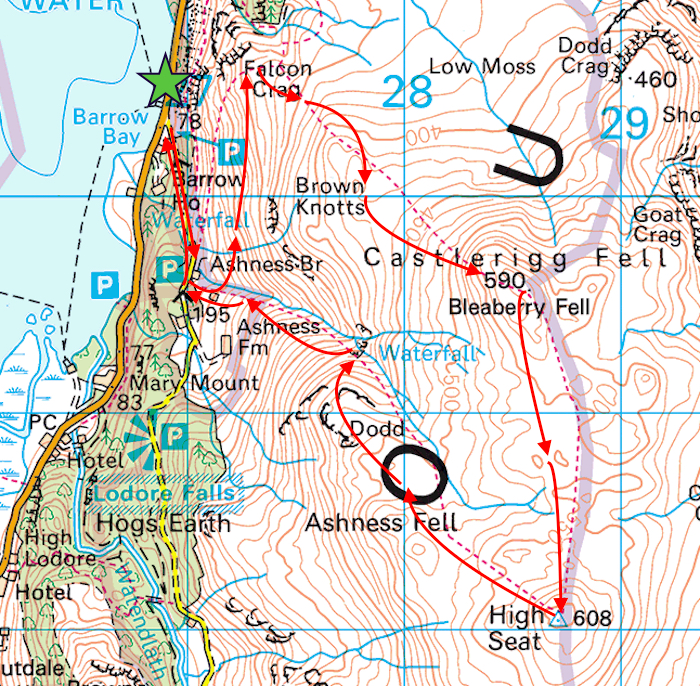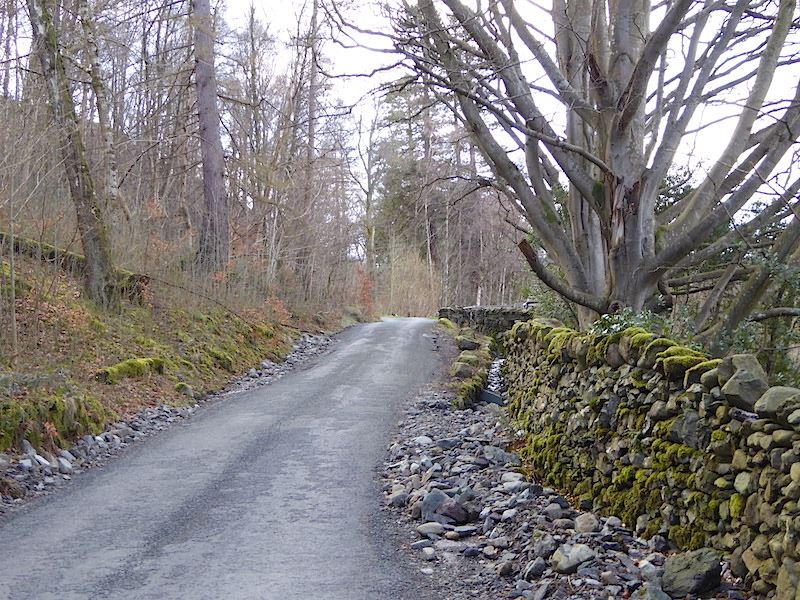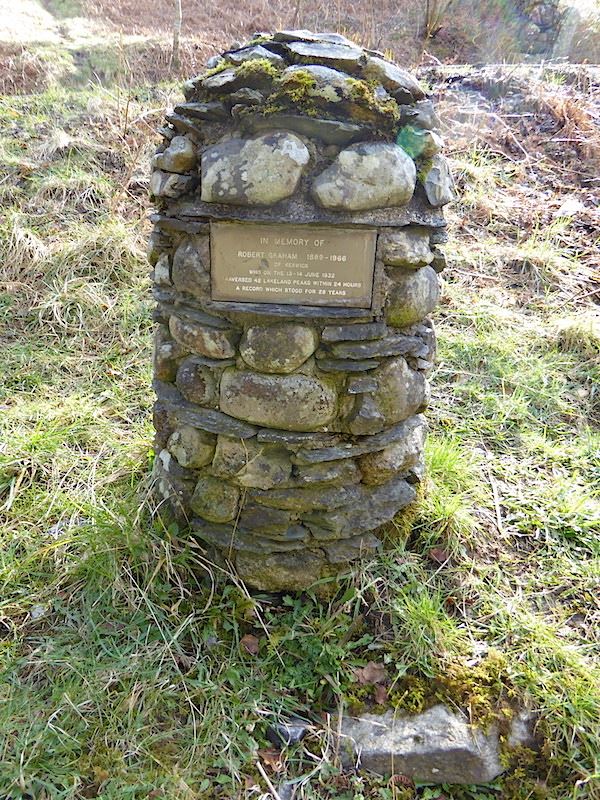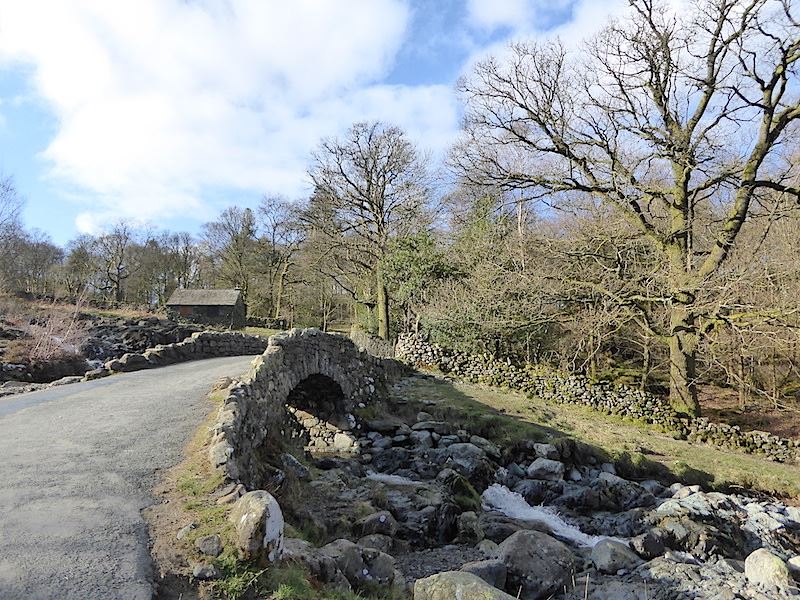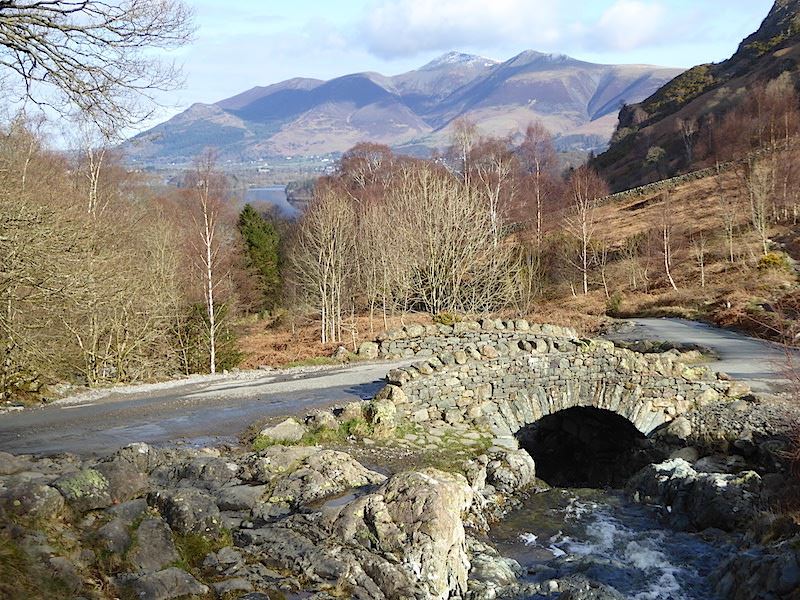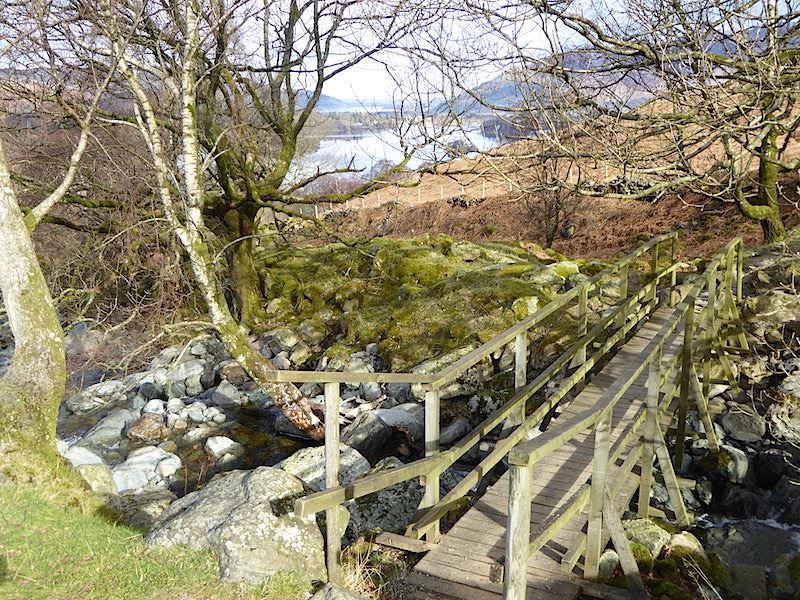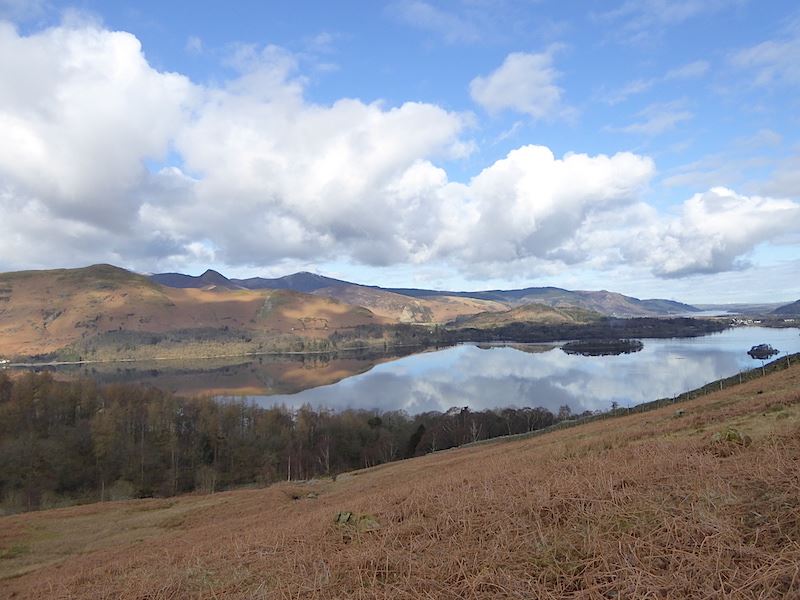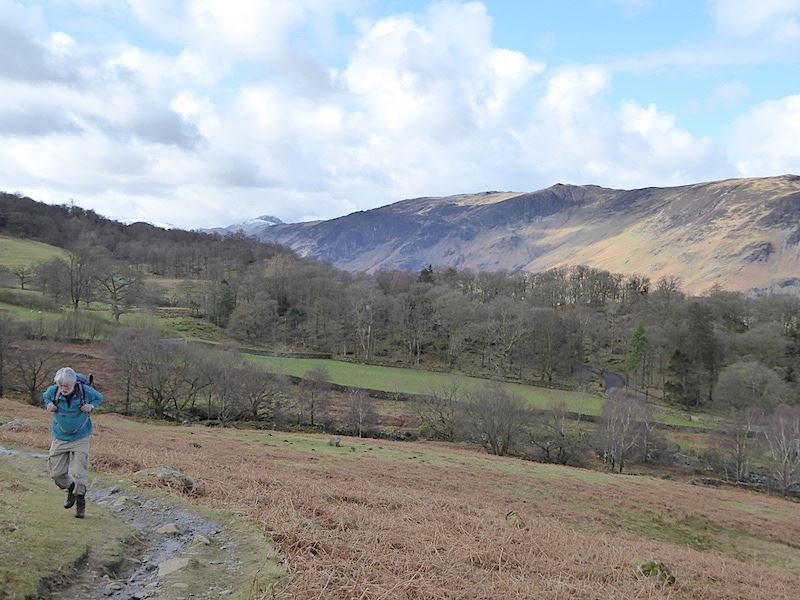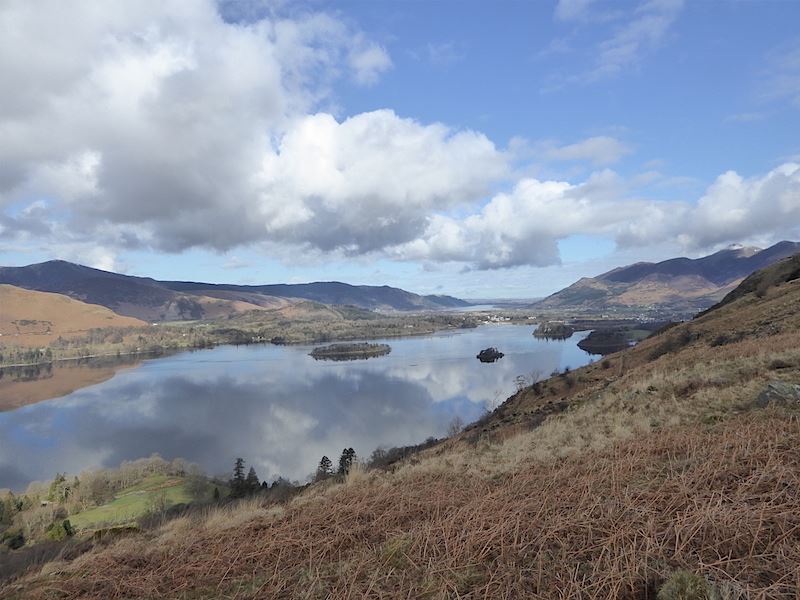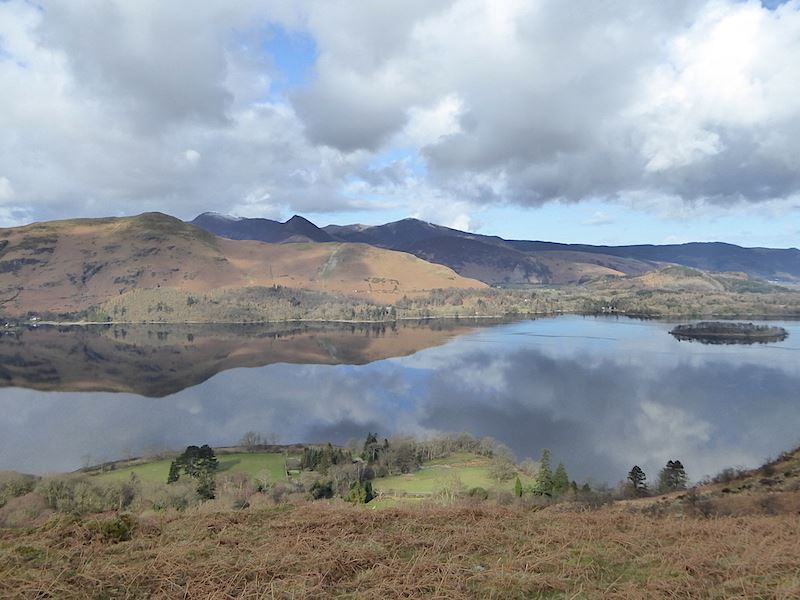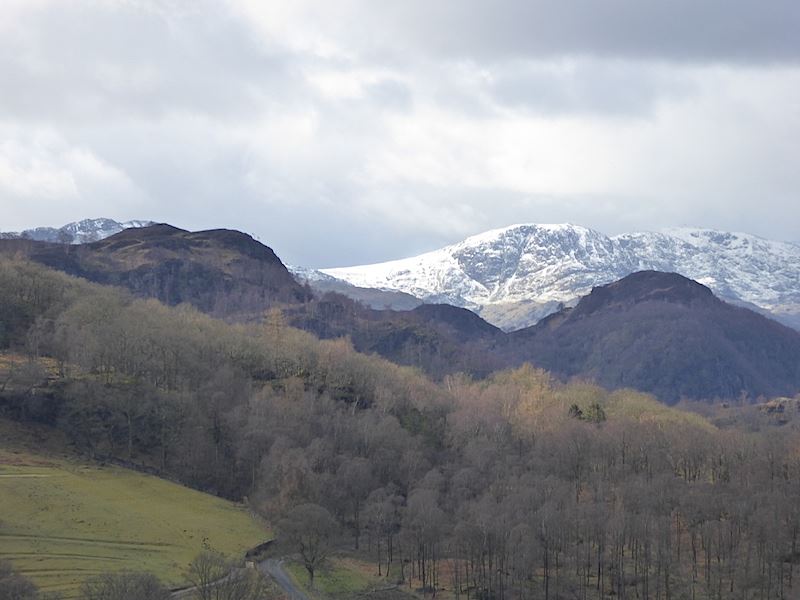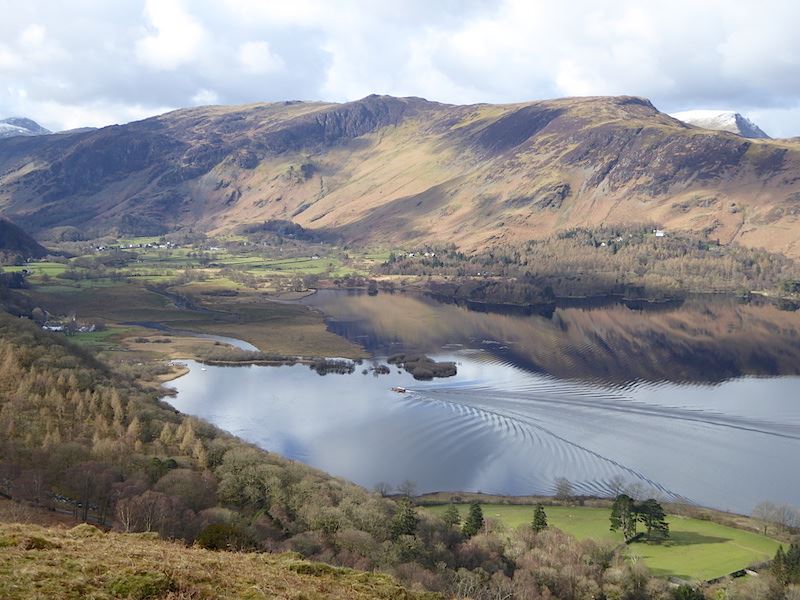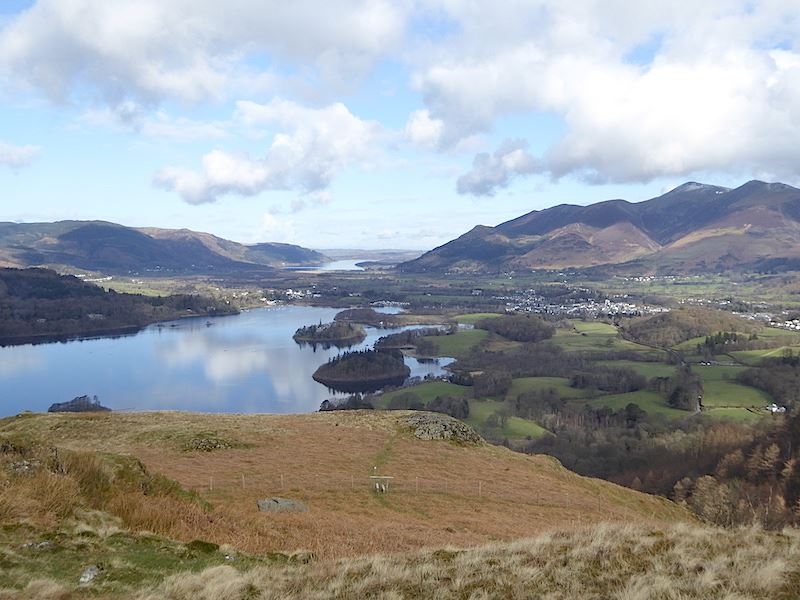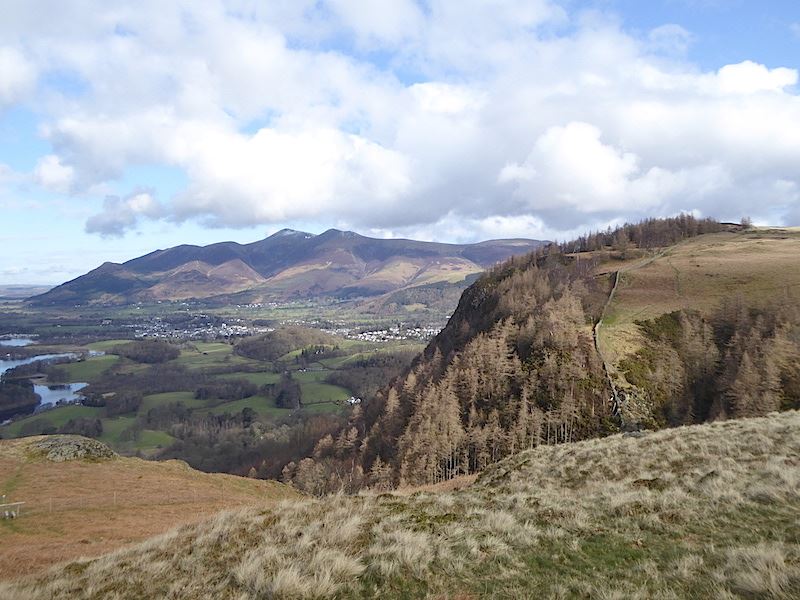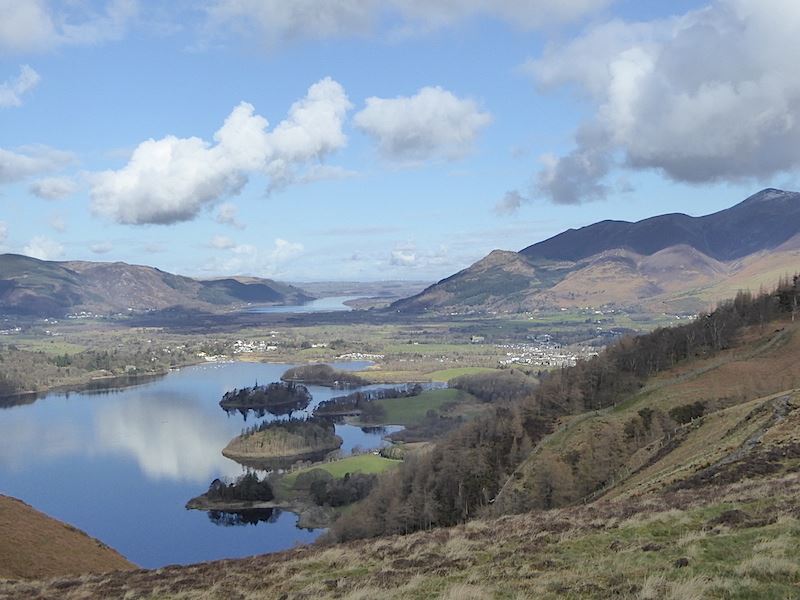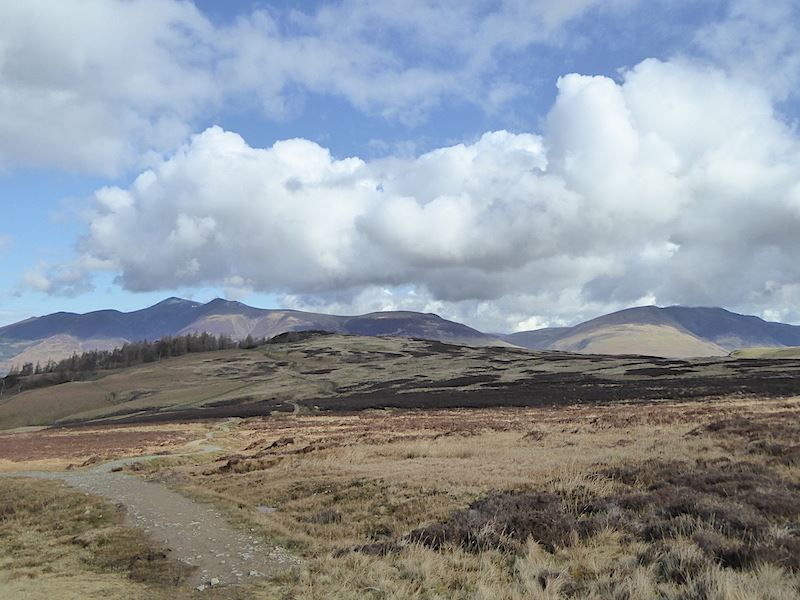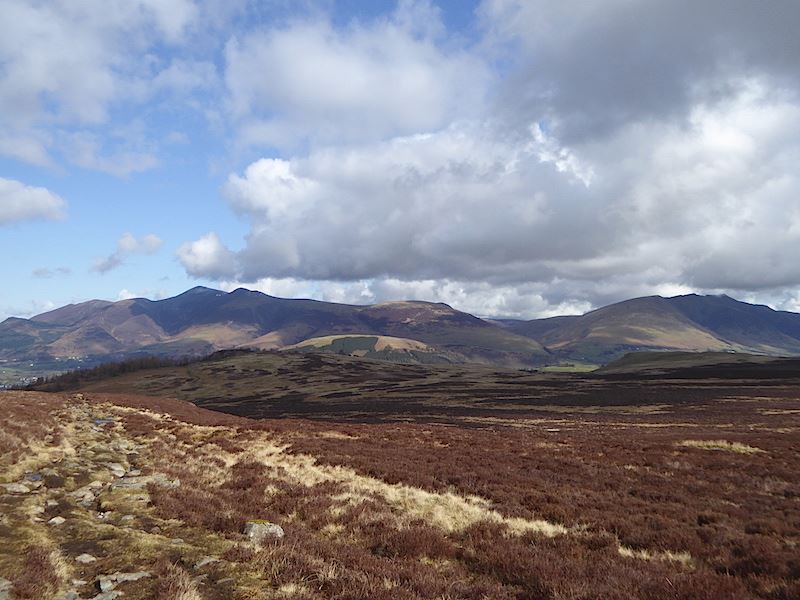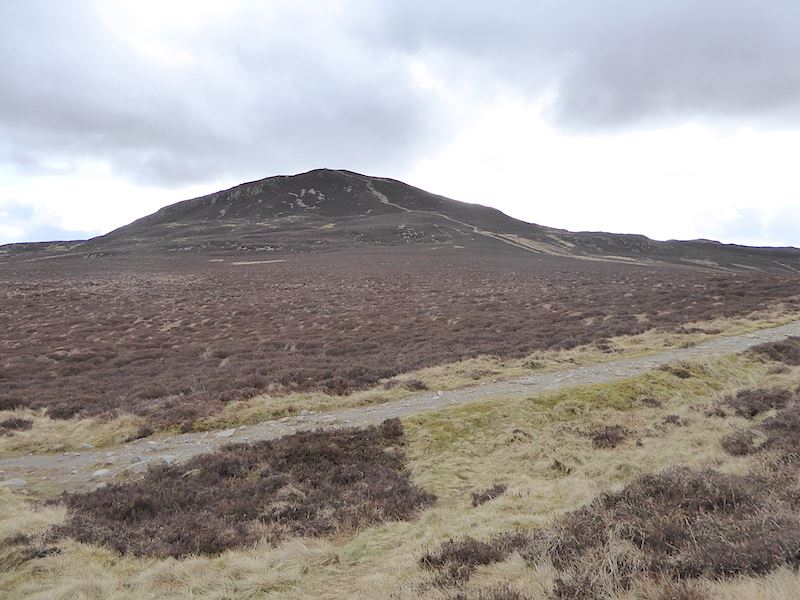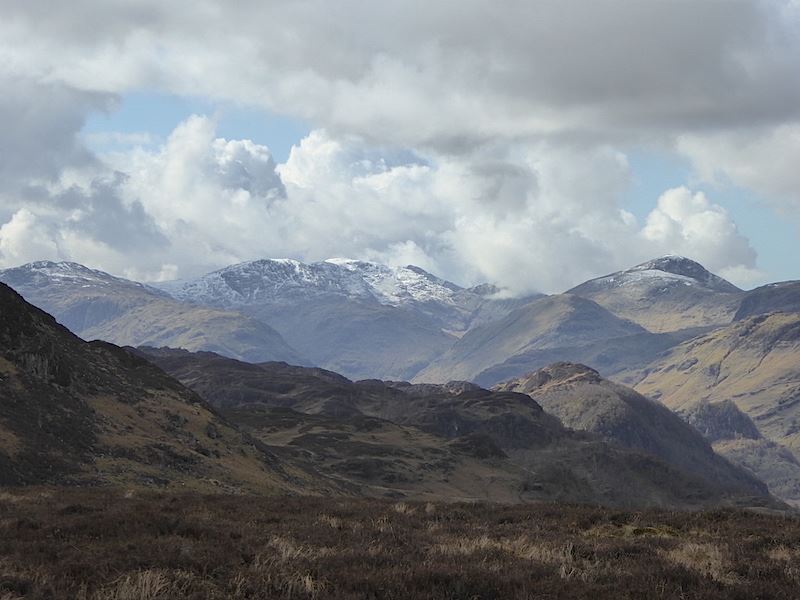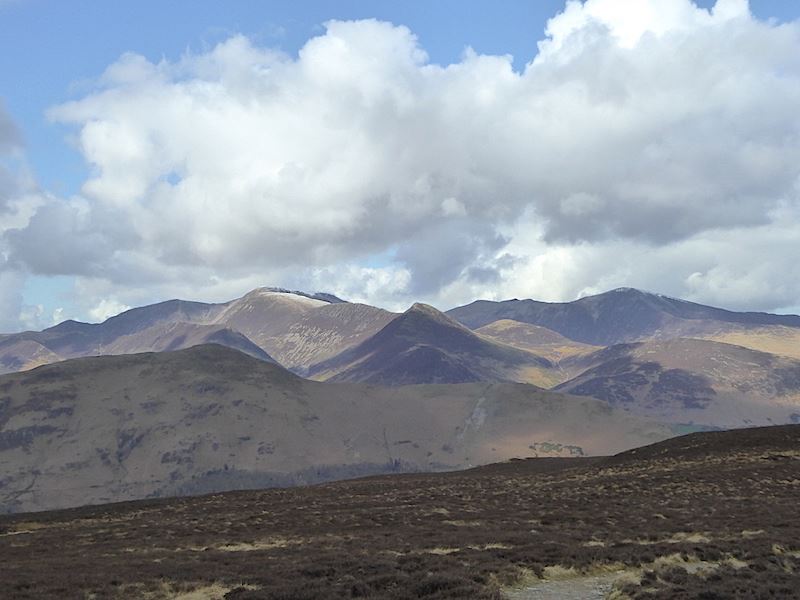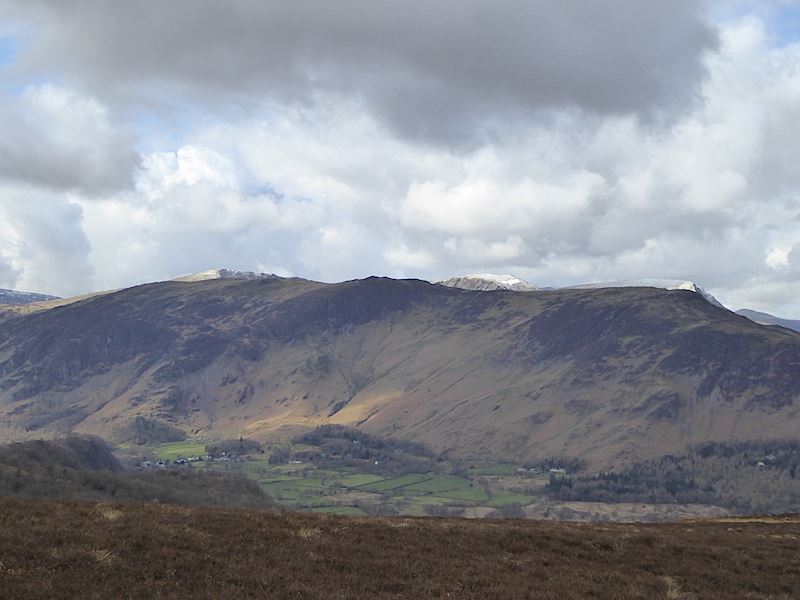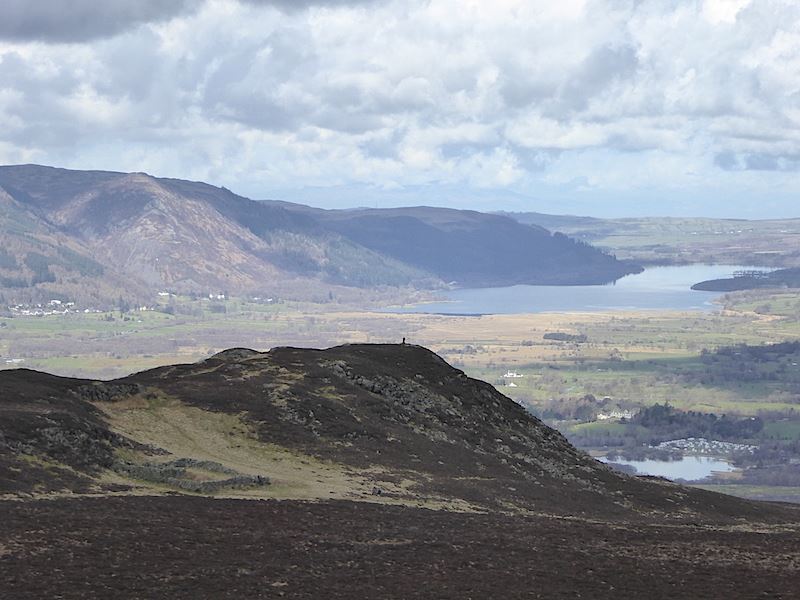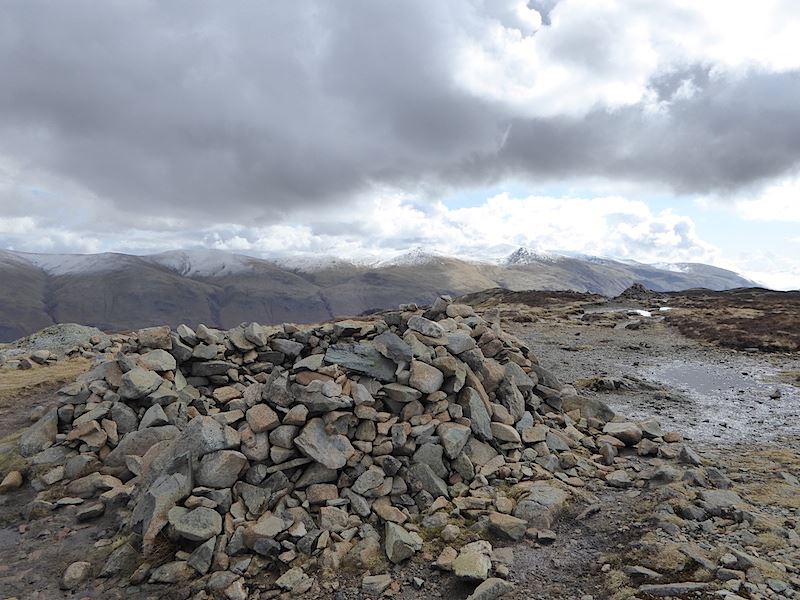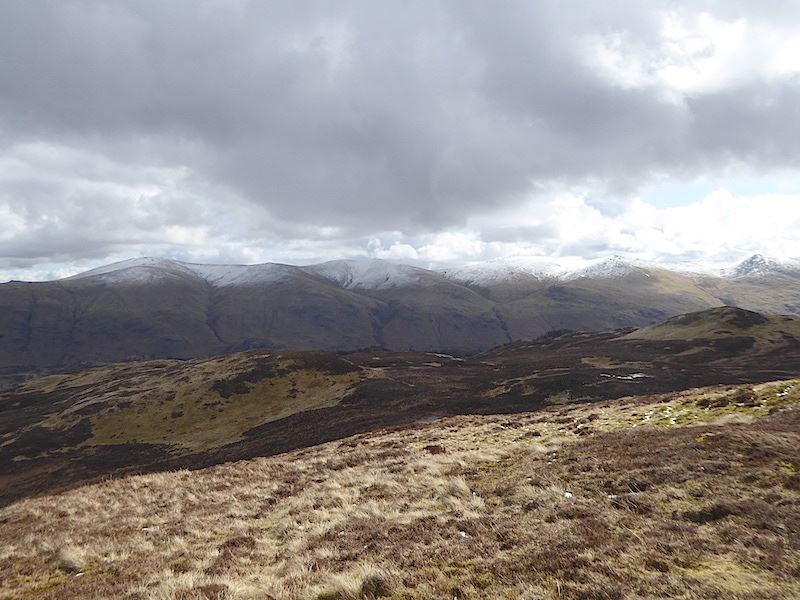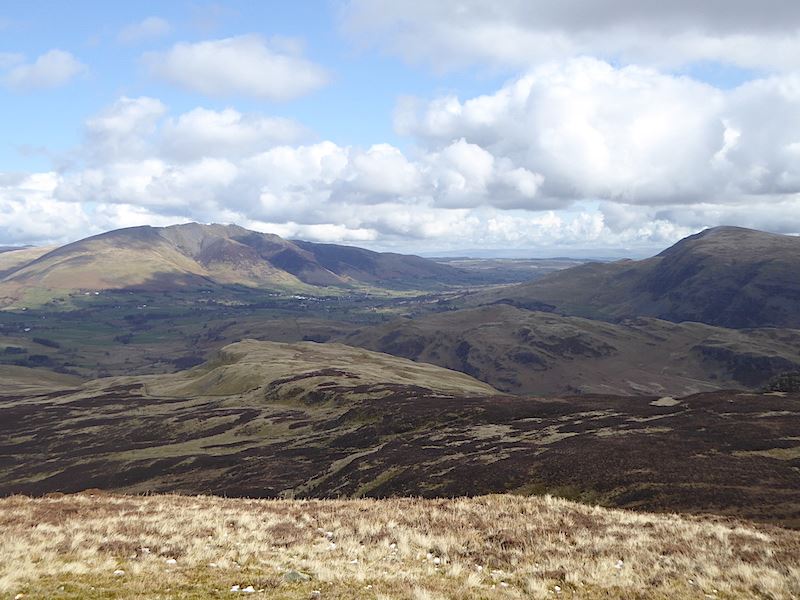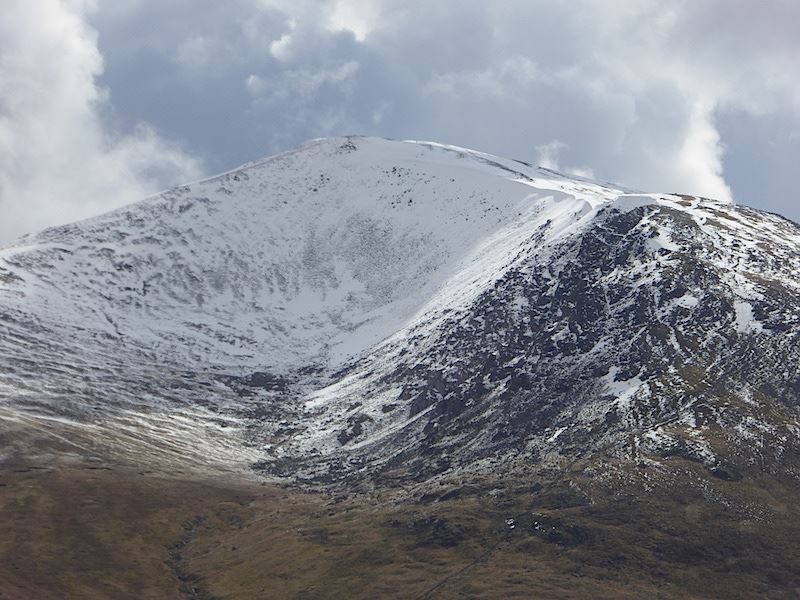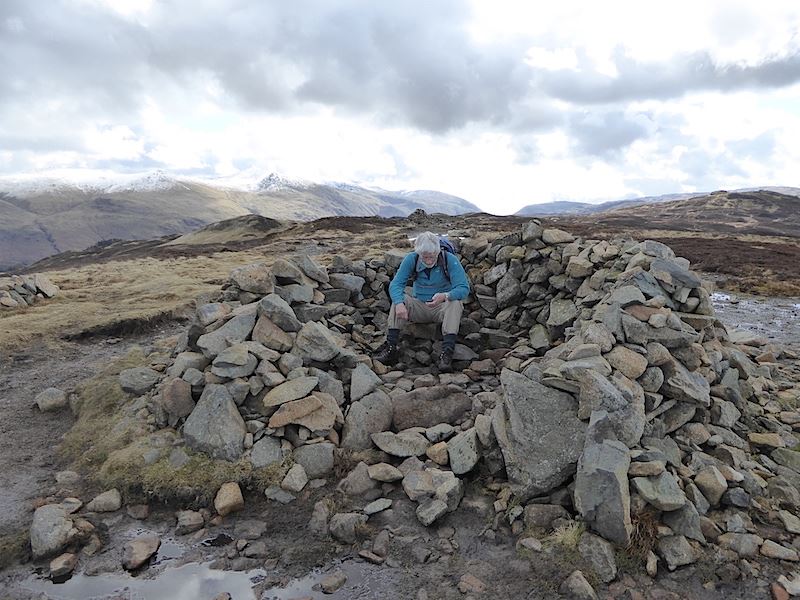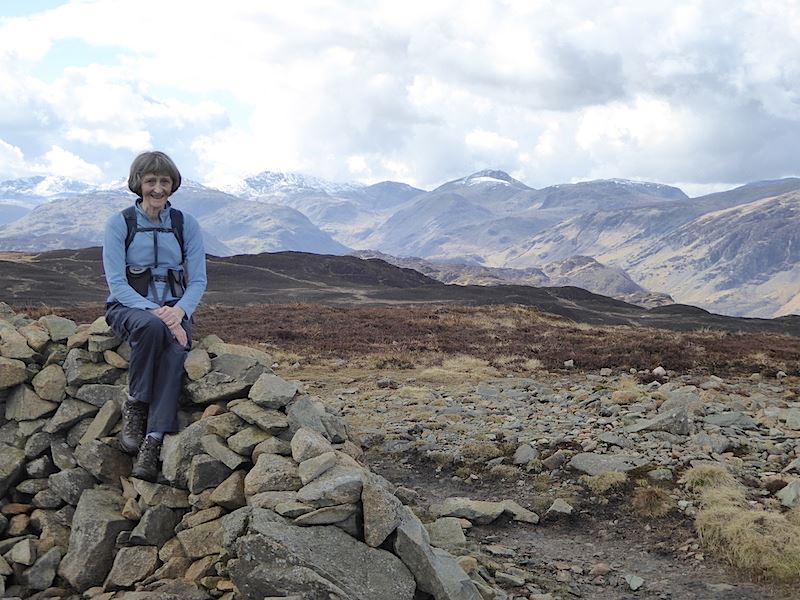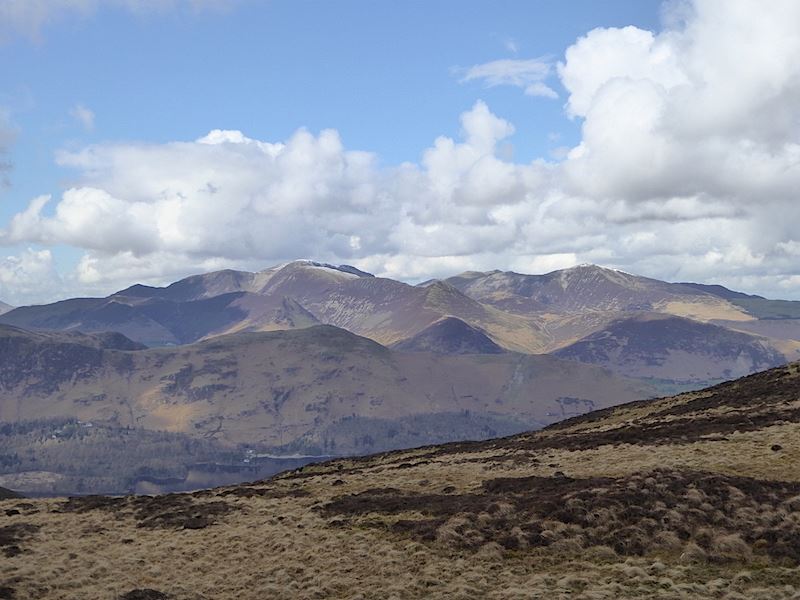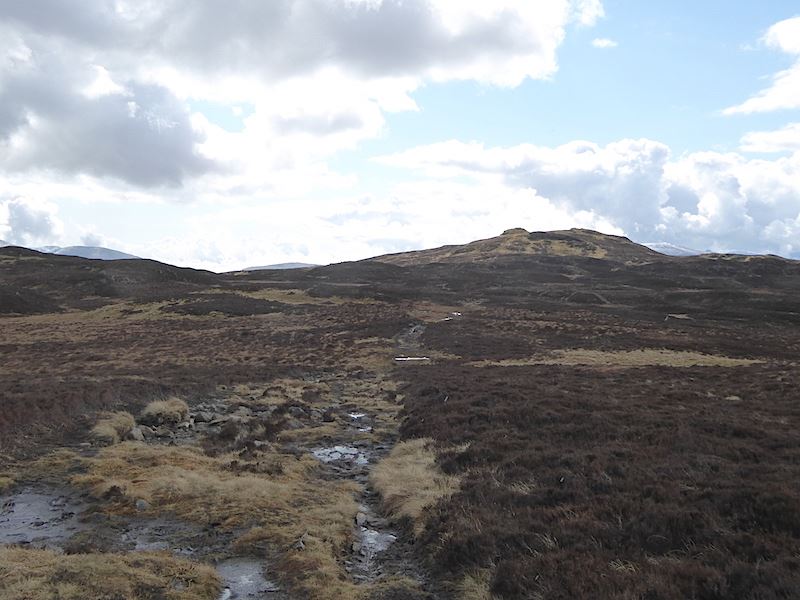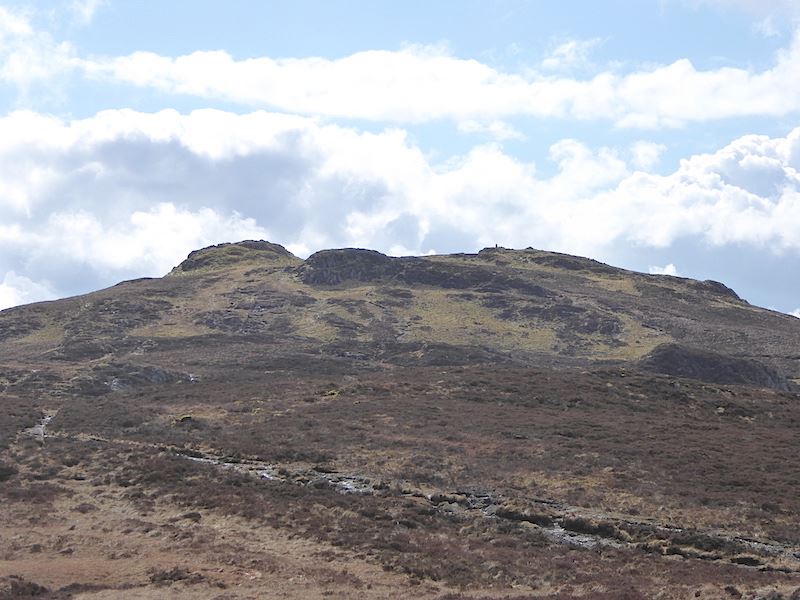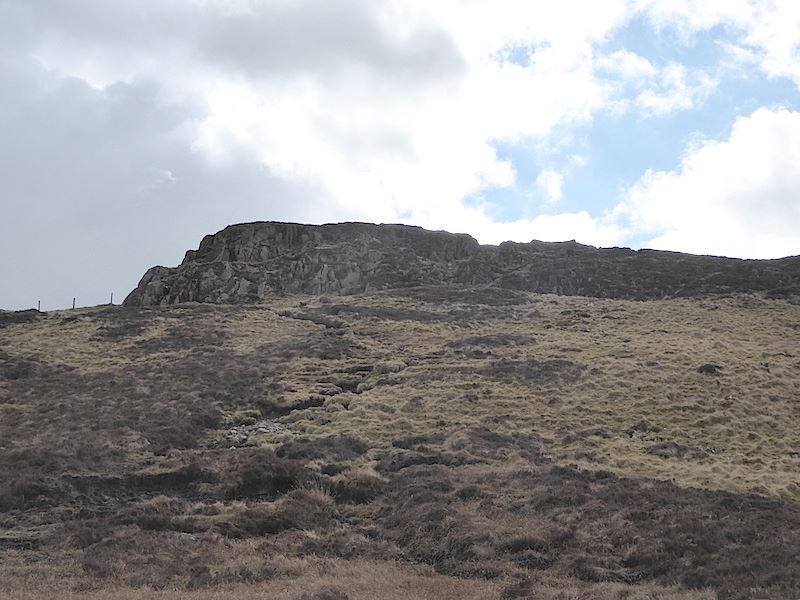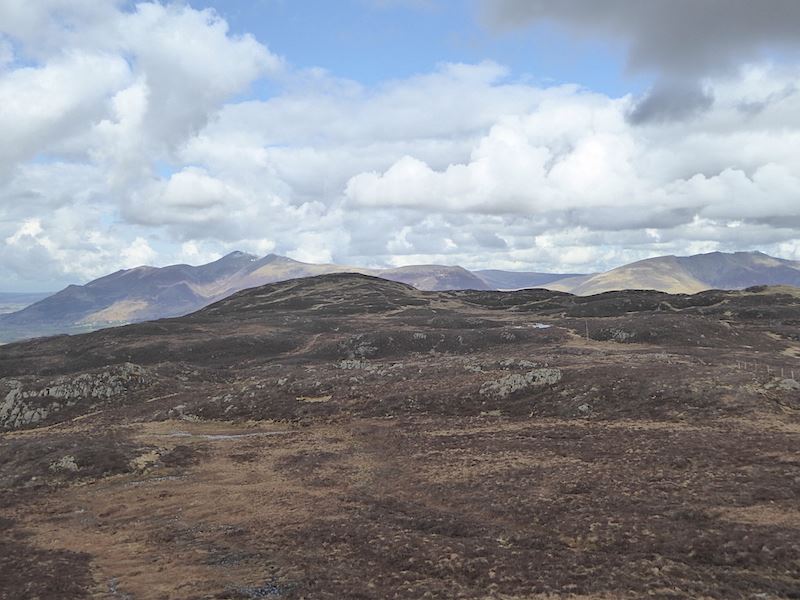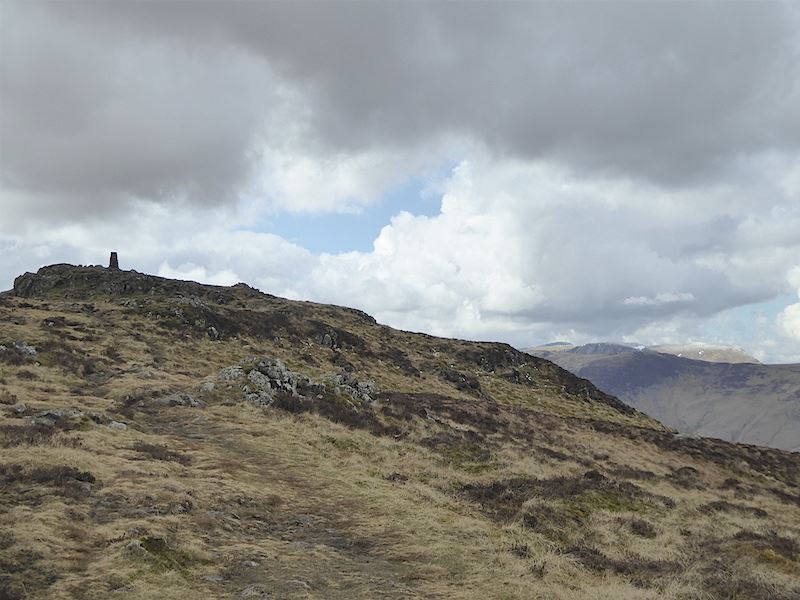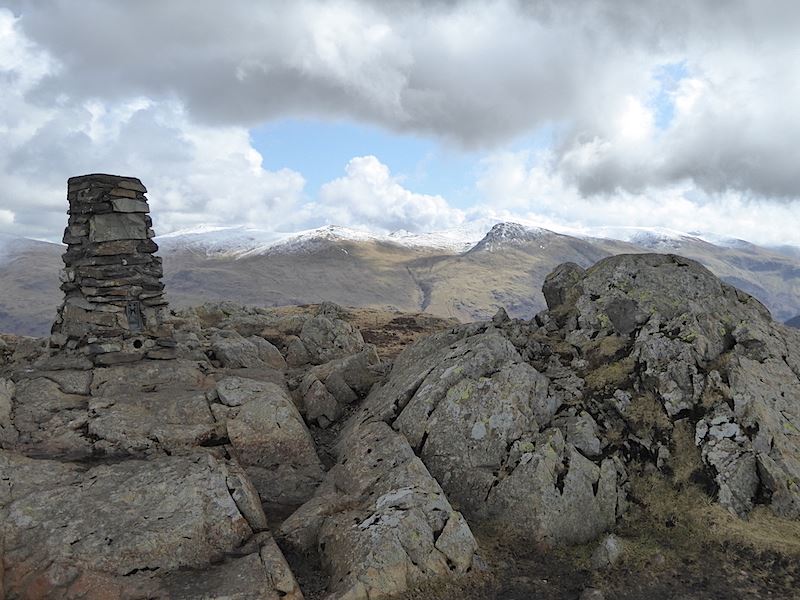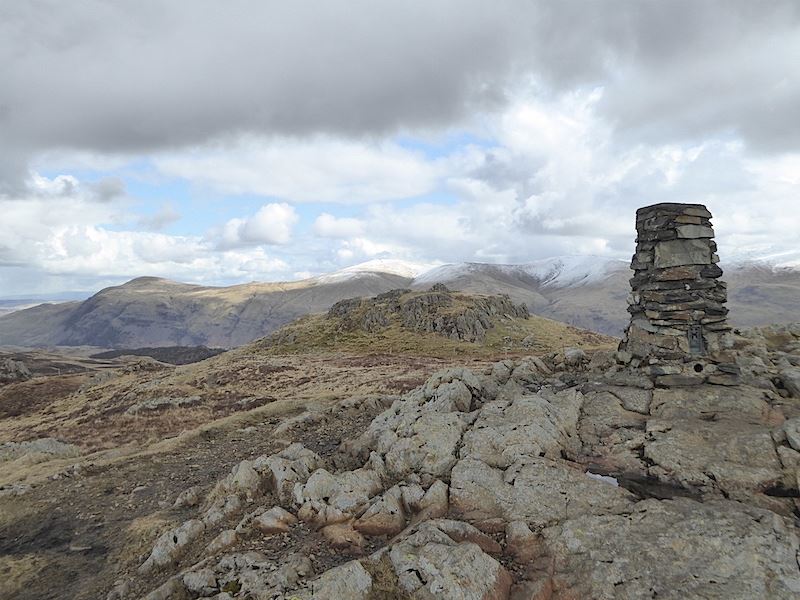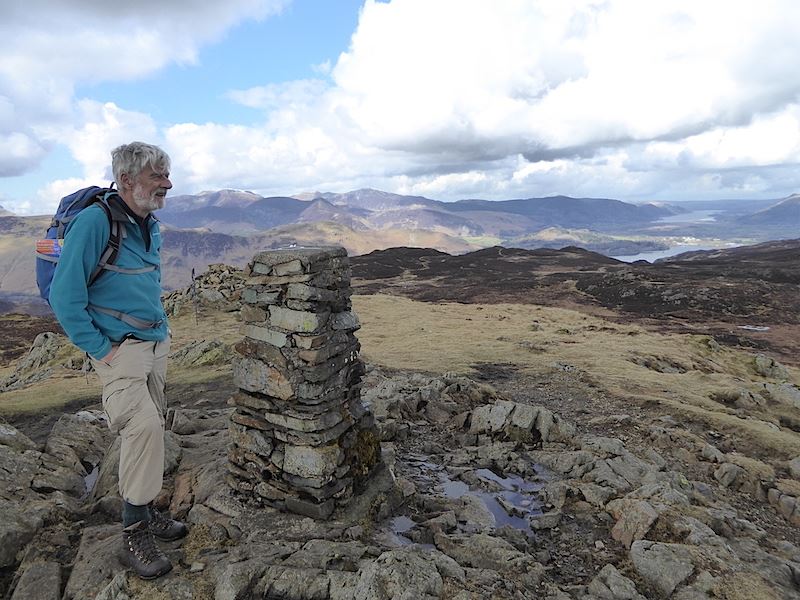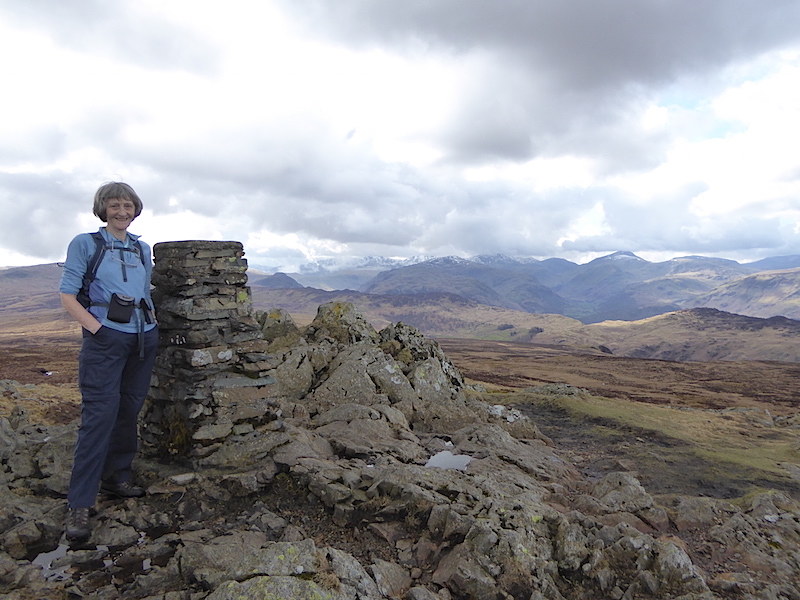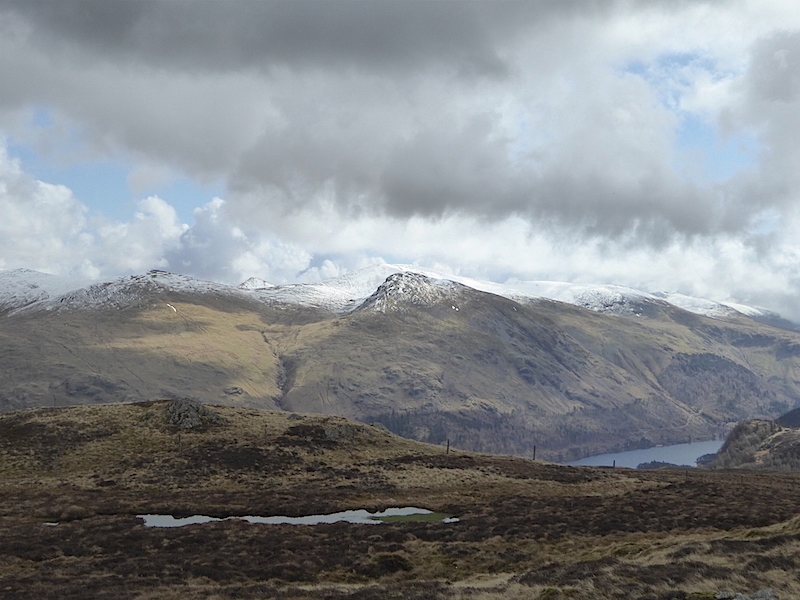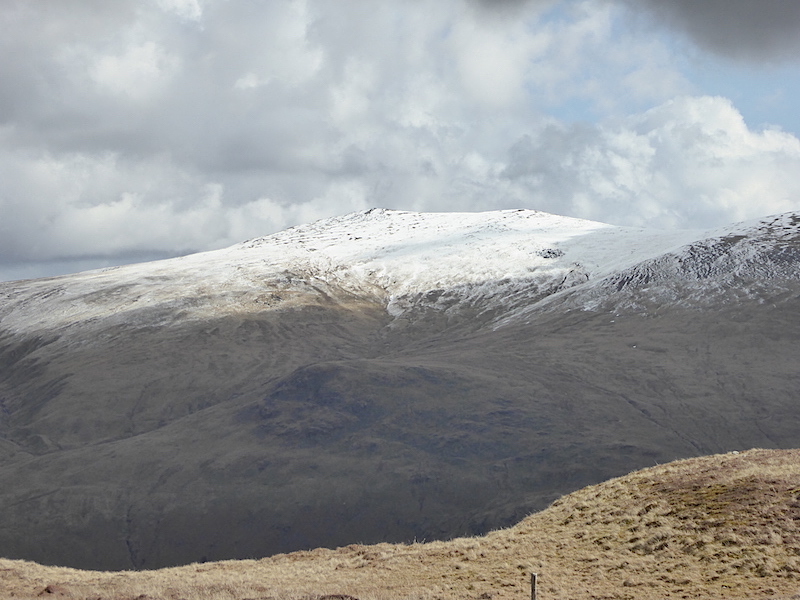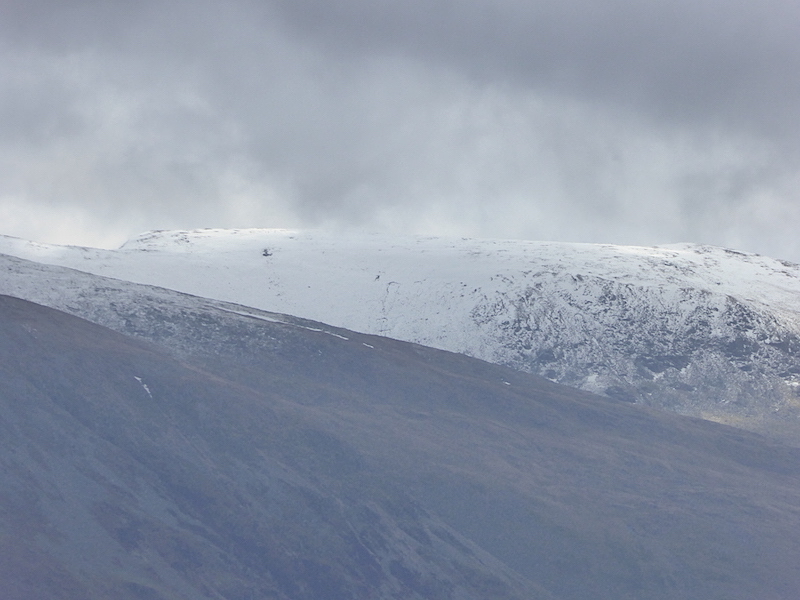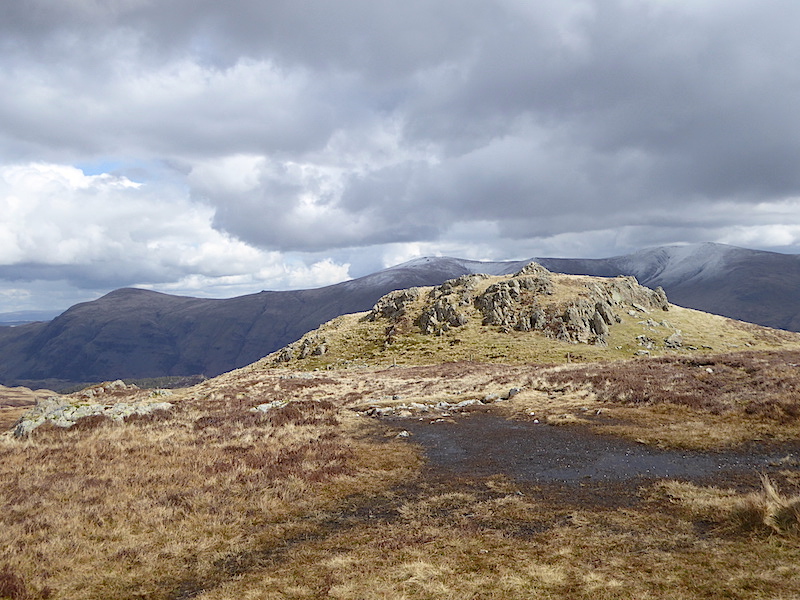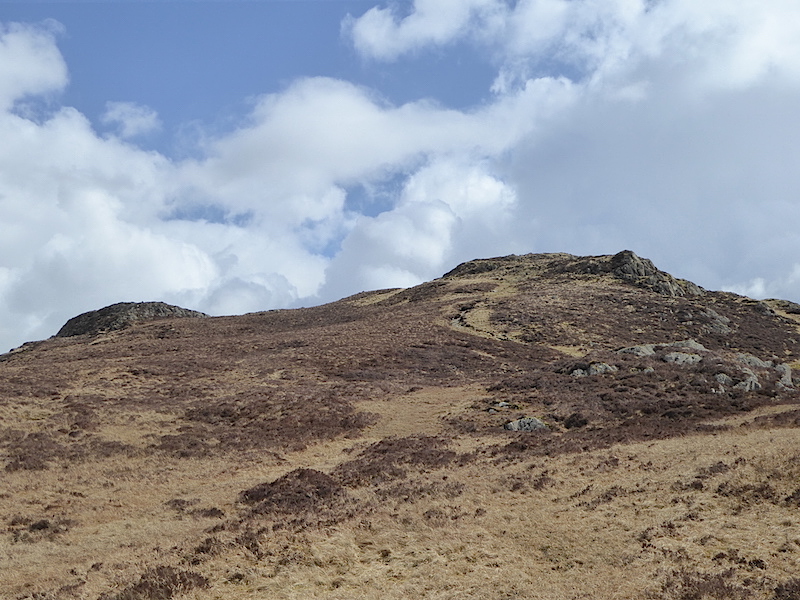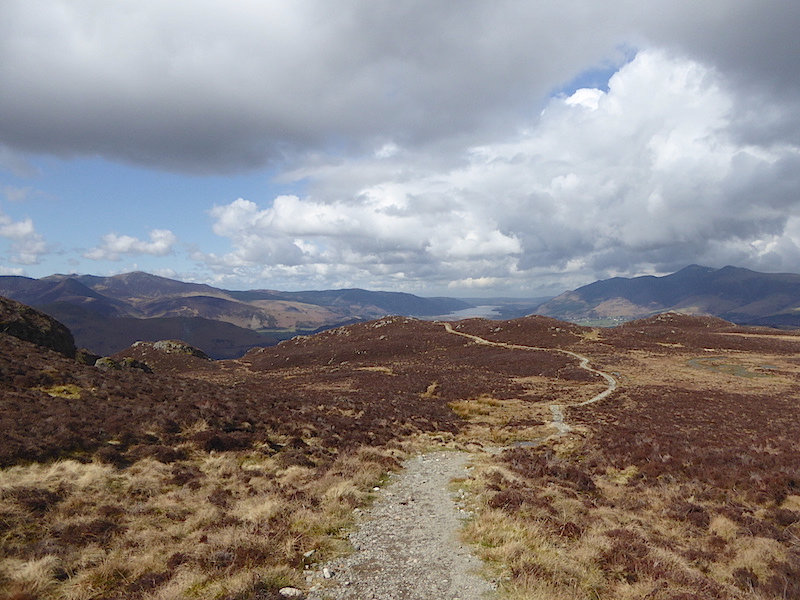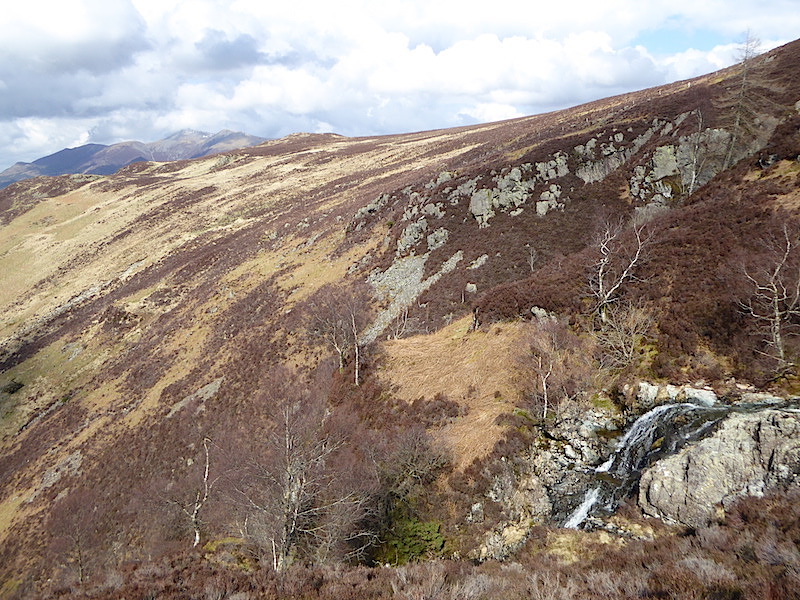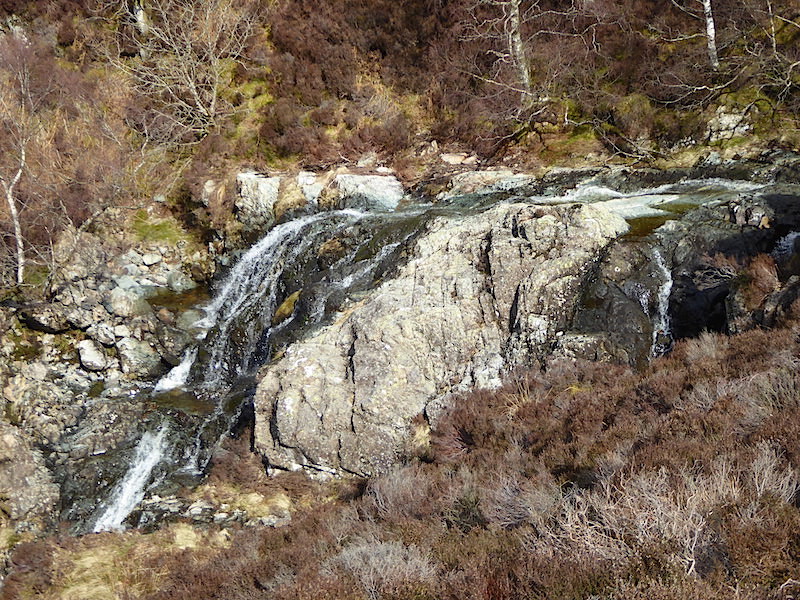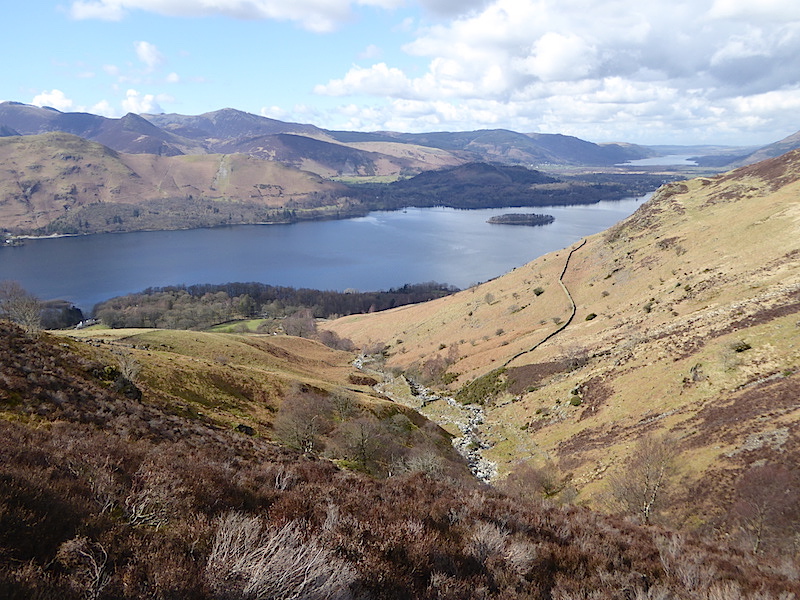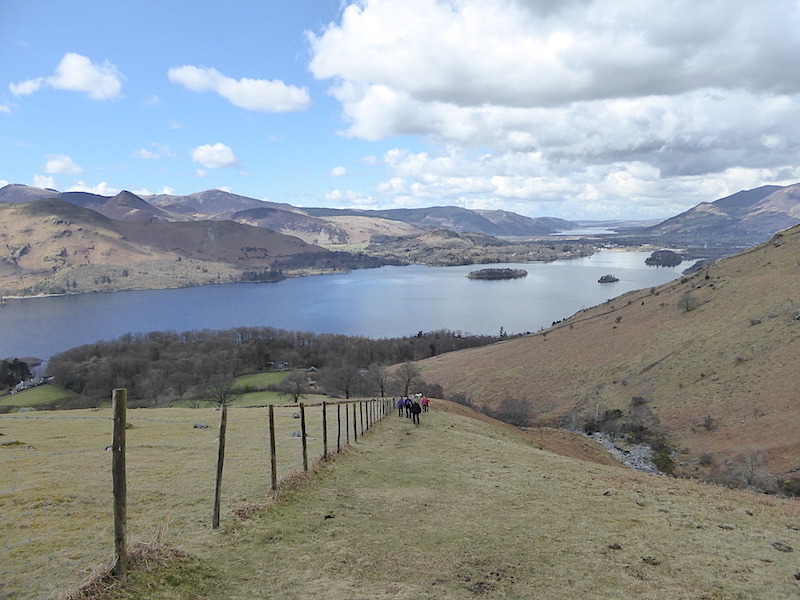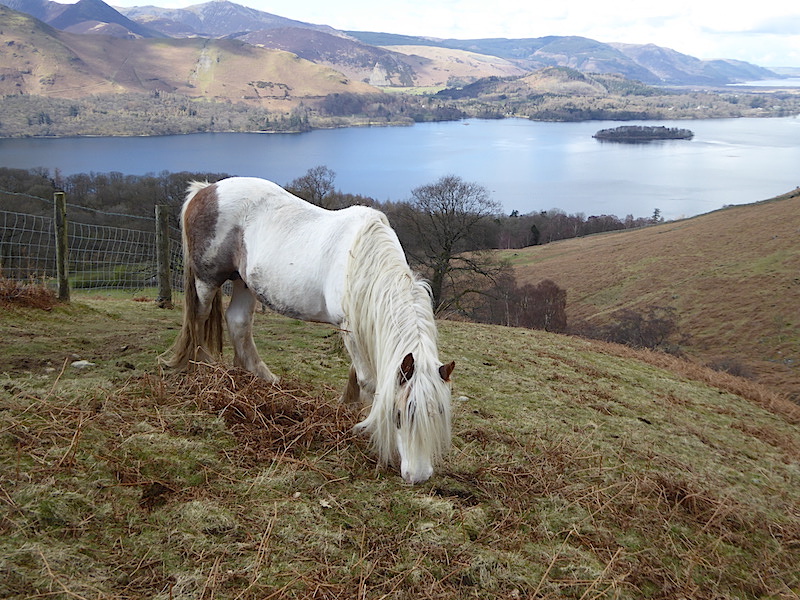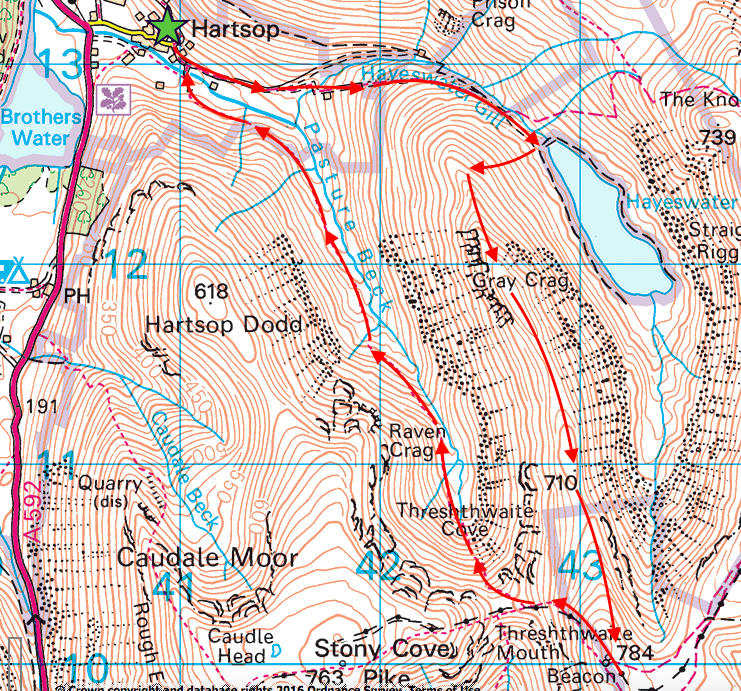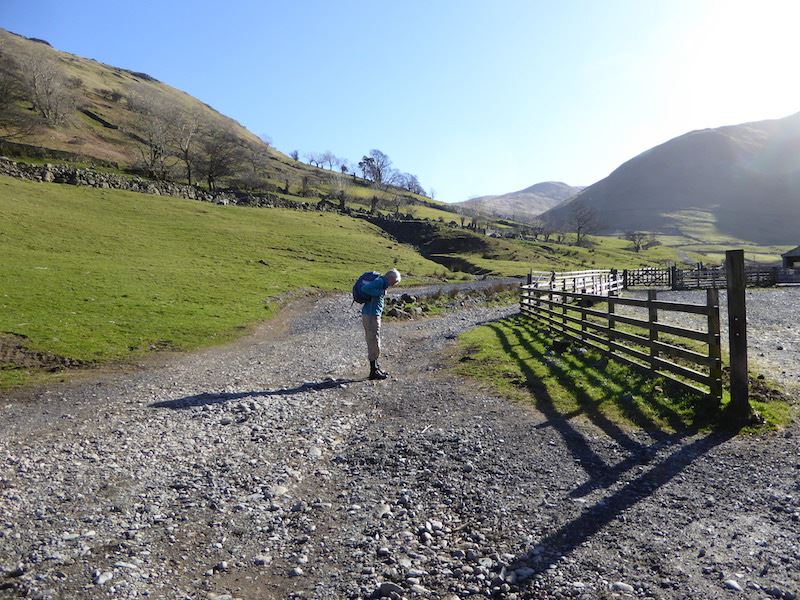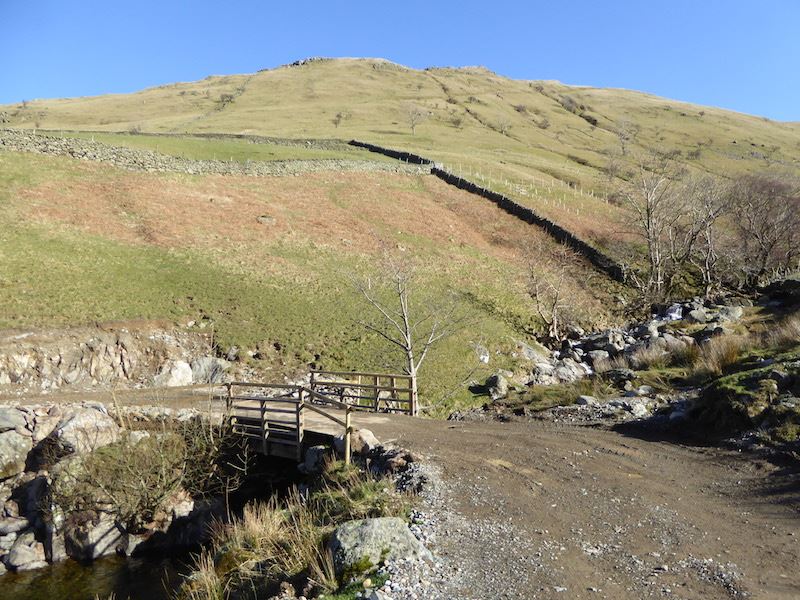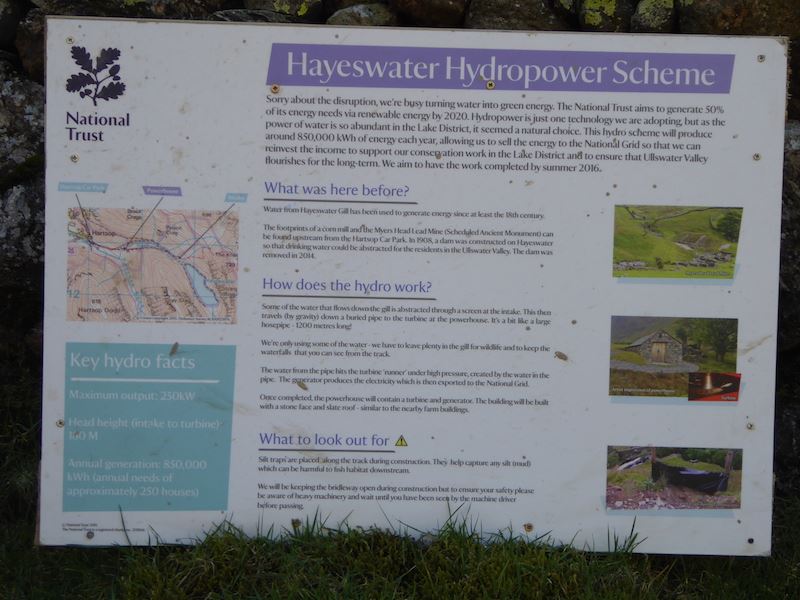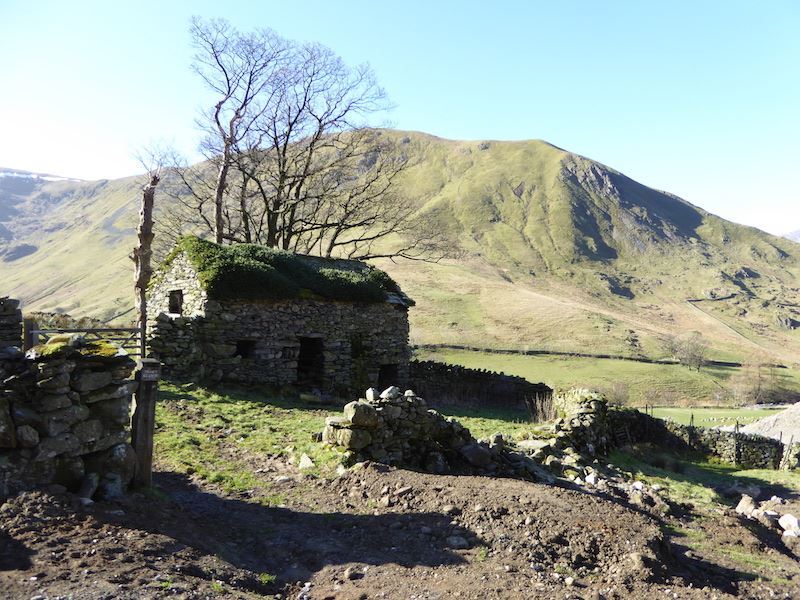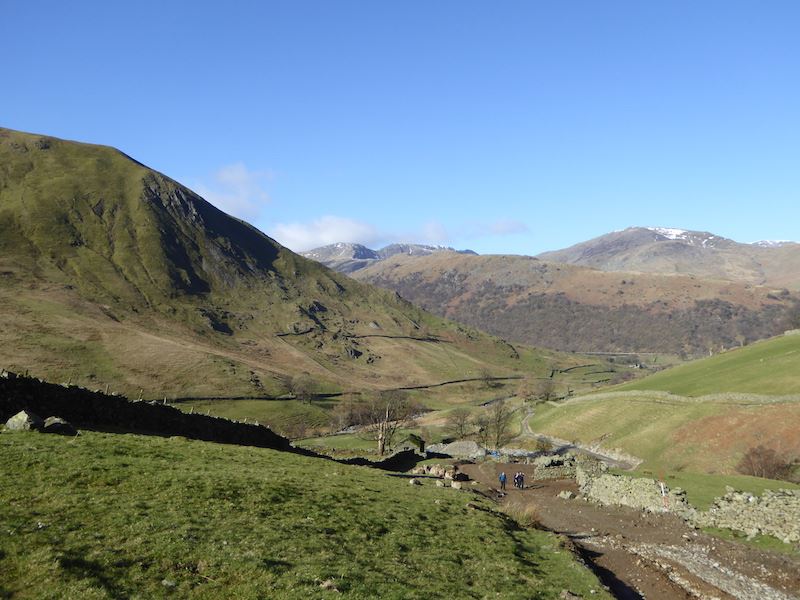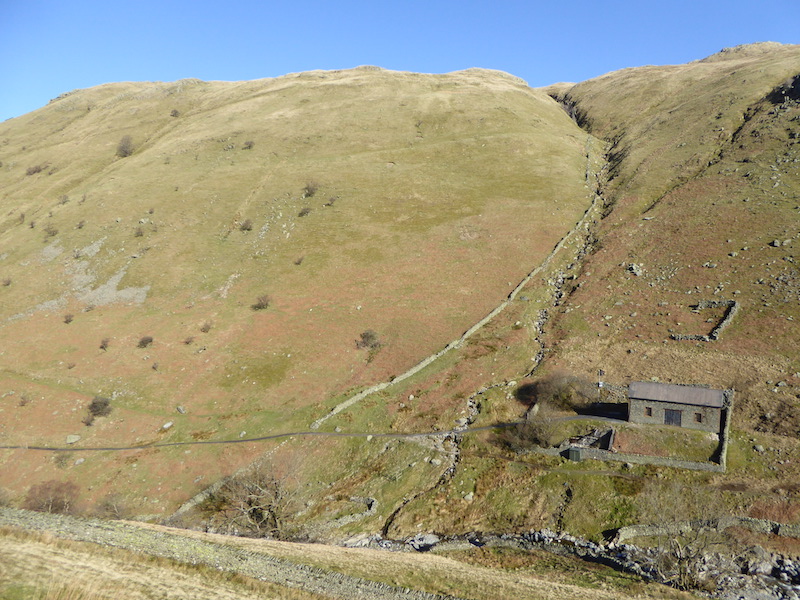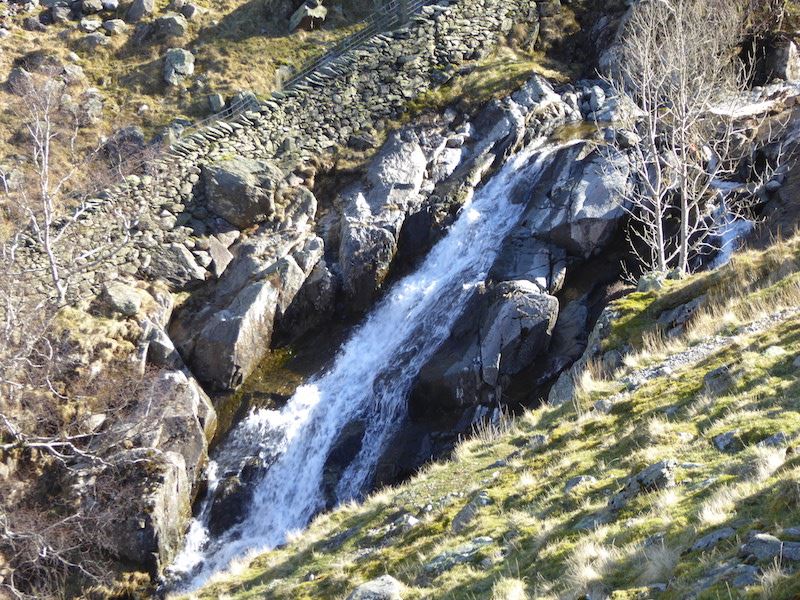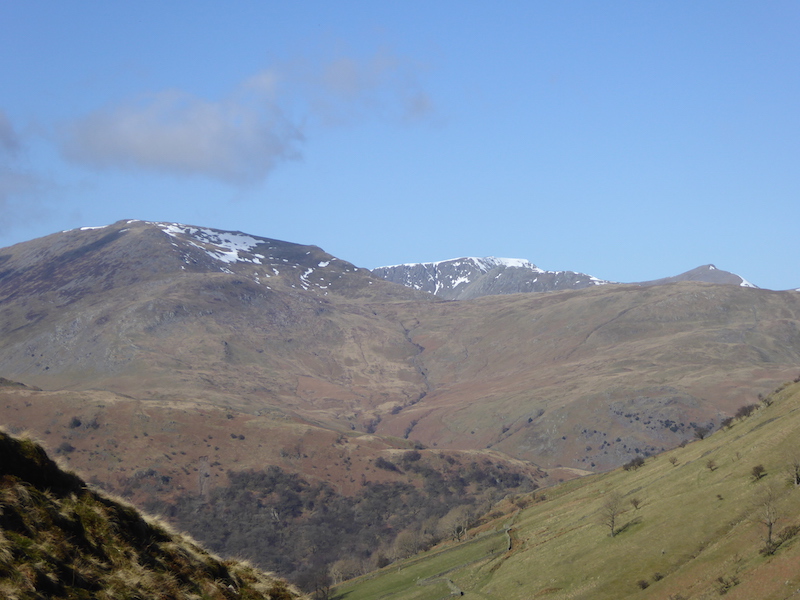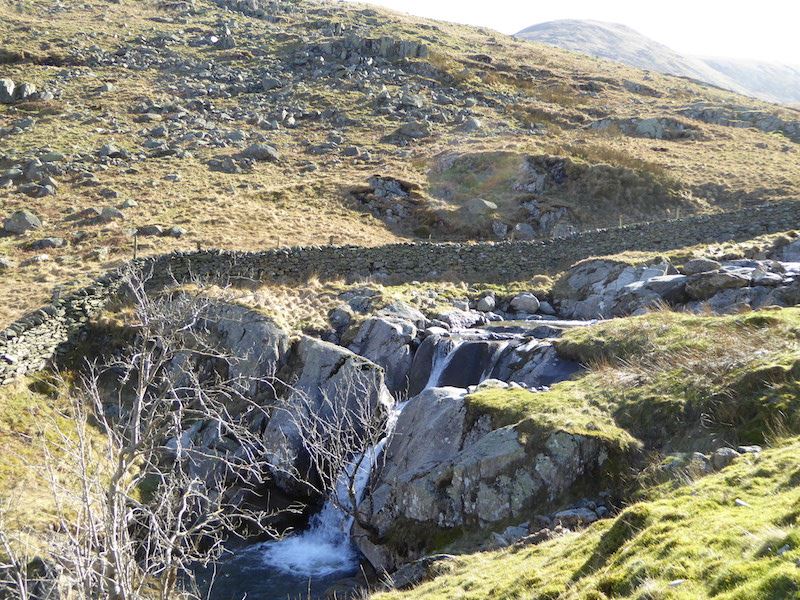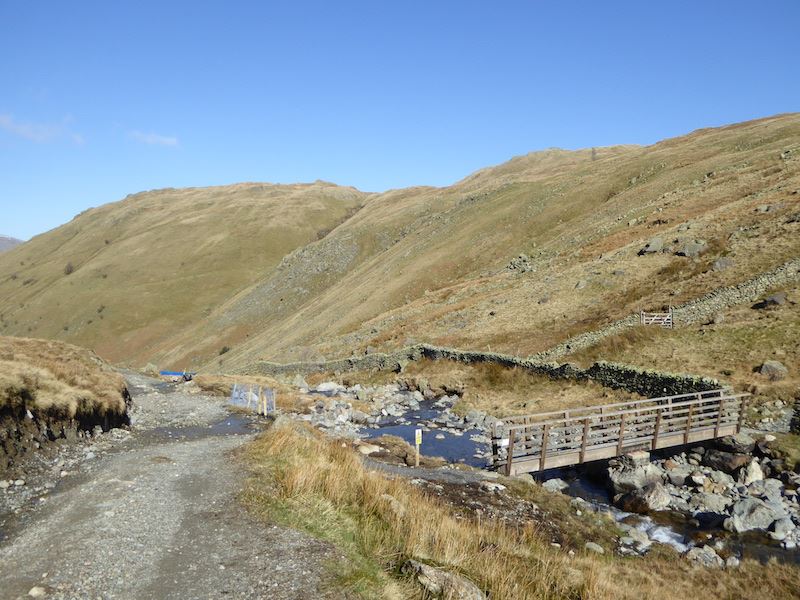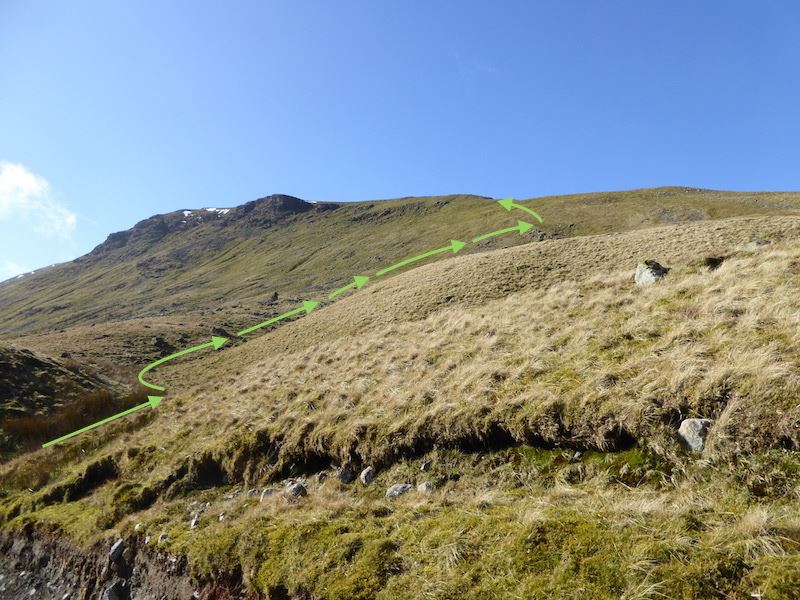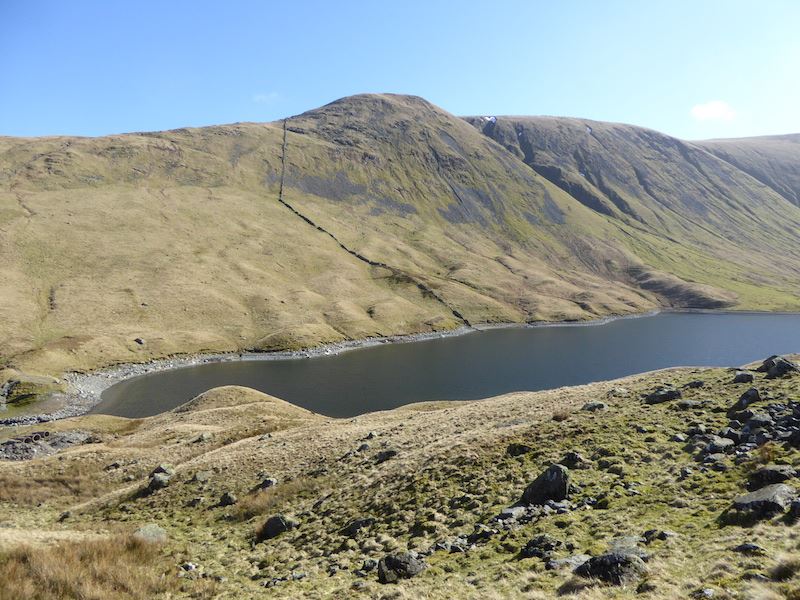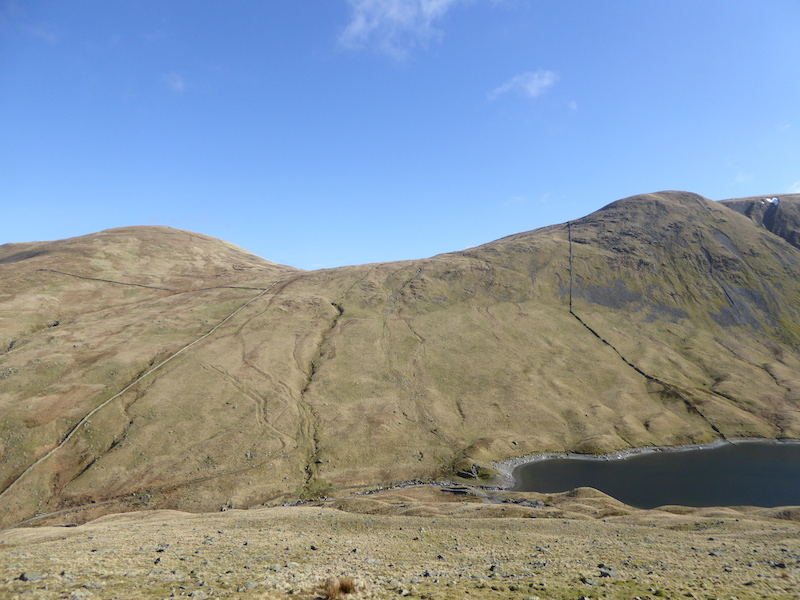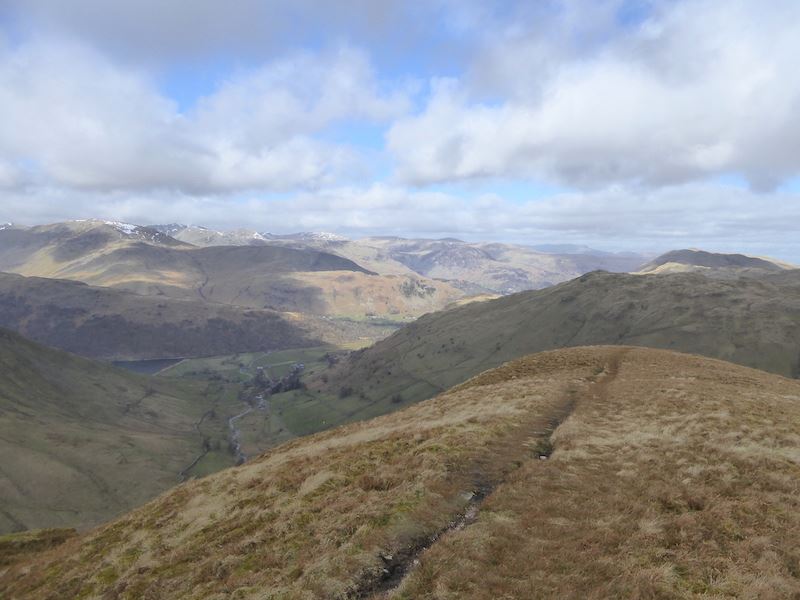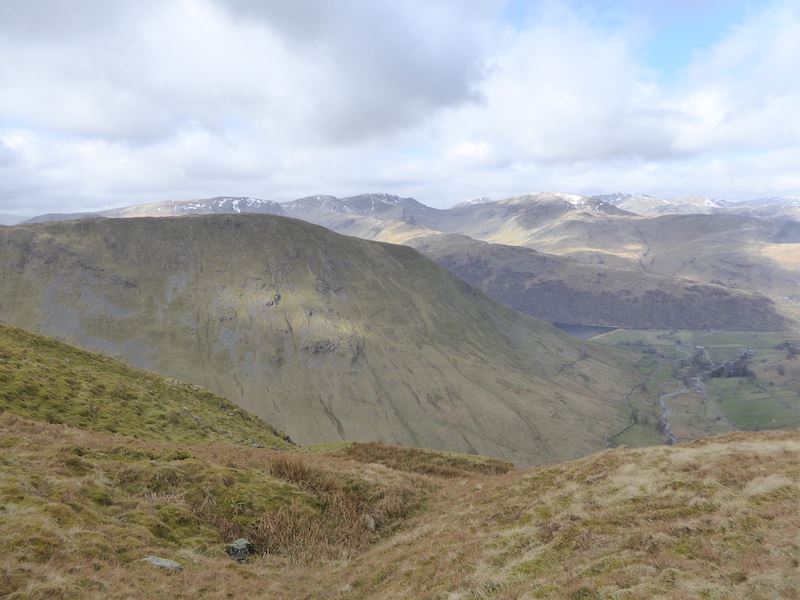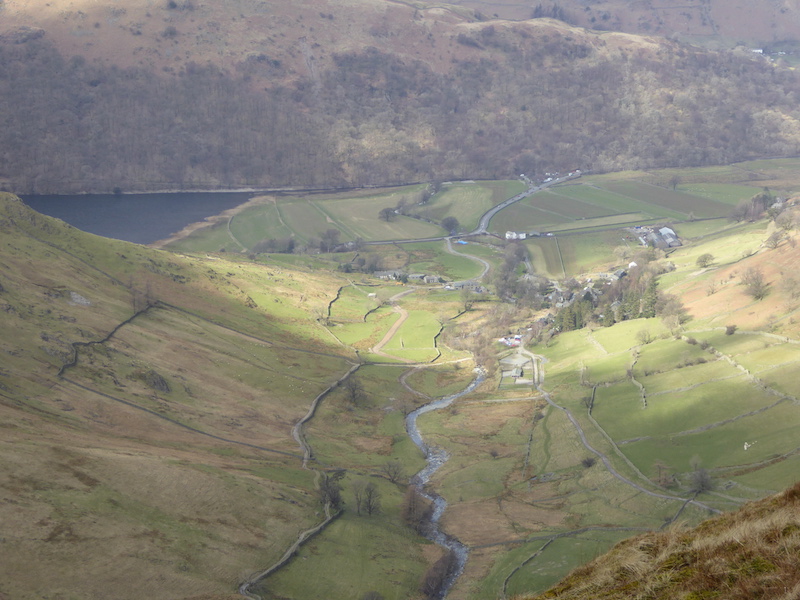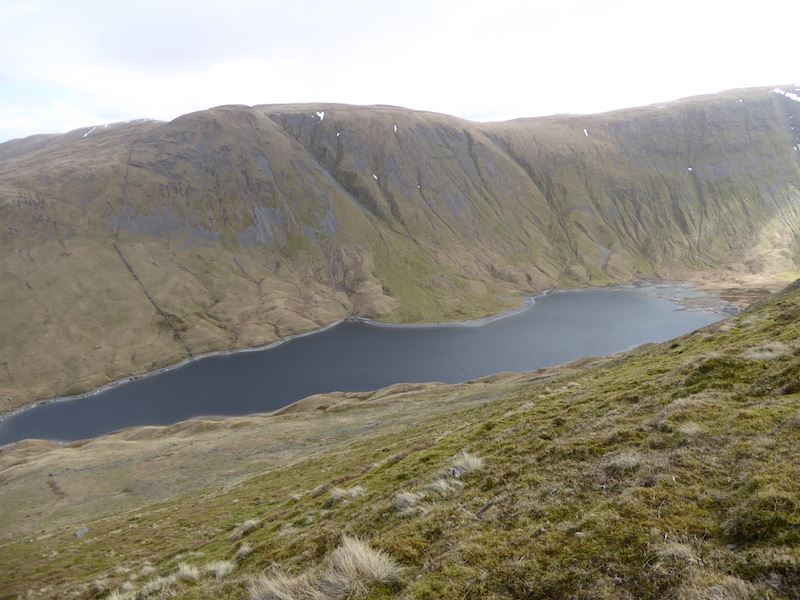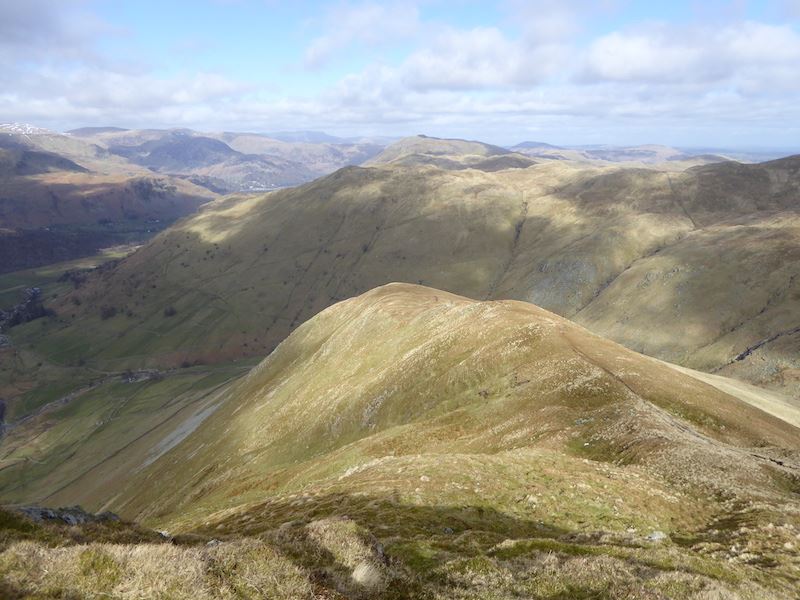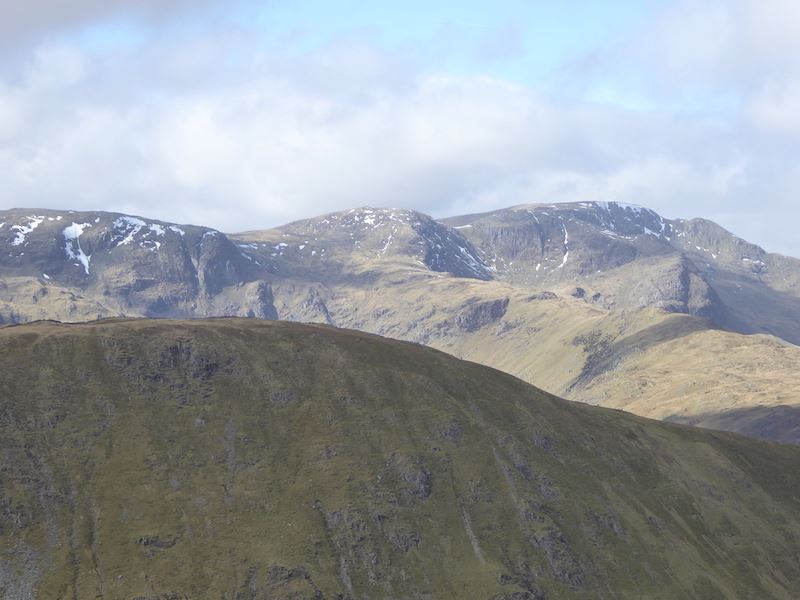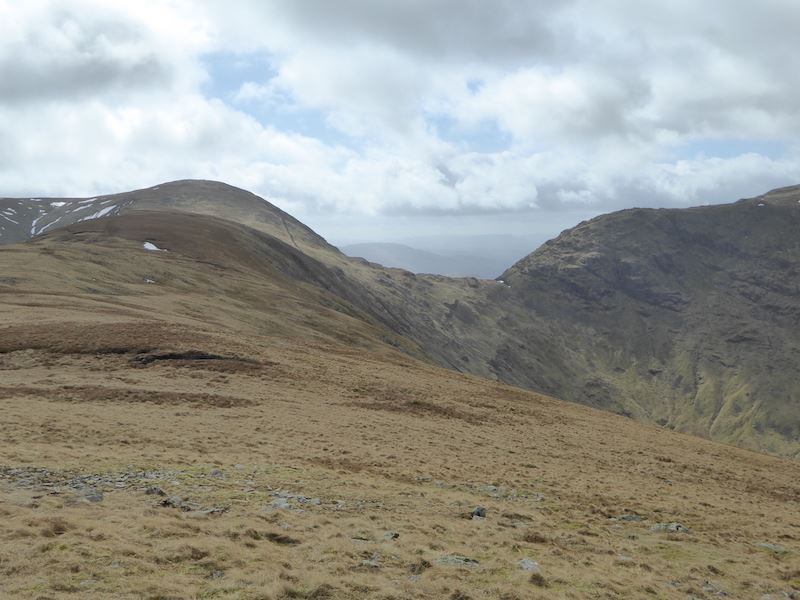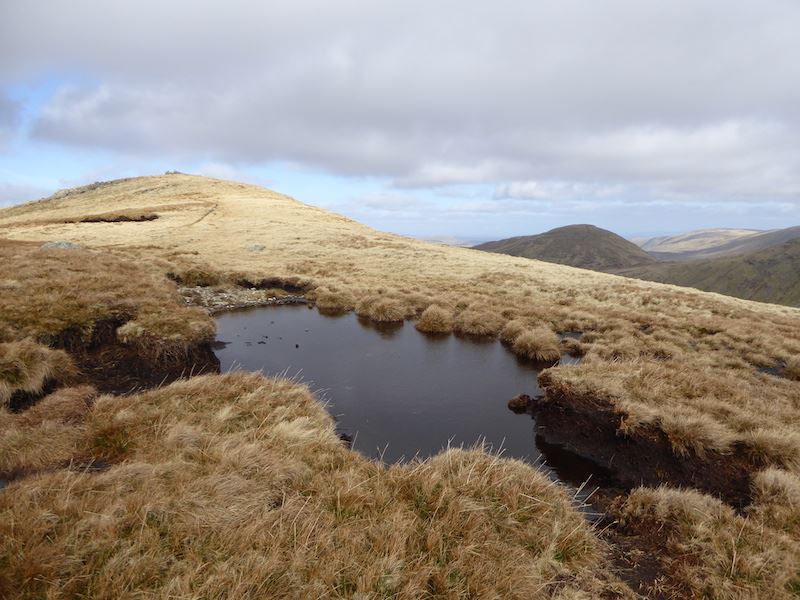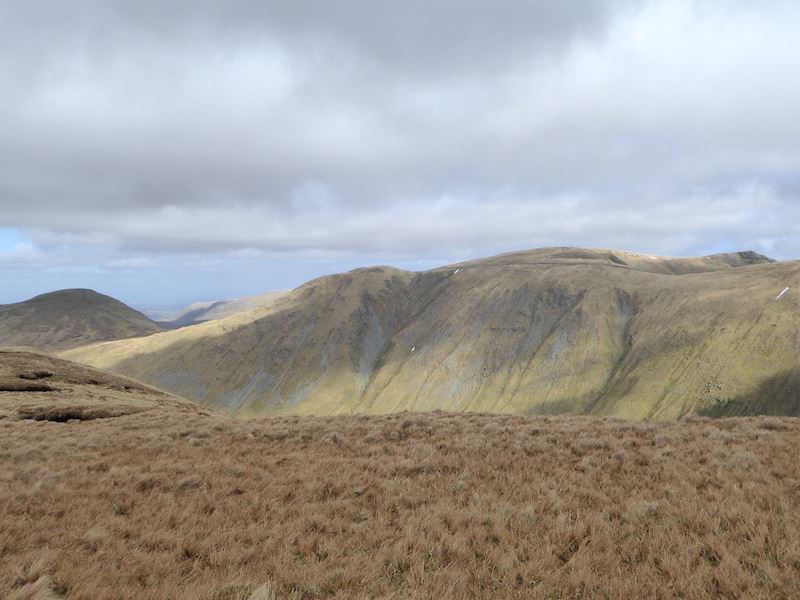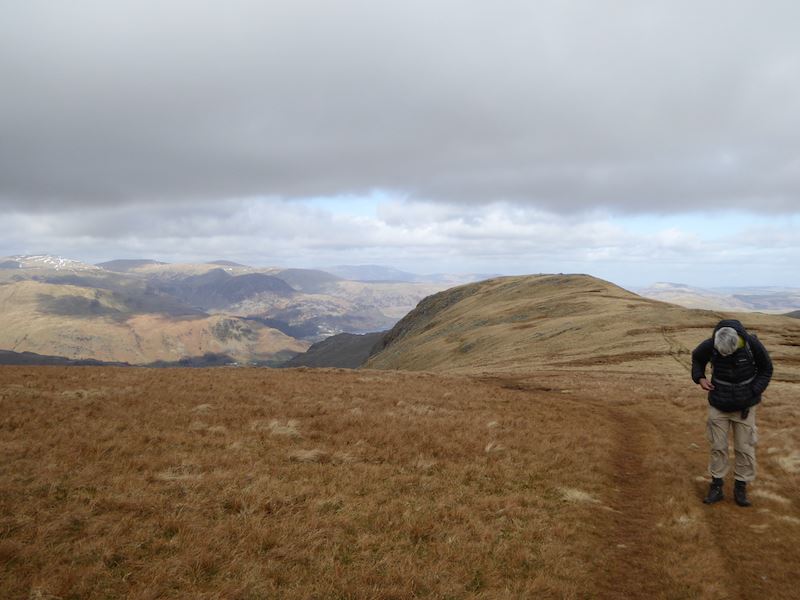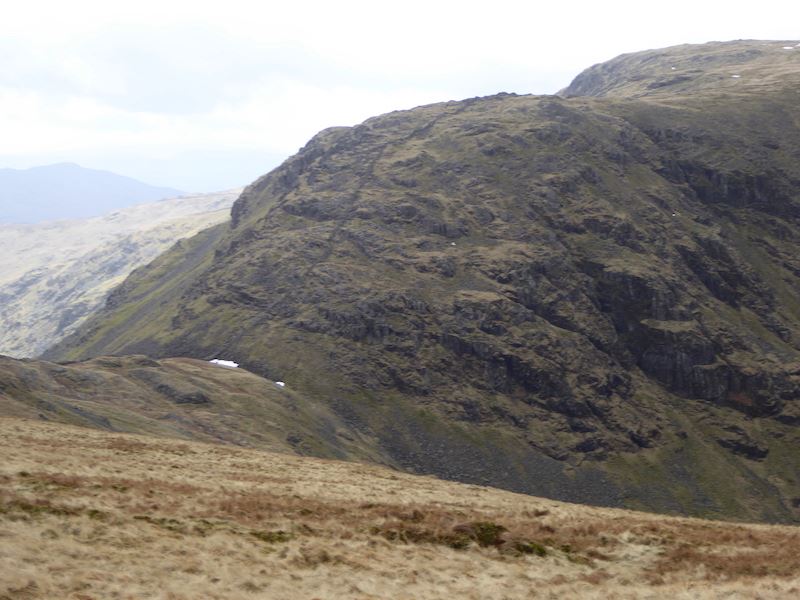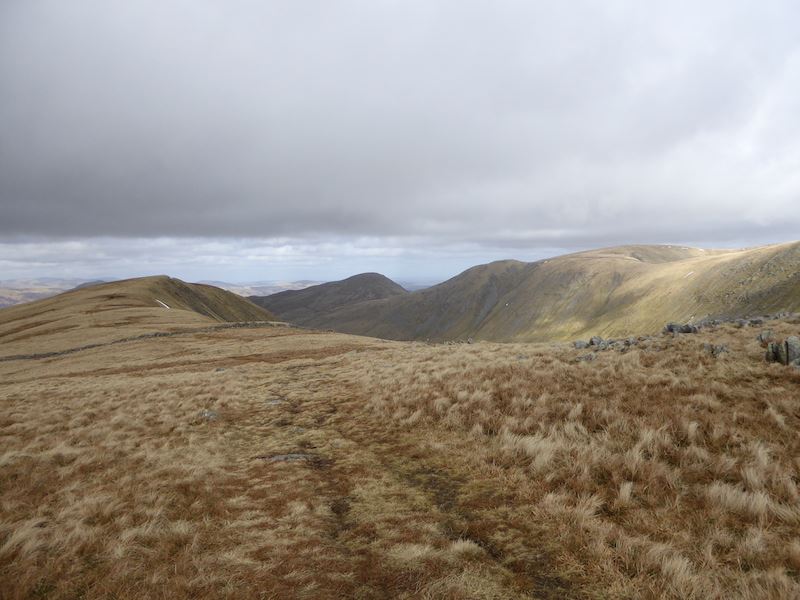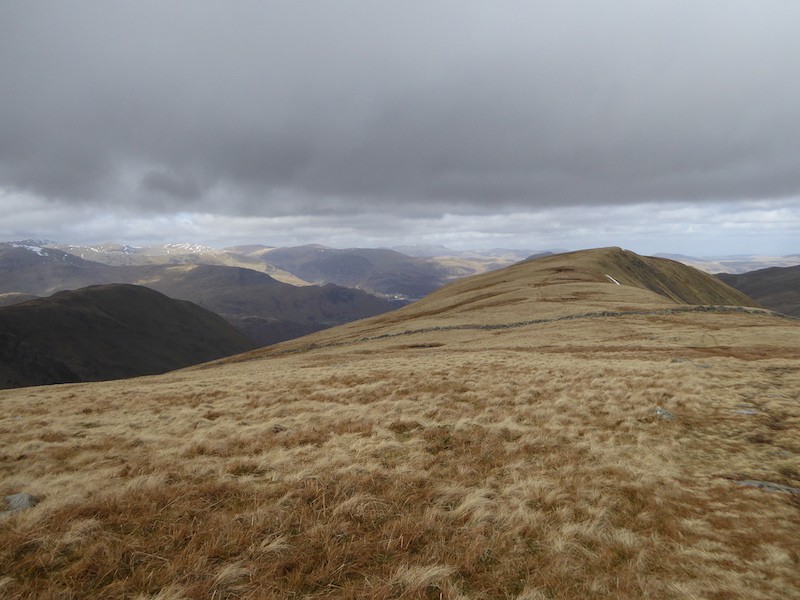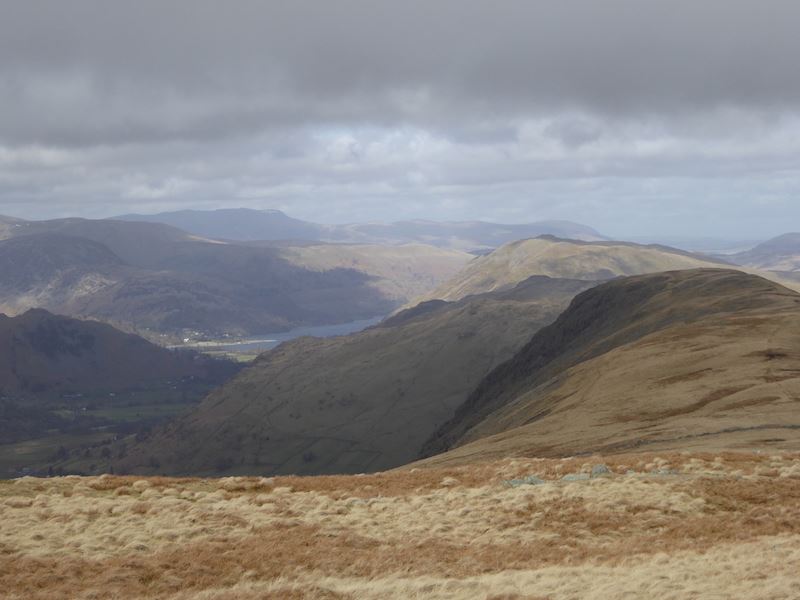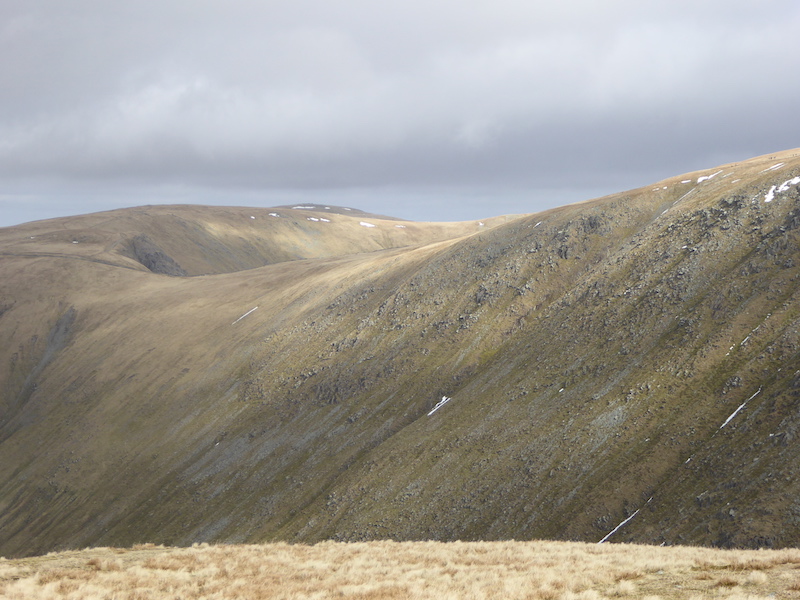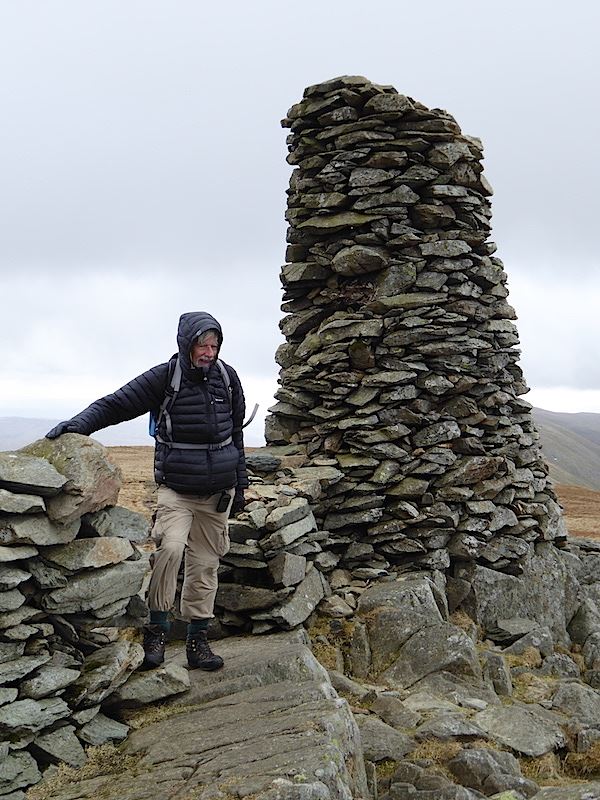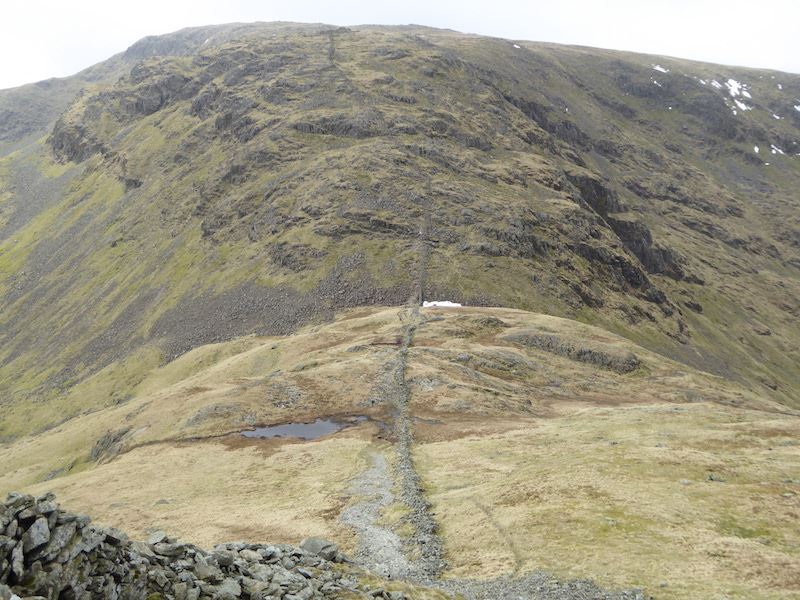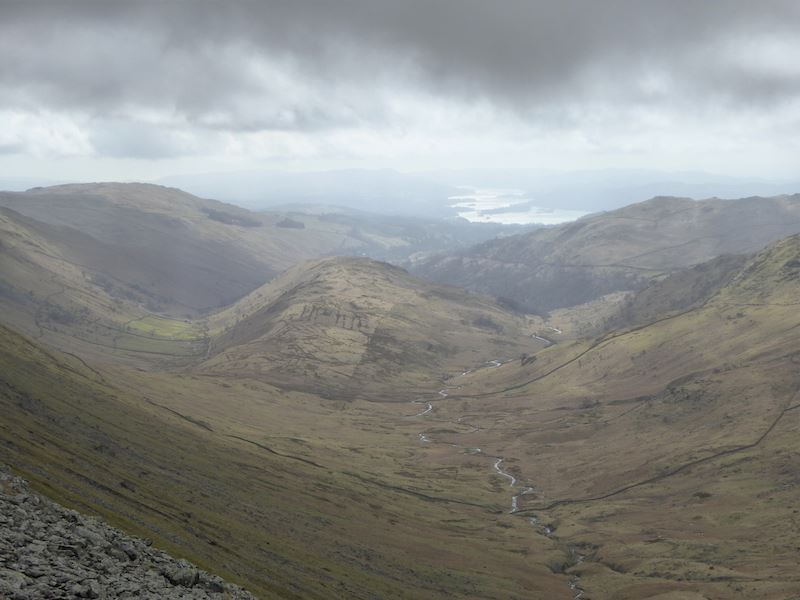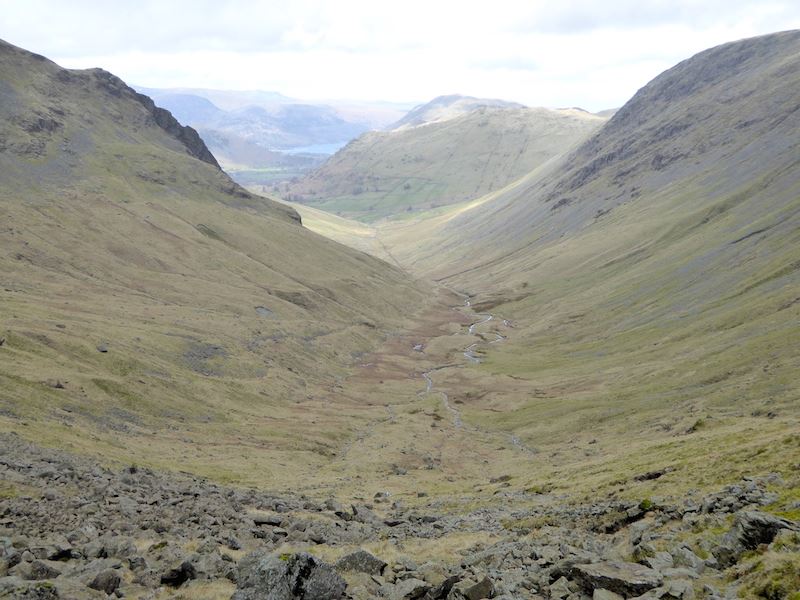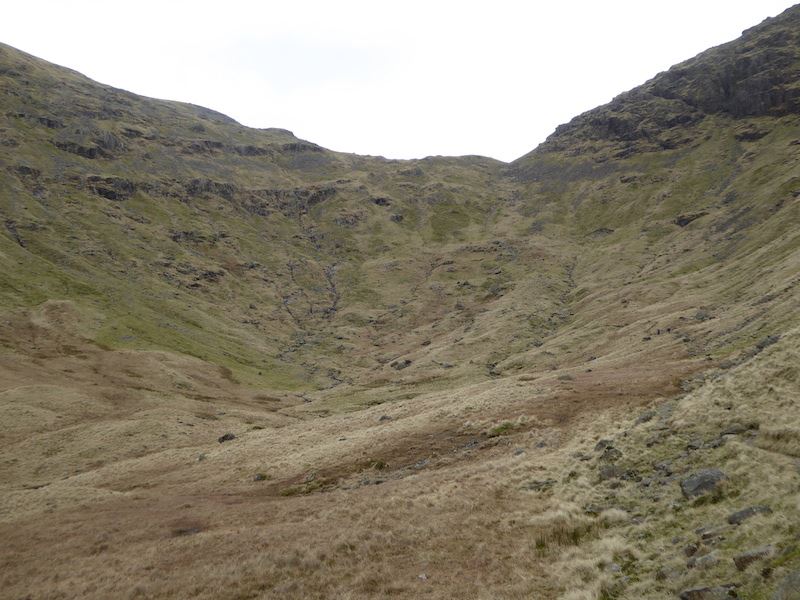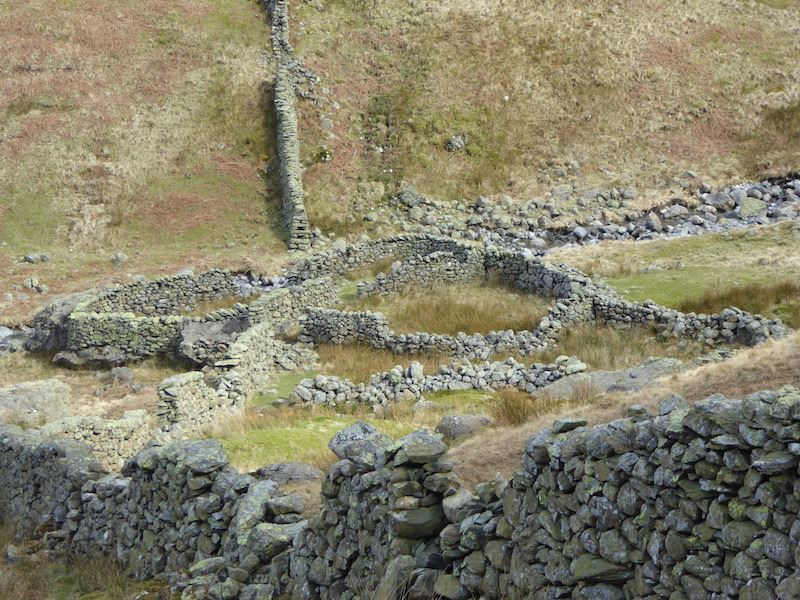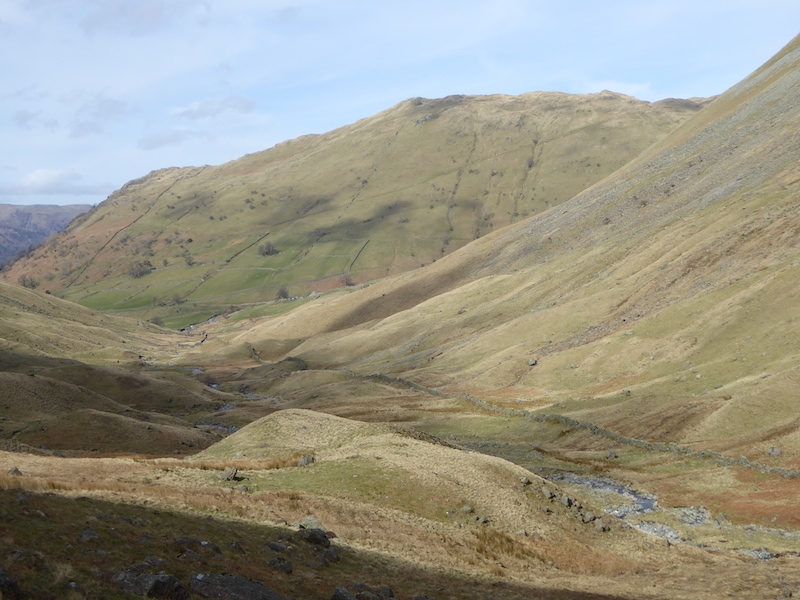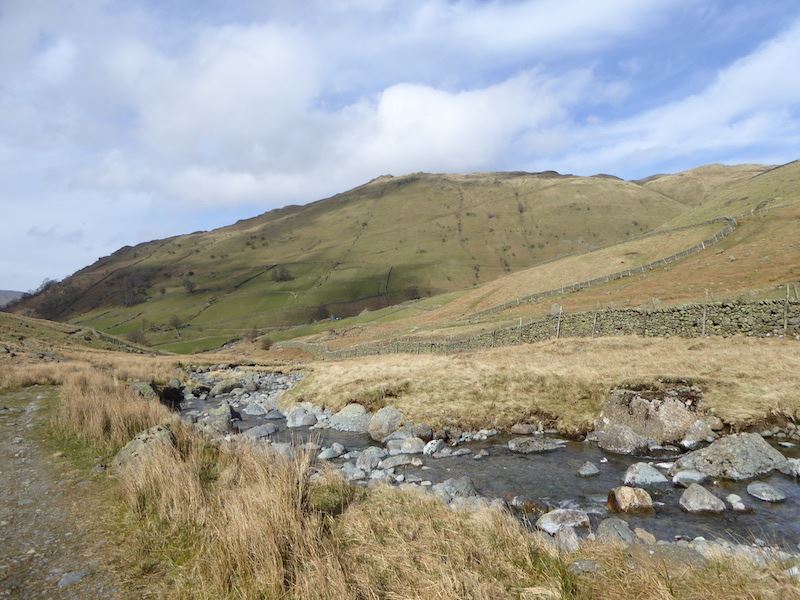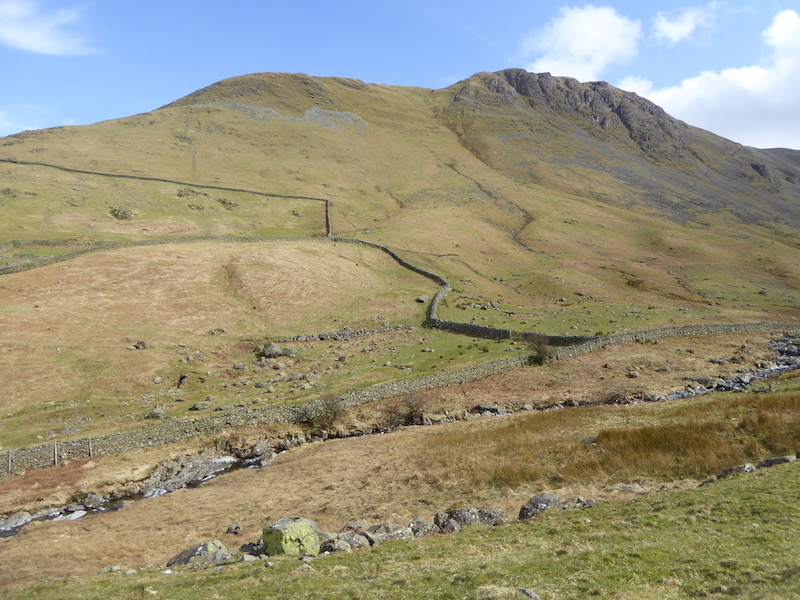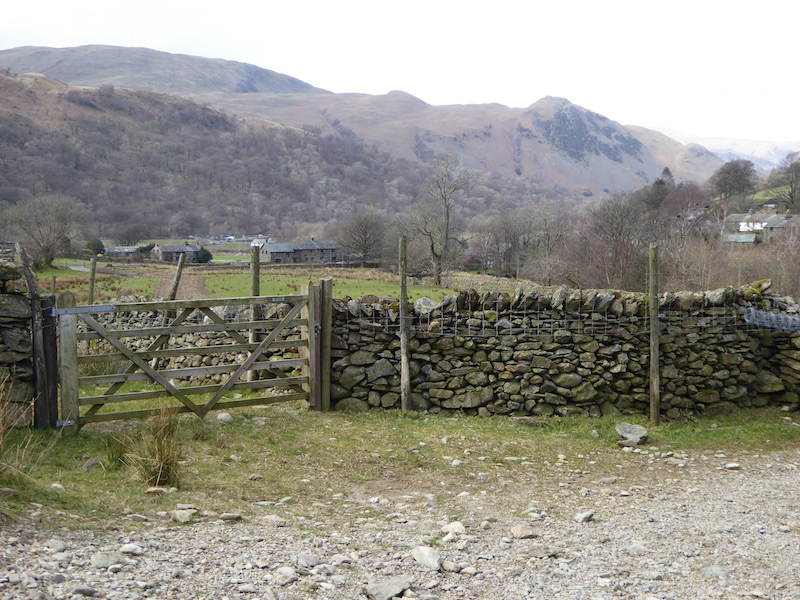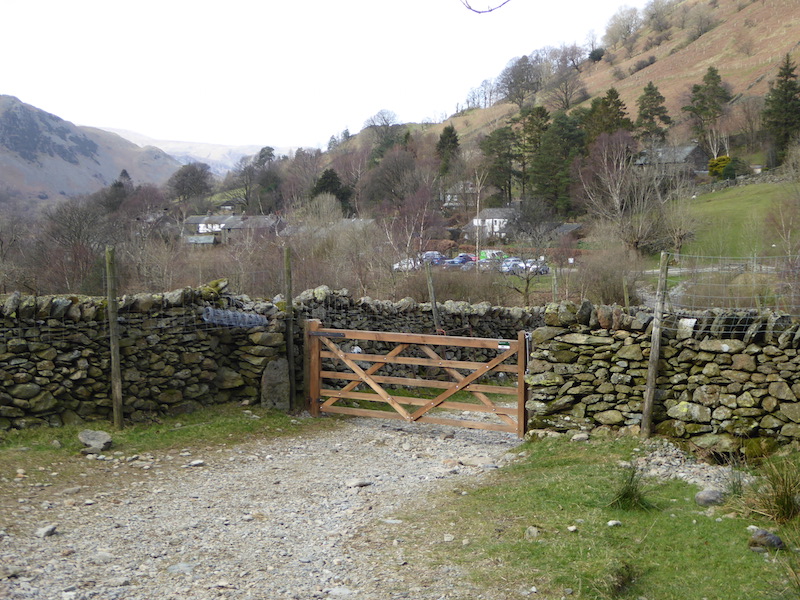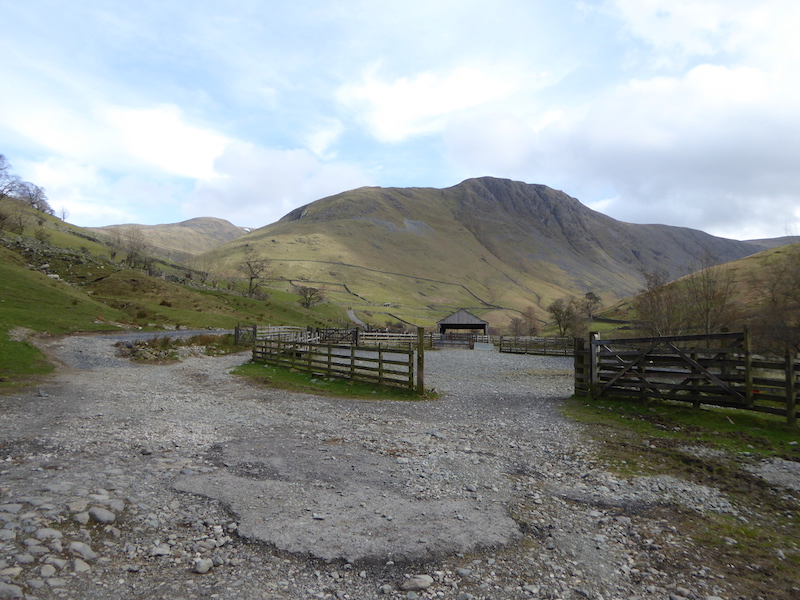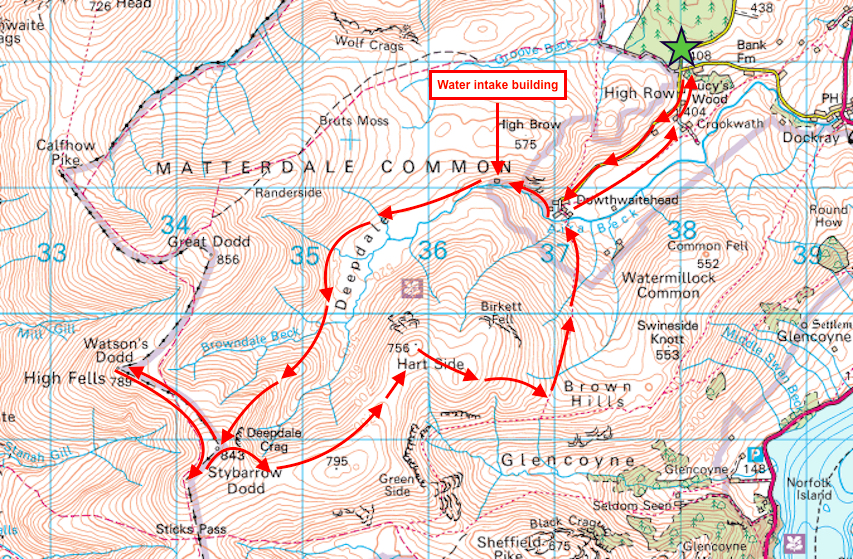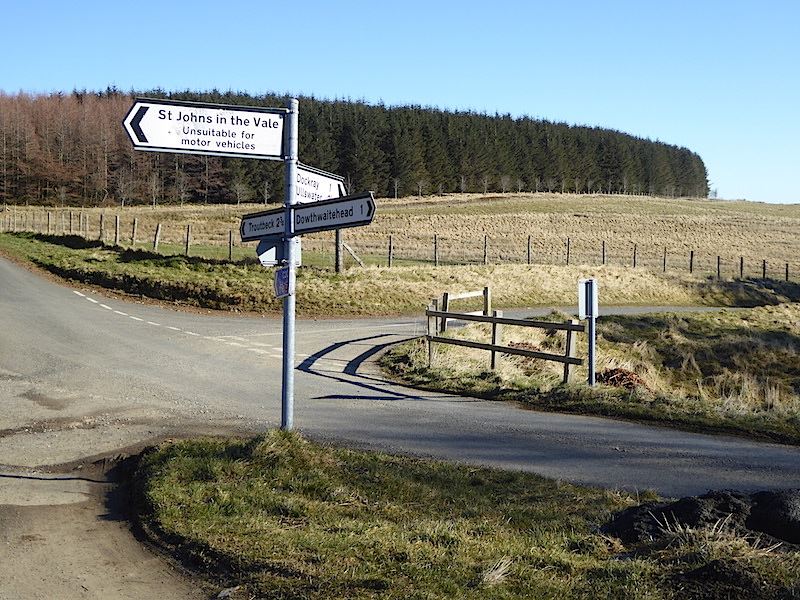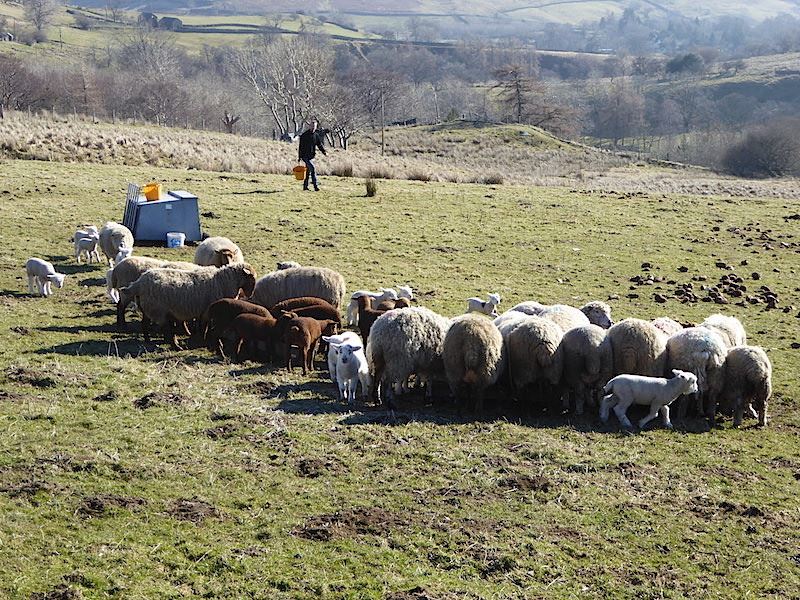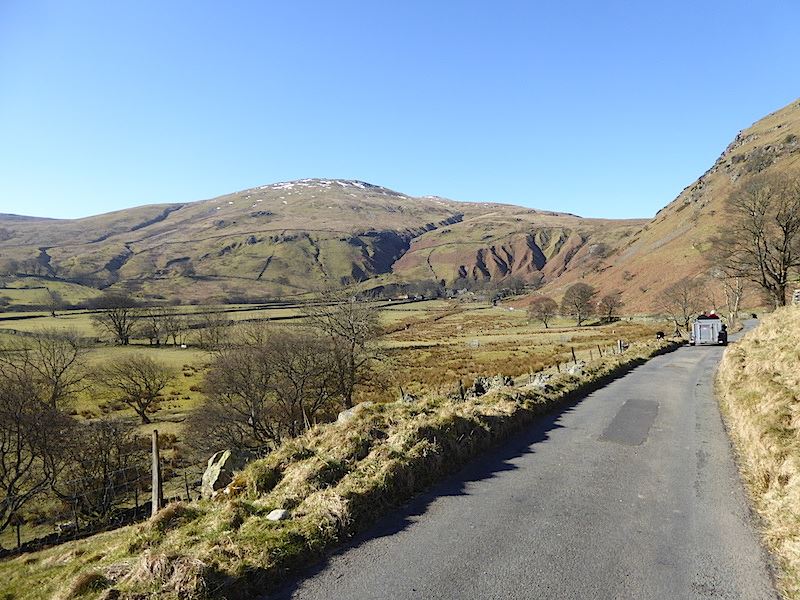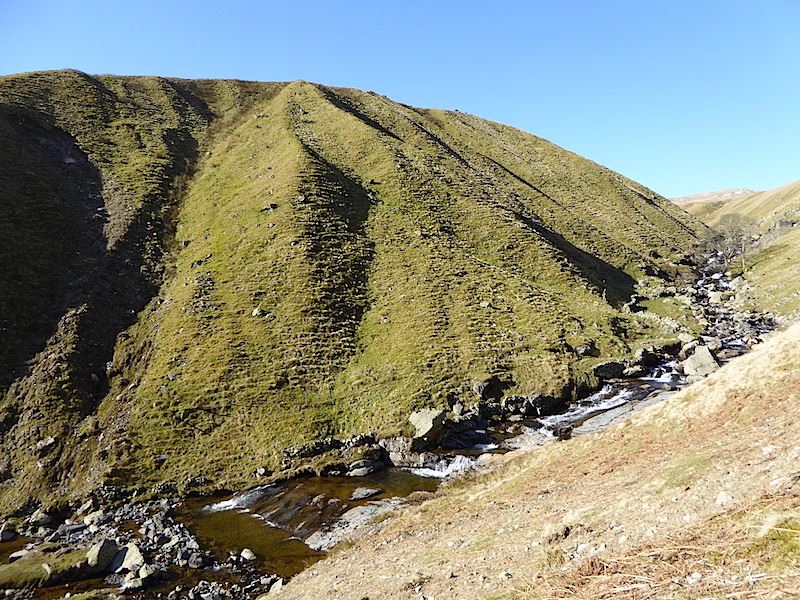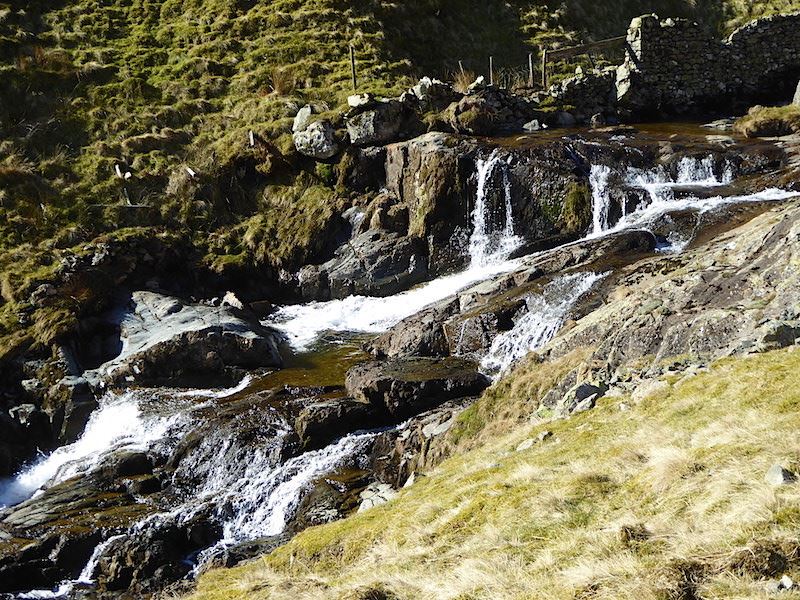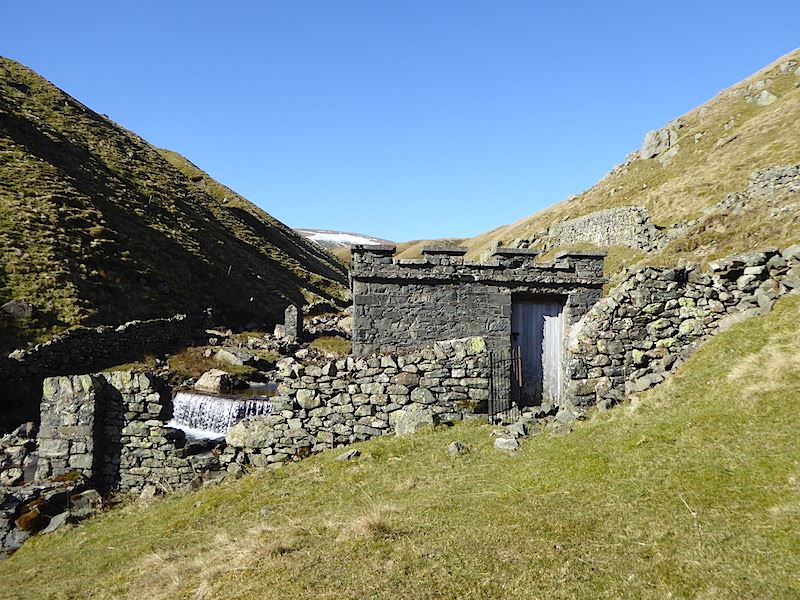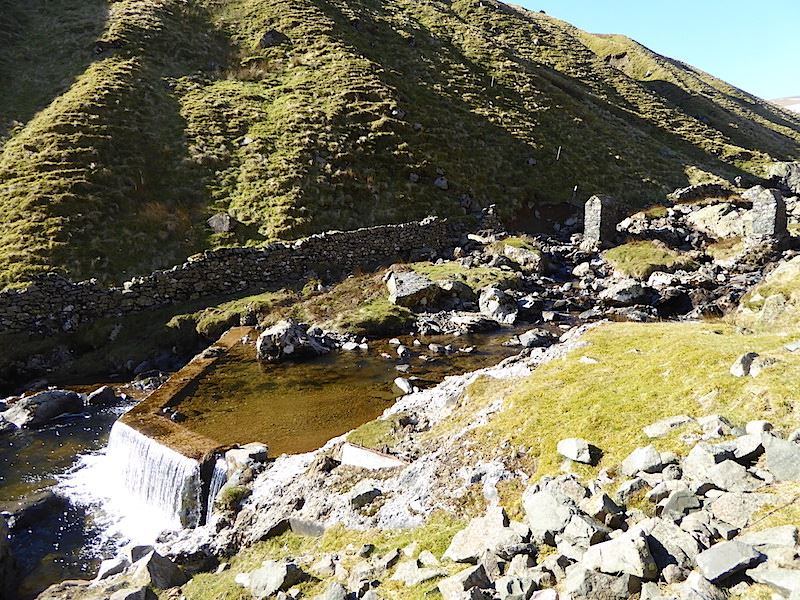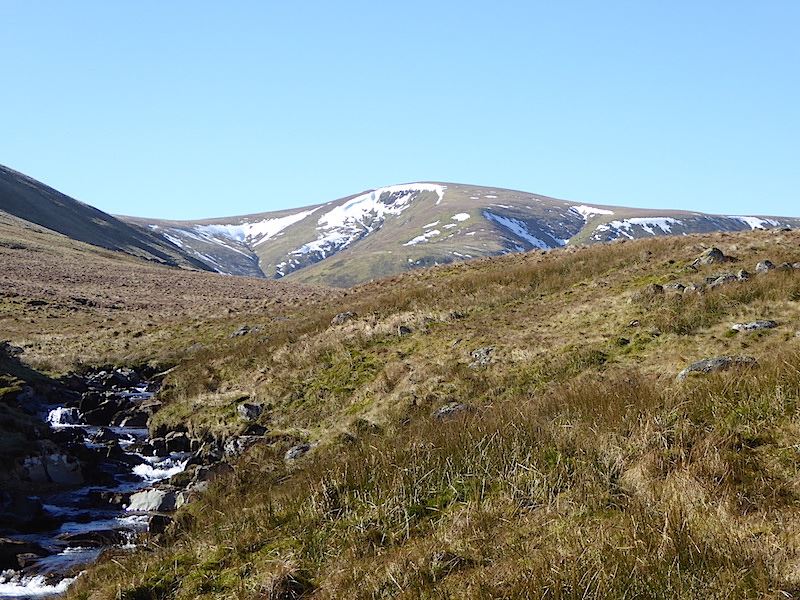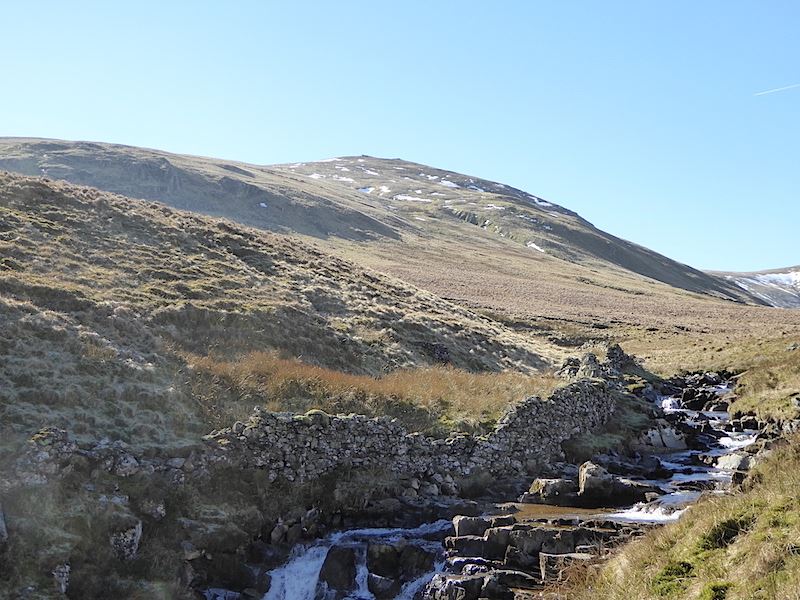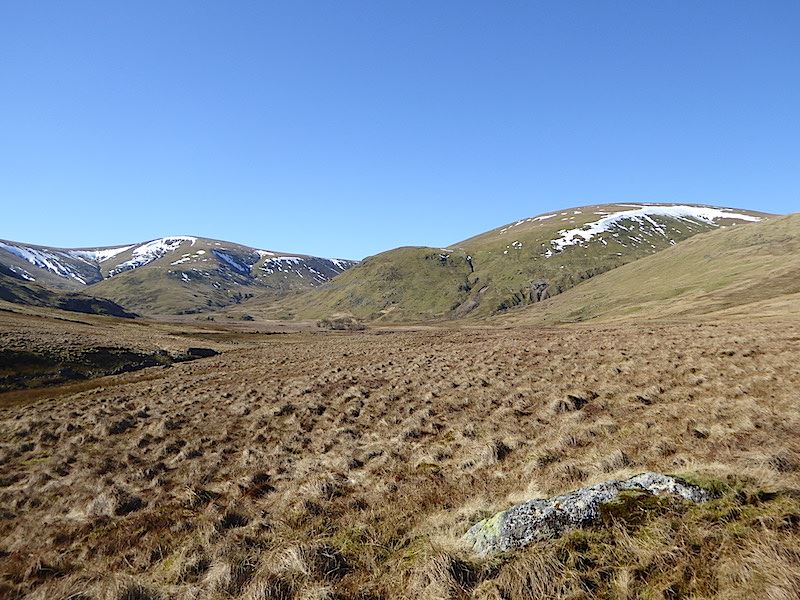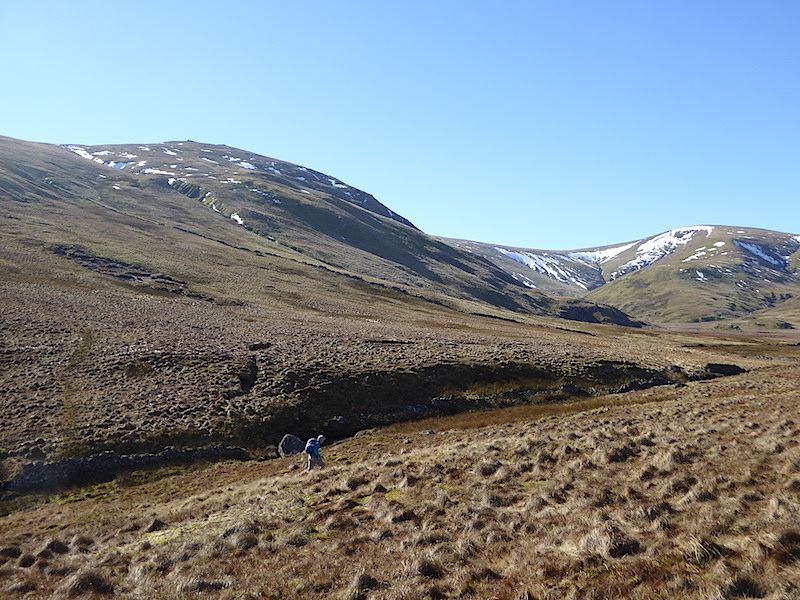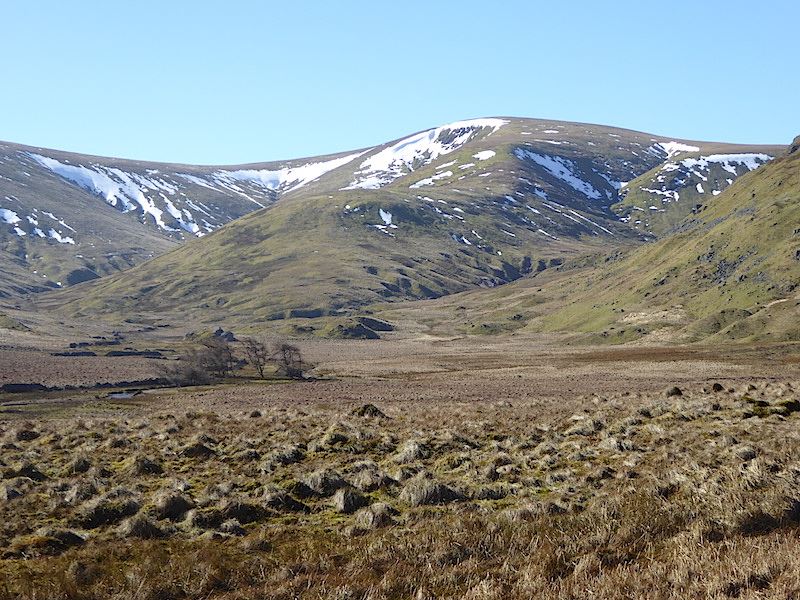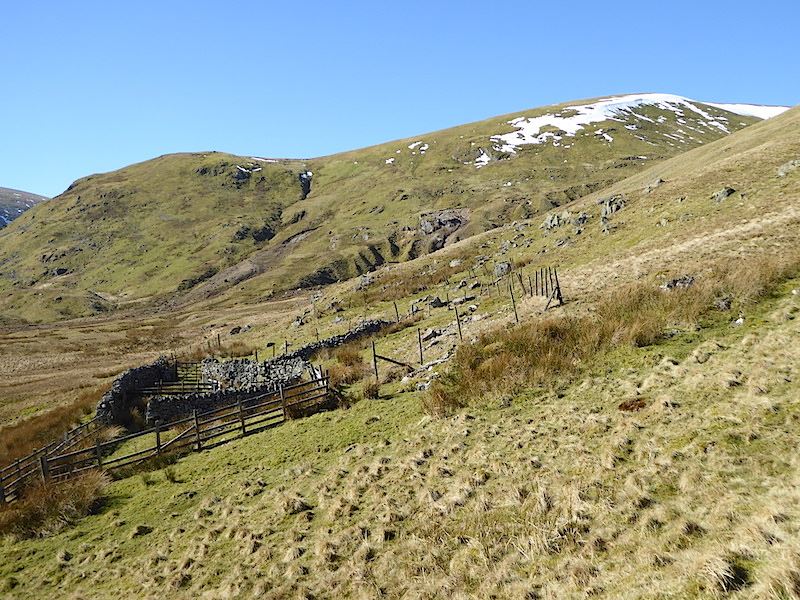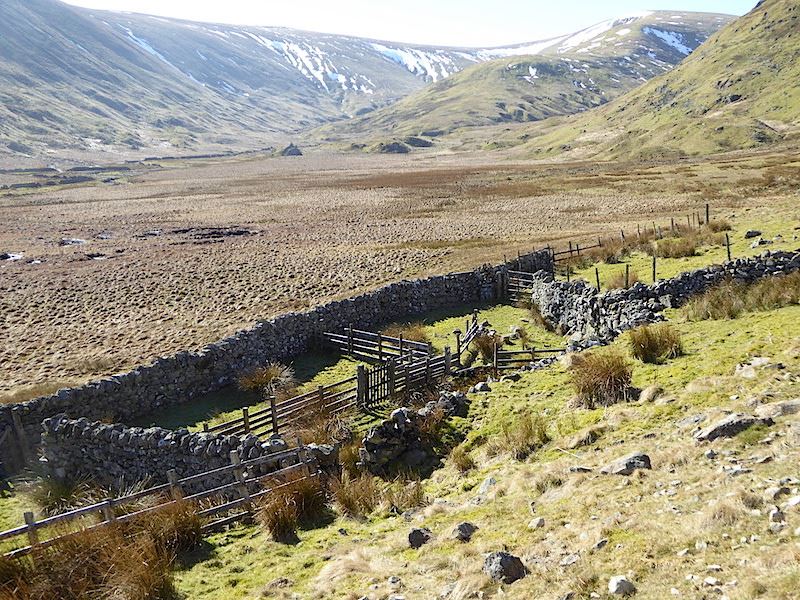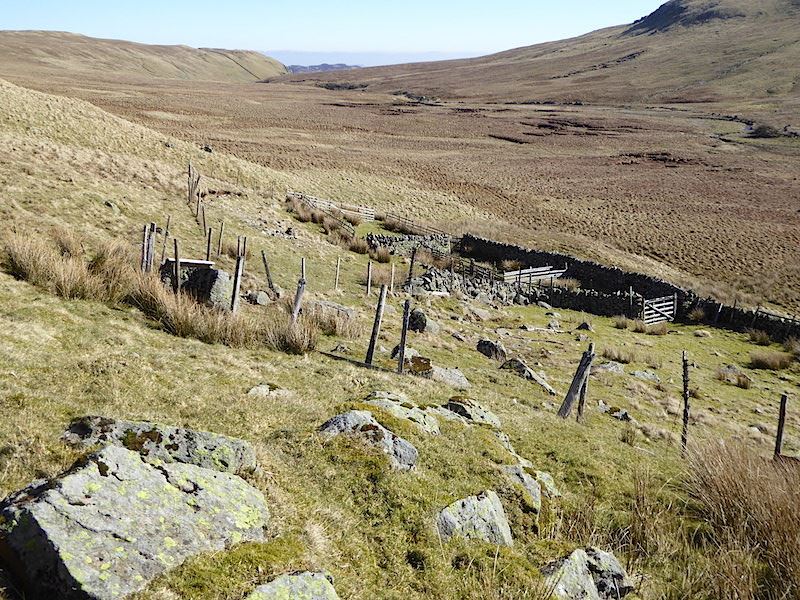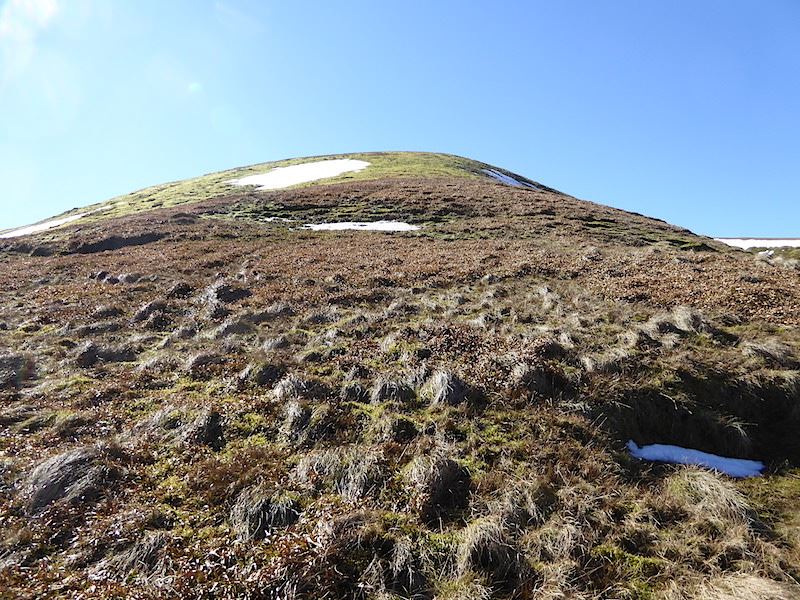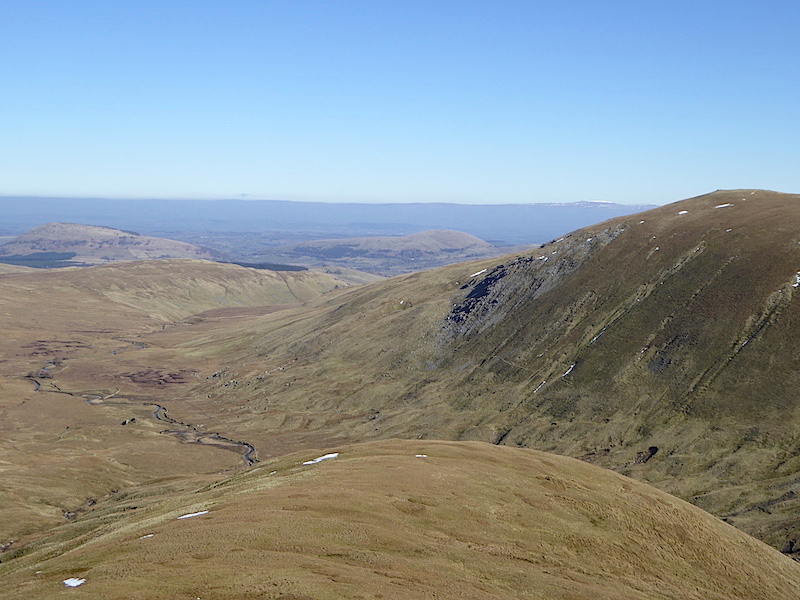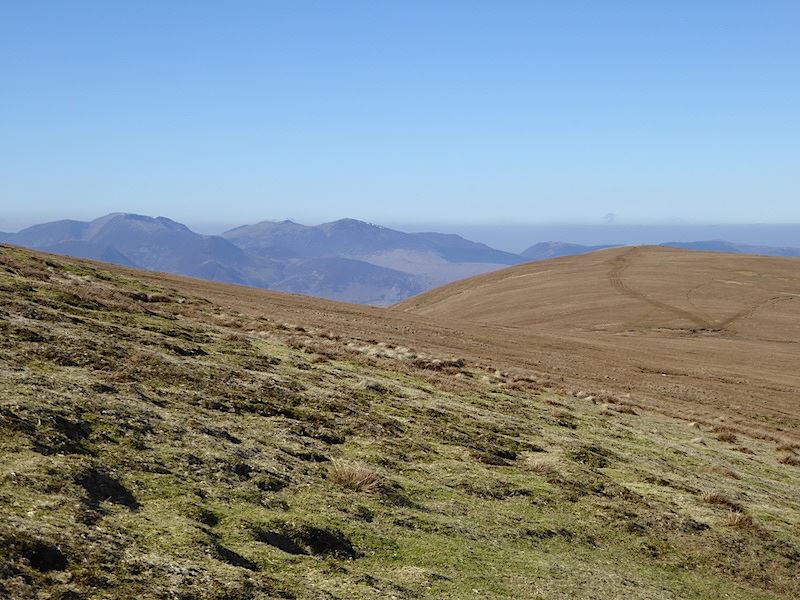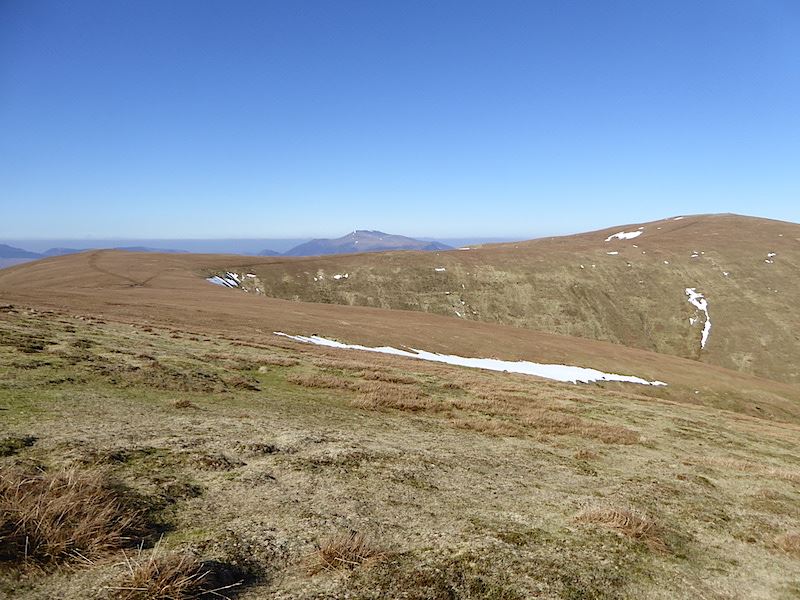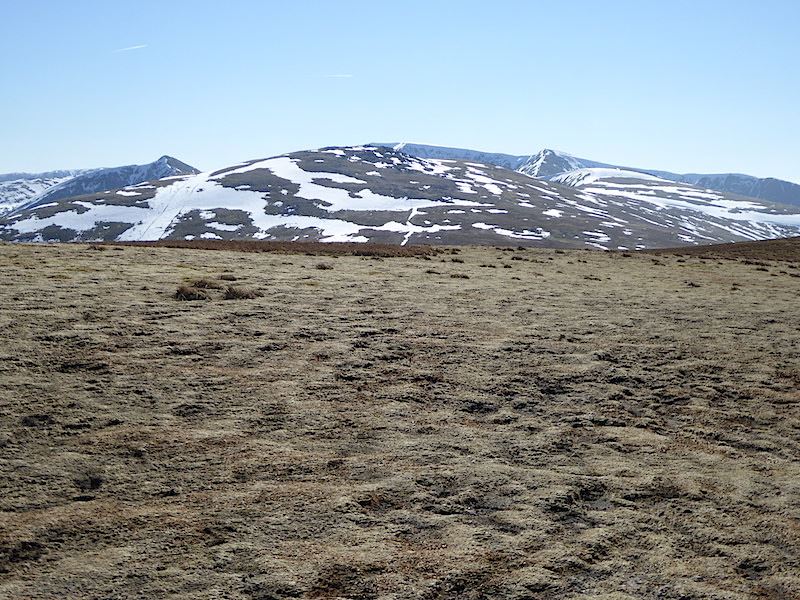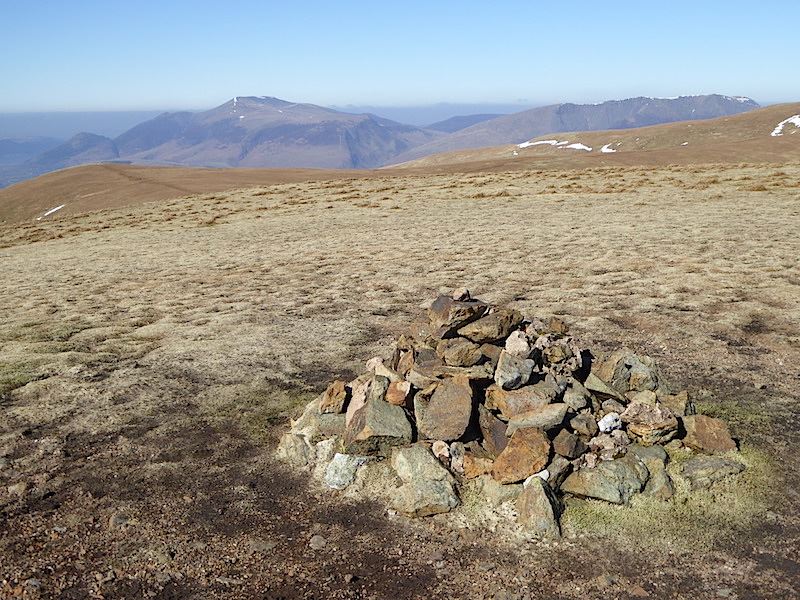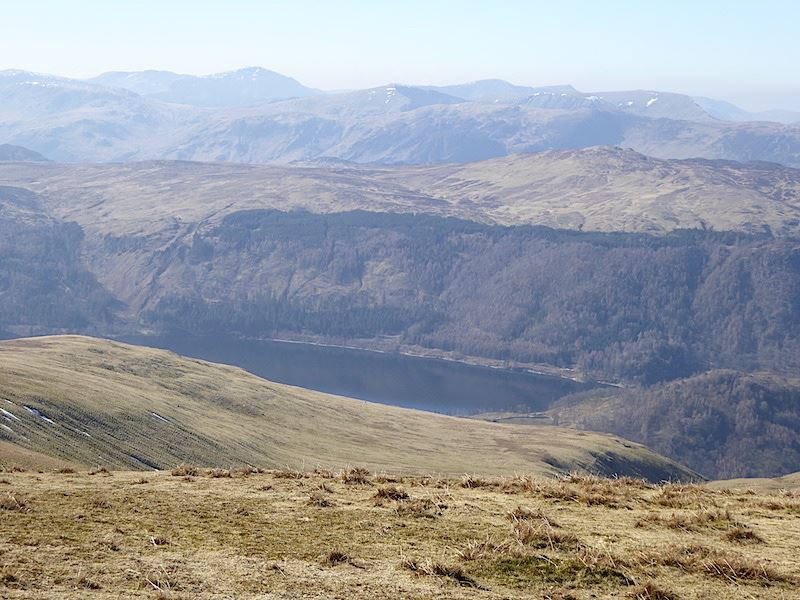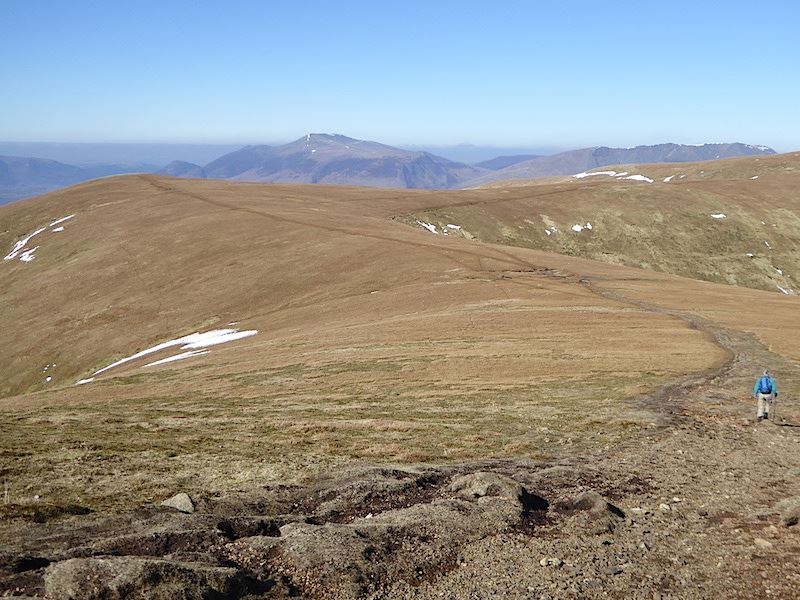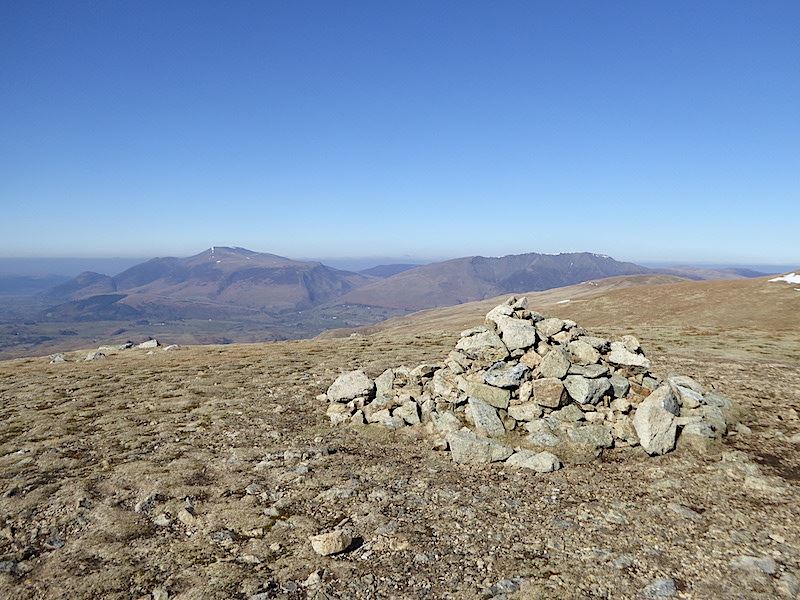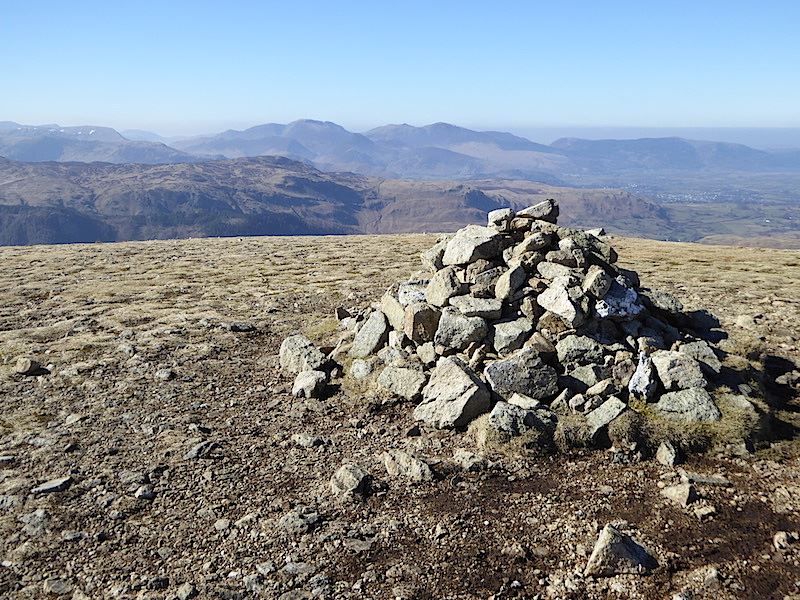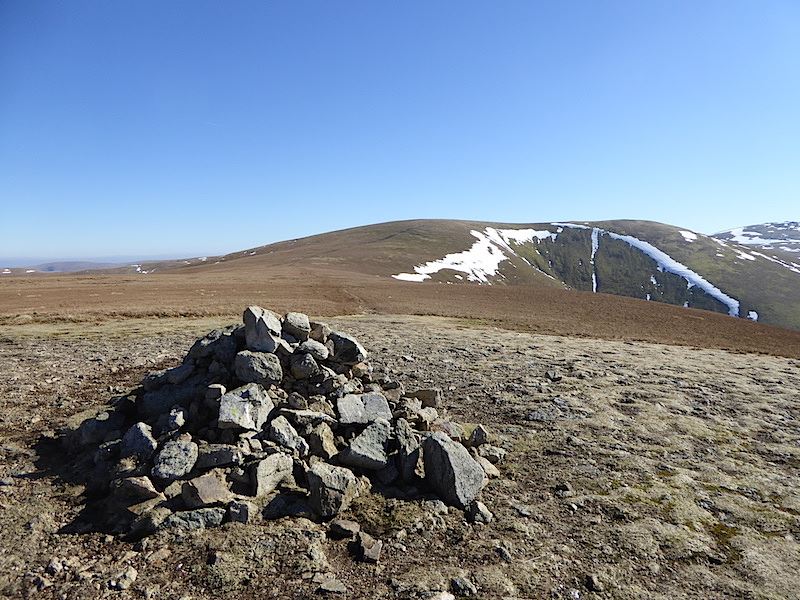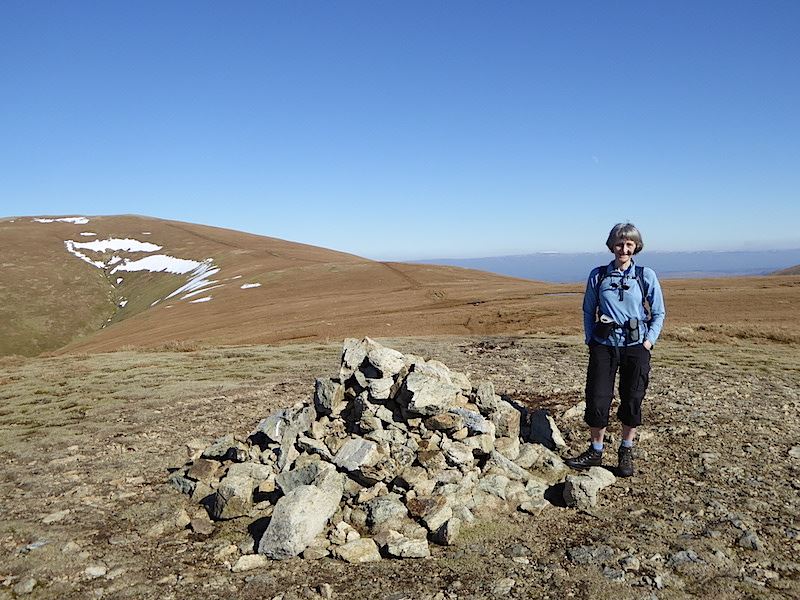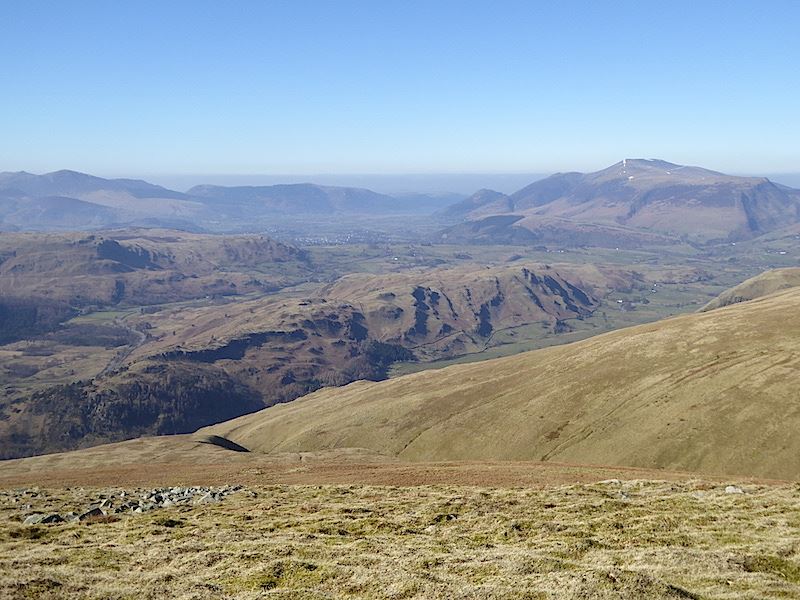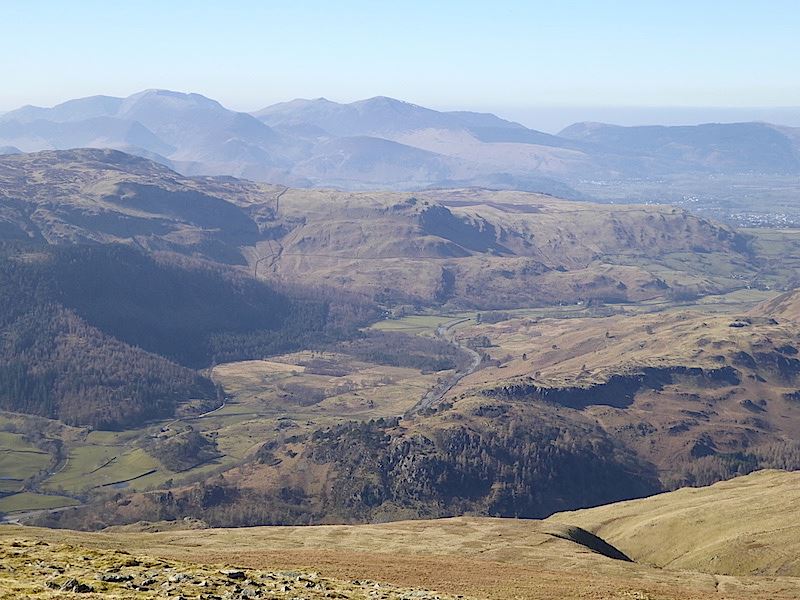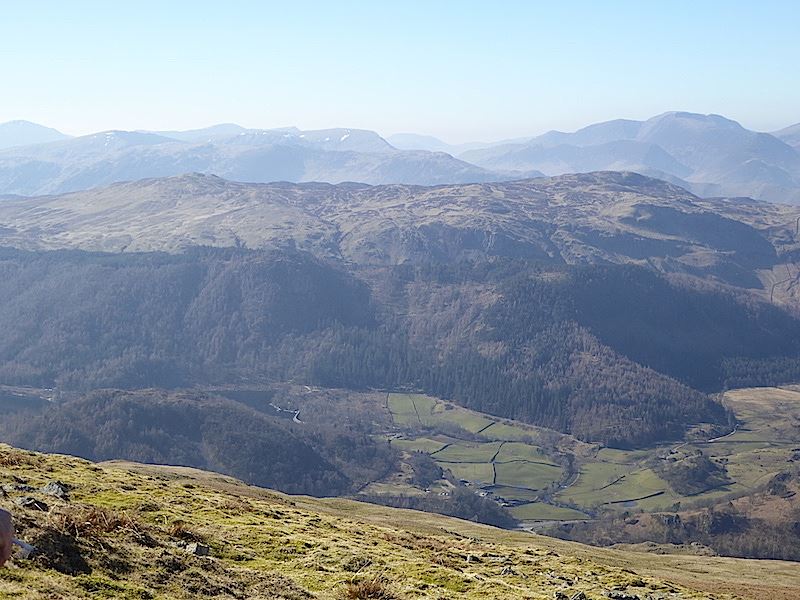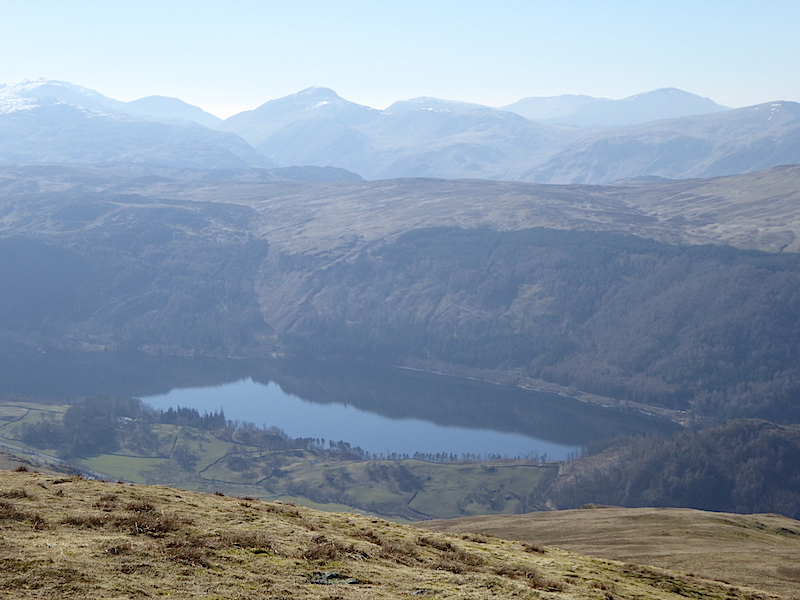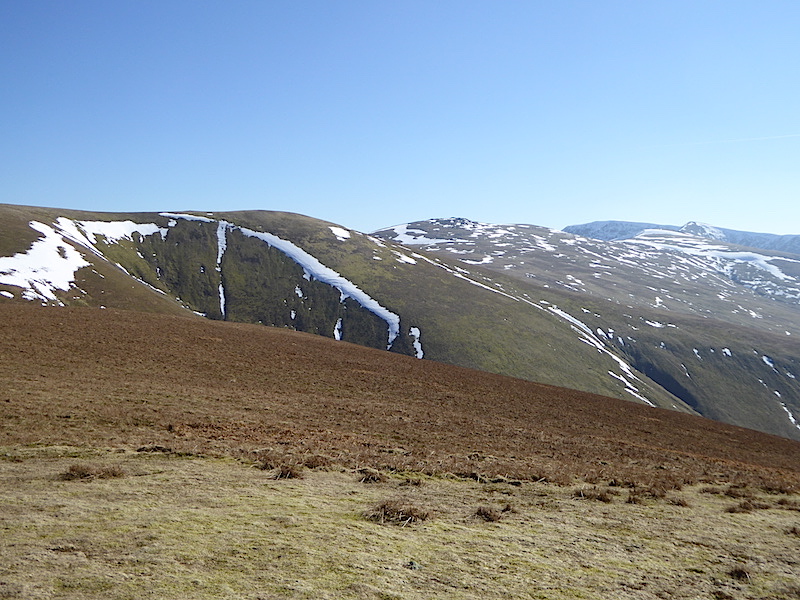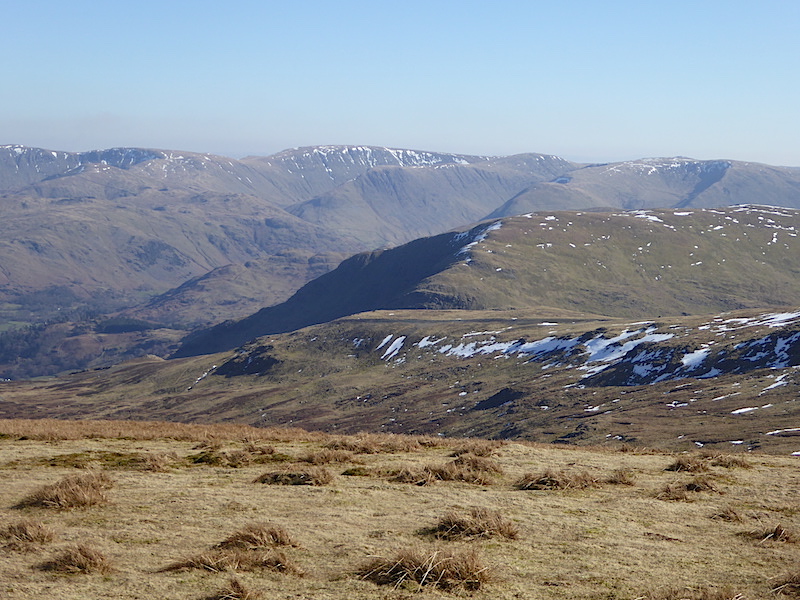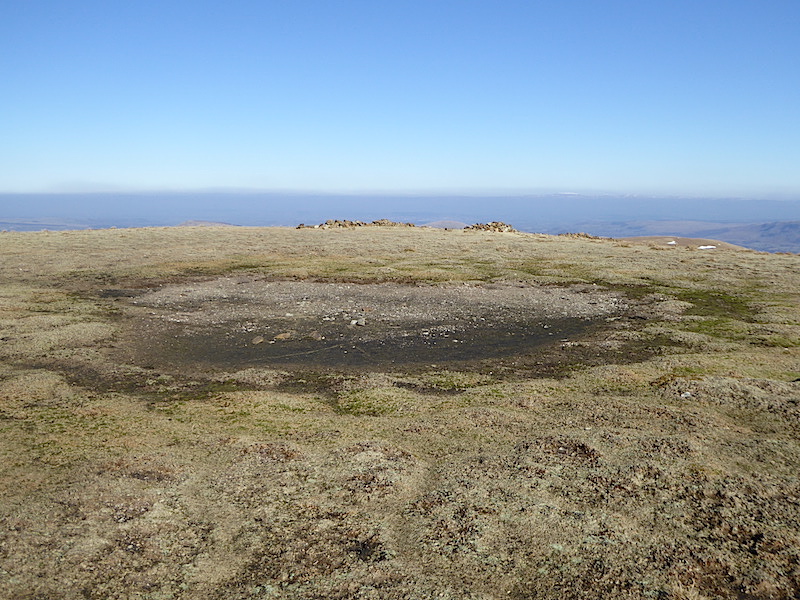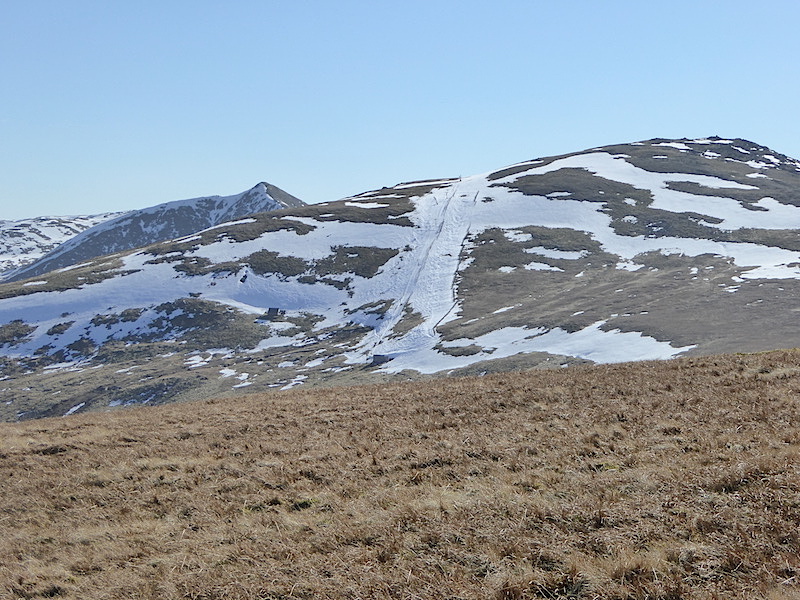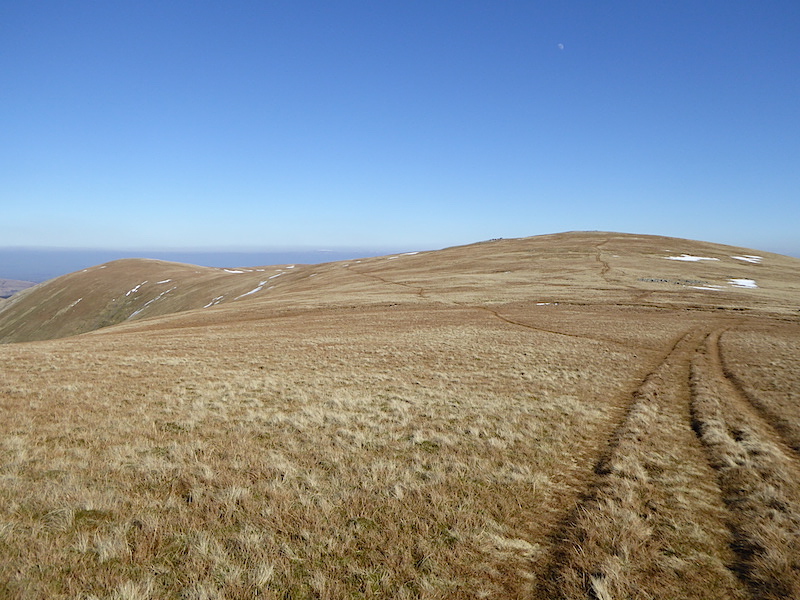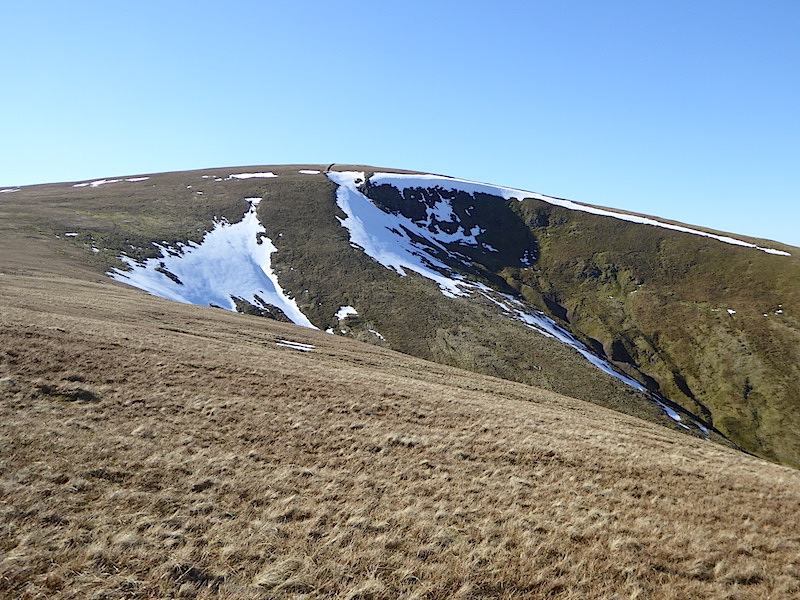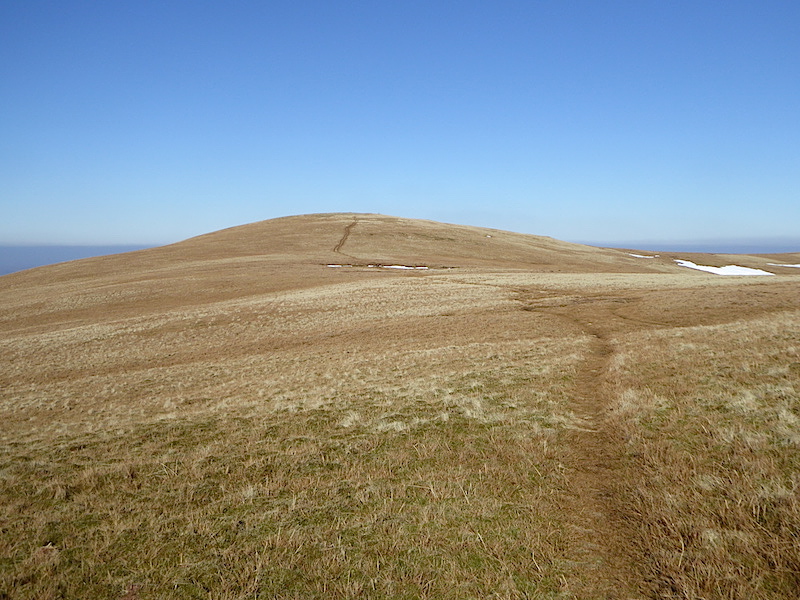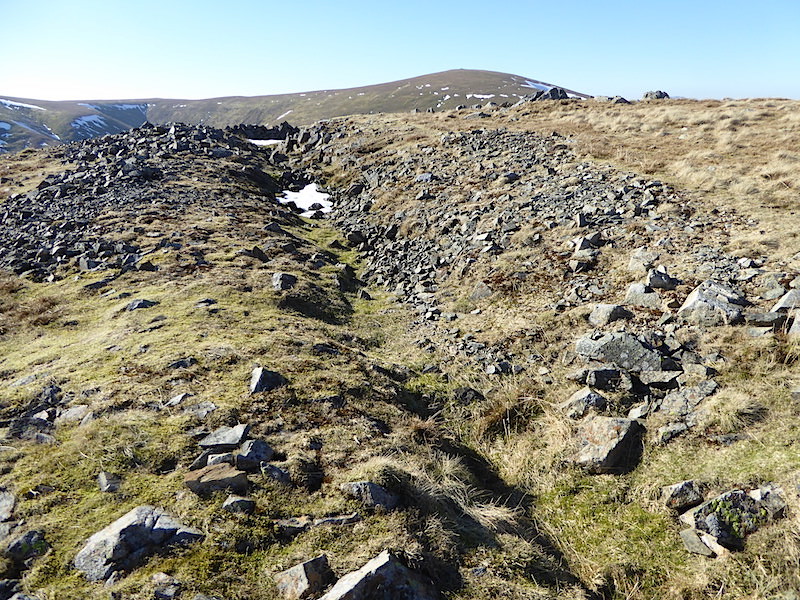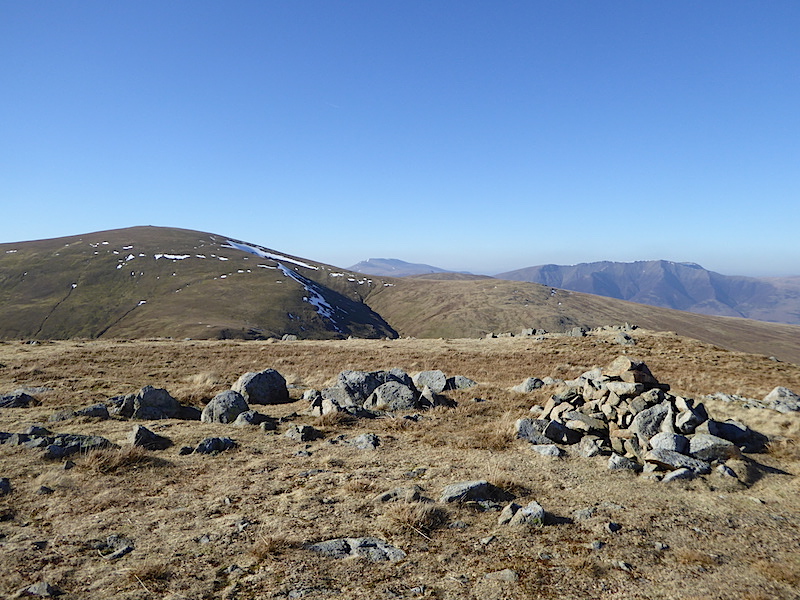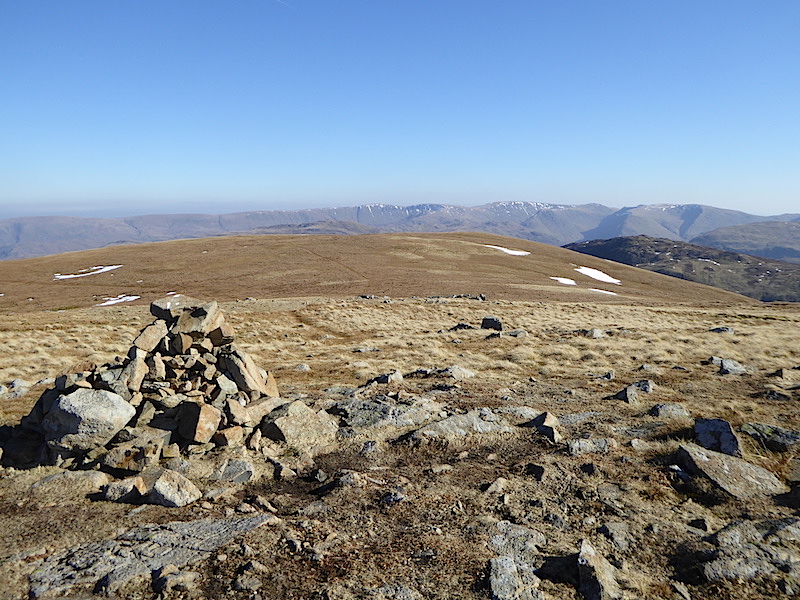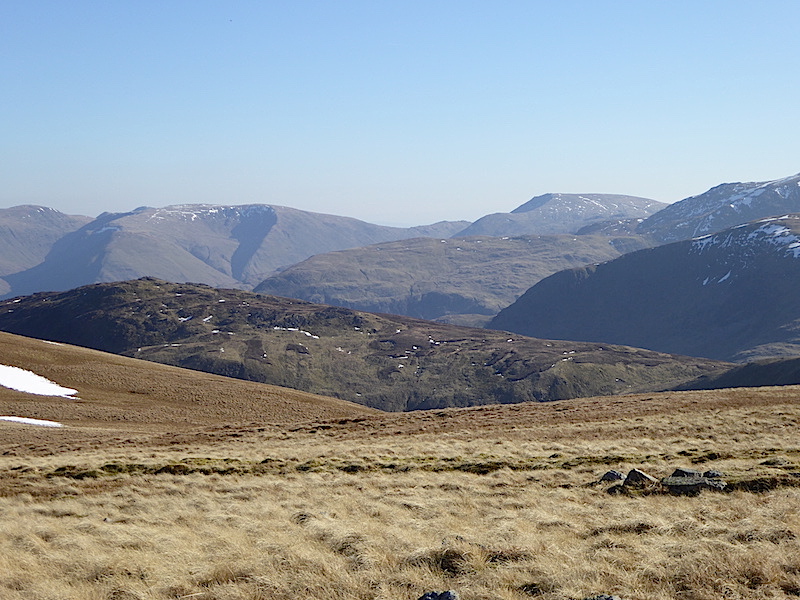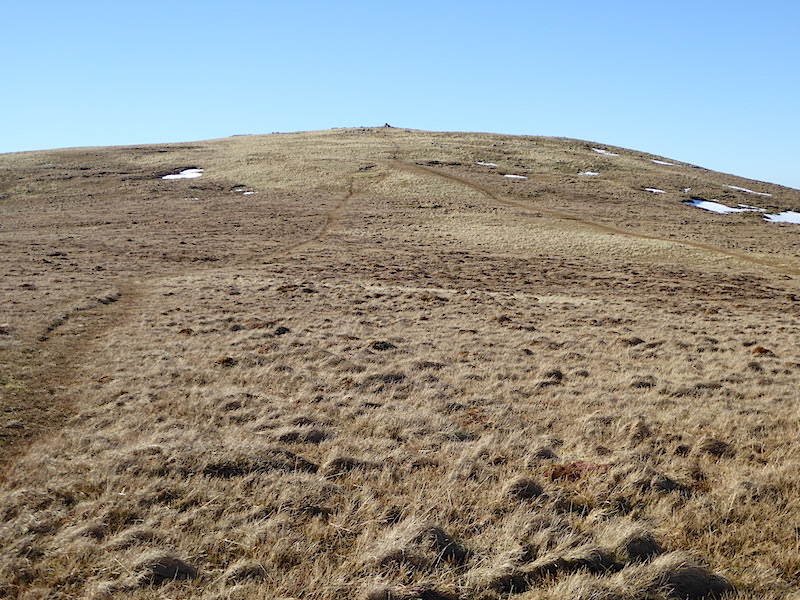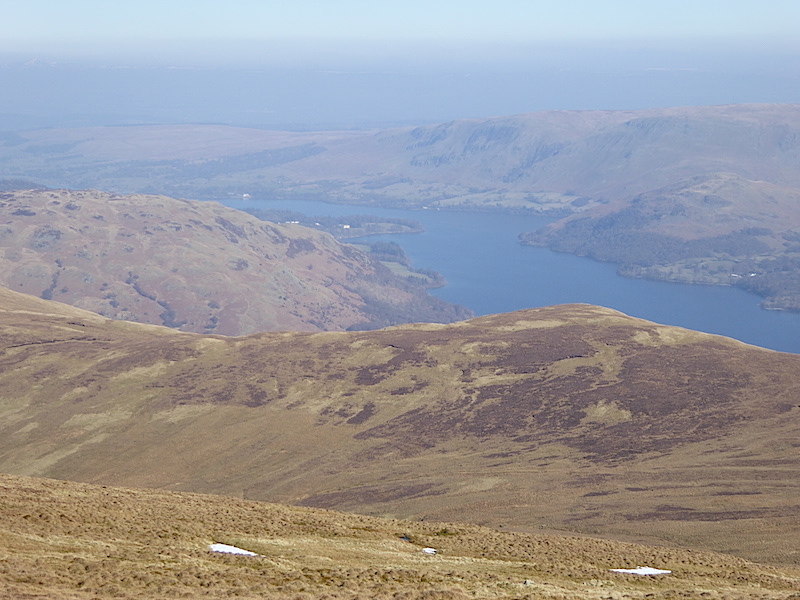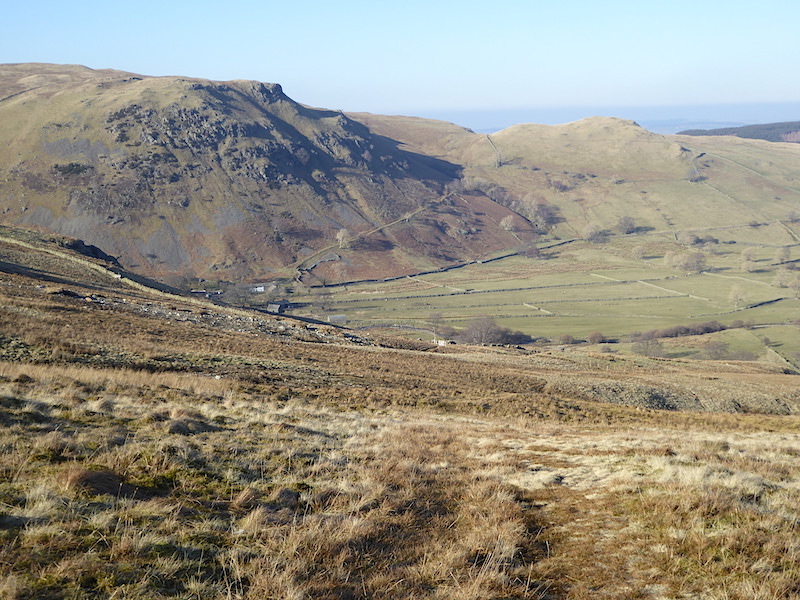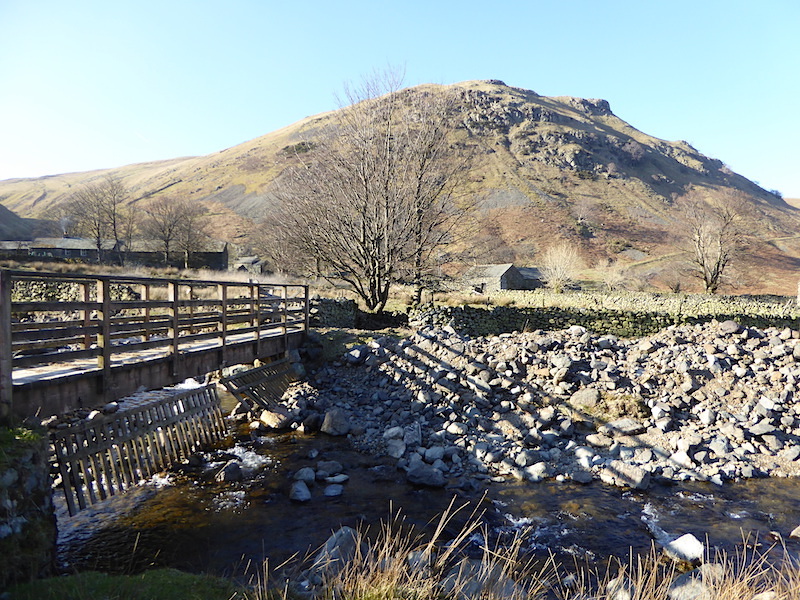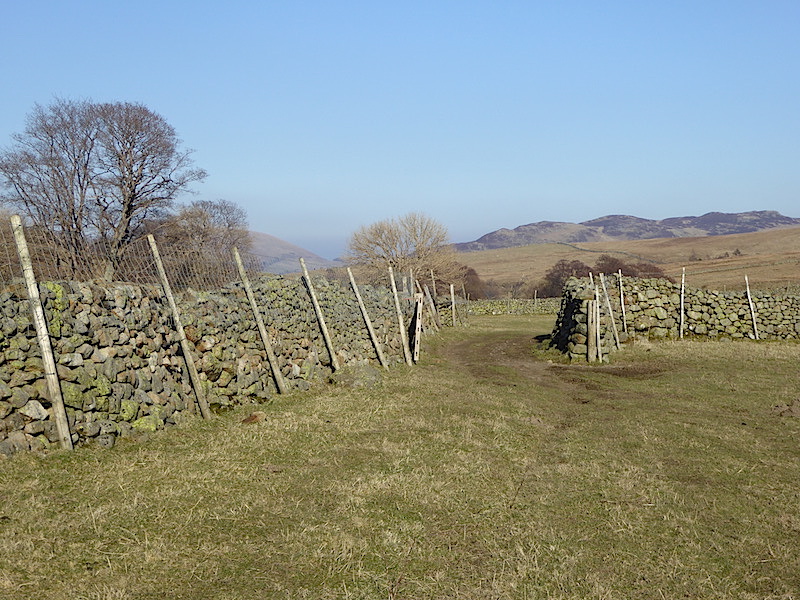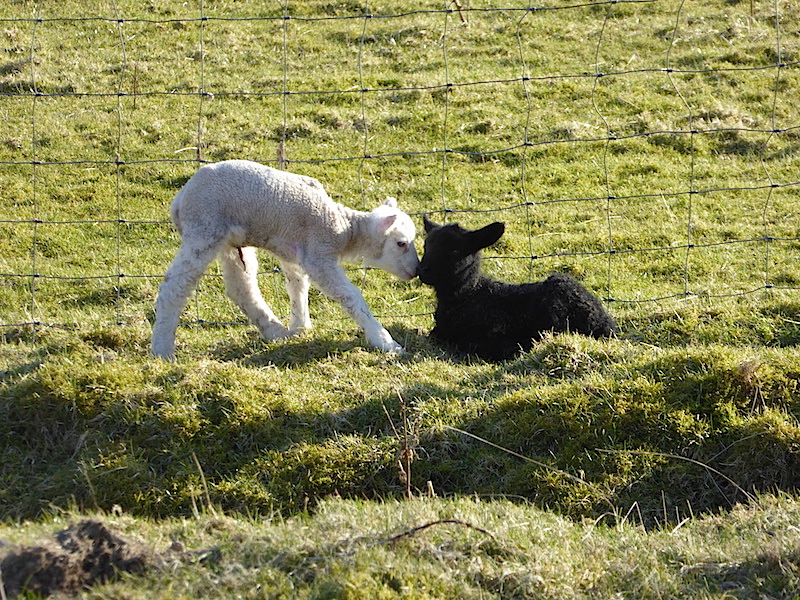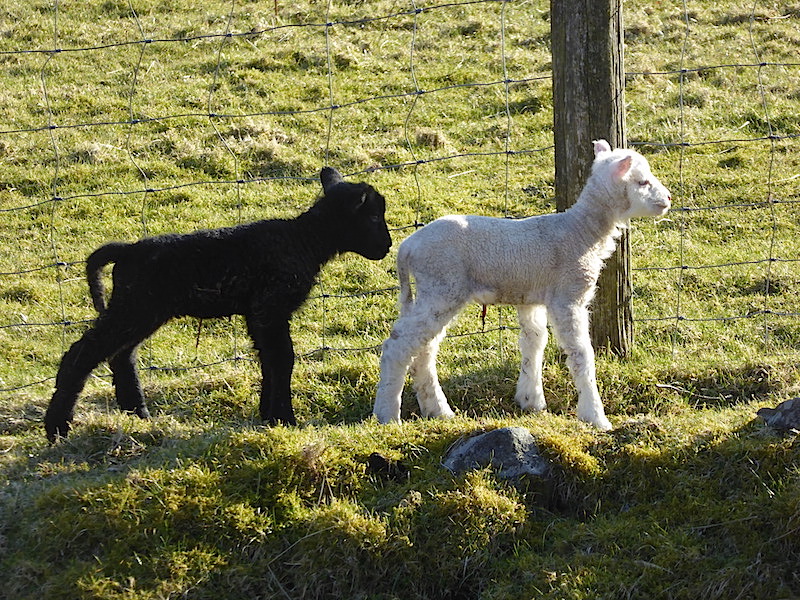Walk Date – 10th April 2016
Distance – 9.1 miles
Weather – warm and sunny, cool easterly wind on the tops
When we left home this morning everywhere, as far as the eye could see, was enveloped in a large temperature inversion, so we saw nothing but fog until we were well along the A66 heading towards Keswick. Once we were out of the fog we were very surprised to see that fresh snow had fallen. There was no snow anywhere yesterday, just the odd patch in places on the higher fells and I thought we had seen the last of it until winter comes around again. There was quite a lot on the eastern fells in particular so I took a few photos as we travelled along, some from lay-bys, others through the car window so apologies for the blurry shots …..

Little Mell Fell.

The Helvellyn range on the right skyline.

Blencathra.

Great Dodd and Clough Head.

Blencathra again from the A66.

Some of the north western fells from the A66.
Now on with the walk …..
Route


The first fell we’ll walk up today will be to Eagle Crag is in the centre of the shot. It has a sprinkling of snow but Greenup Edge over on the left has quite a bit more. Its a beautiful morning with just enough coolness about it to keep the jacket on for a little longer.

Not much snow on Grange Fell though, and it looks like somebody had a fun time trying to drive out of the muddy grass

A look back along the lane as we walk along to Stonethwaite village.

“Don’t look now, but have you seen what her behind us is wearing?”

You wouldn’t really do anything else on that track, would you?

This is where we leave the village and cross over Stonethwaite Beck to pick up the path on the other side.

Not too far from the bridge is this sheepfold, the shot turned out to look better than I thought it would. The sun was more or less directly in front of us so taking pictures looking ahead was difficult.

Eagle Crag across Stonethwaite Beck.

Another sheepfold alongside the beck. The jackets came off at this point as the day was warming up nicely.

A look back down as we make steady progress up Greenup Gill.

One of the many pretty little waterfalls in Greenup Gill.

Just above this waterfall is what looks like a bit of old wall. Its actually a sheepfold standing on a little island in the beck. We plan to turn off to the right somewhere here if we can find a handy place to cross.

A better view of the sheepfold, and Greenup Edge, now that we’ve crossed the beck and gained a bit more height. We’ve also gained a lot more water underfoot as the ground on this side is very, very wet. Its difficult to keep a foothold on the wet grass and we’re slipping and sliding with every step.

Higher up still and an even better view of the sheepfold and the little island.

Over on the left the top of Eagle Crag comes into view.

The ground is no drier up here and water is running everywhere through the flattened grass, progress slowed over here as it was hard to get any sort of firm grip under the boots, if we’d had the ice spikes with us they would have come in very handy for a while. Those white upturned basin shapes are snow covered drumlins. Above the ones to the left is Lining Crag with the path, which we turned off earlier, going up to the left of it and leading on up to Greenup Edge.

Eventually we reach ground which was marginally drier as we get nearer to the wall below Eagle Crag.

At the wall I take a look behind us to High Raise, over on the left, and Sergeant’s Crag on the right.

Since the wall has a fence above it there is a stile to do the cross over, once you’ve ploughed your way through the mud that is. The stile is a bit longer on the other side, a situation not helped by the fact that one of the lower rungs was missing, involving a big step down for anyone who is in the ‘a bit short in the leg’ category. The stile is a useful ‘warm up’ exercise for the next bit of excitement.

Your trials and tribulations do not end at the stile, having got over the wall you now have to climb back up it again to get onto the right side of Eagle Crag. The stile wall continues right up to the side of Eagle Crag and then turns along it towards where I am standing with the camera. This returning wall also has fence on top of it, so you can’t climb directly over from the other side. We call it ‘The Awkward Corner’, its especially awkward if you aren’t as bendy as you once were.

” I’m OK, you just stand there taking photos and giggling, I can manage.”

Made it!

The Awkward Corner …..

….. and the stile which is just a few yards away from it. Now the fun and games a over and we are on the correct side of the fence we can get on with climbing the last few yards up to the summit of Eagle Crag …..

….. from where there is a fine view down into Borrowdale. The village of Stonethwaite in the green fields below.

The view across to the Skiddaw fells isn’t too bad either

Eagle Crag summit.

We put another layer on as there was a nippy little breeze up here today.

From Eagle Crag summit looking south to Sergeant’s Crag, straight ahead, and High Raise over to the left.

A closer look at Glaramara across the valley. By ‘eck, its a long way down.

Looking west from Eagle Crag with Pillar and Fleetwith Pike over on the left and Dale Head to the right of them.

Turning slightly to my left and now Great Gable appears on the far left.

Bowfell on the centre skyline, with Esk Pike to the right of it and Crinkle Crags to the left.

A look back to Eagle Crag as we make our way over to Sergeant’s Crag, a pair of wellies would have been better than boots over here today. Blencathra, the dark shape on the right skyline, looks to have lost most of the snow it had this morning.

Looking over towards Ullscarf, over to the left of it is the peak of High Saddle.

Sergeant’s Crag summit.

The Skiddaw fells are losing their snow too. Did I mention it was windy up here?

Looking south west from Sergeant’s Crag

If we continued along the path we would eventually get to High Raise over there on the left, but we aren’t going that way today. We will be walking over to the right heading for Brown Crag from where we will descend into Langstrath. The little bump sticking up over there is Pike O’Stickle.

Looking towards Skiddaw from Sergeant’s Crag.

Looking straight across Langstrath at Glaramara.

Another stile to cross as we leave Sergeant’s Crag, its quite short on this side …..

….. but longer on the other.

A look back at Sergeant’s Crag as we make our way across another very wet area.

Heading for Brown Crag with a view of some of the southern fells ahead of us. Brown Crag is at the end of this wet grassy plateau.

From Brown Crag a view of Stake Beck, on the left, joining Langstrath Beck.

Looking down into Langstrath from Brown Crag. Now we have to get from up here to down there, so we double back from the high point to a lower point, and then descend in a series of zig-zags down a steep, wet, grassy slope. Despite plenty of slithering and cursing neither of us ended up on our backsides.

Safely down into Langstrath and now for the long walk down the valley back to Stonethwaite. What looks like a beck on the bottom right is really the path so there was a good bit of side-stepping and puddle jumping on the way.

Despite all the wetness its a great valley to wander down on a sunny afternoon, with the added bonus that we are now sheltered from that nippy east wind by the surrounding fells.

Langstrath Beck bubbling gently down over the stones, which, together with the occasional bleats from sheep were the only sounds in the valley, it was just fabulous. If you want to get away from it all take a walk up Langstrath.

There are paths on both sides of the beck, so even if you can’t manage hills, you can still have a really good flat walk, up one side of the valley and back down the other …..

….. and if you should come here on a really hot day, bring your swimming stuff and take a dip in Black Moss Pot, a very popular swimming spot in summer. There are plenty of other places for a dip though in a beck as long as this one.

The beck tumbles through the narrow cleft between the rocks and into the deep pot. The flat topped rocks on the left serve as a jumping off point. Lower rocks on the opposite side provide an alternative means of entry if you don’t fancy leaping into the unknown. I’m still waiting for a really hot day although there is no way I’ll be starting on the left hand side.

The derelict building across the beck, known as Johnny House, at the Stonethwaite end of Langstrath.
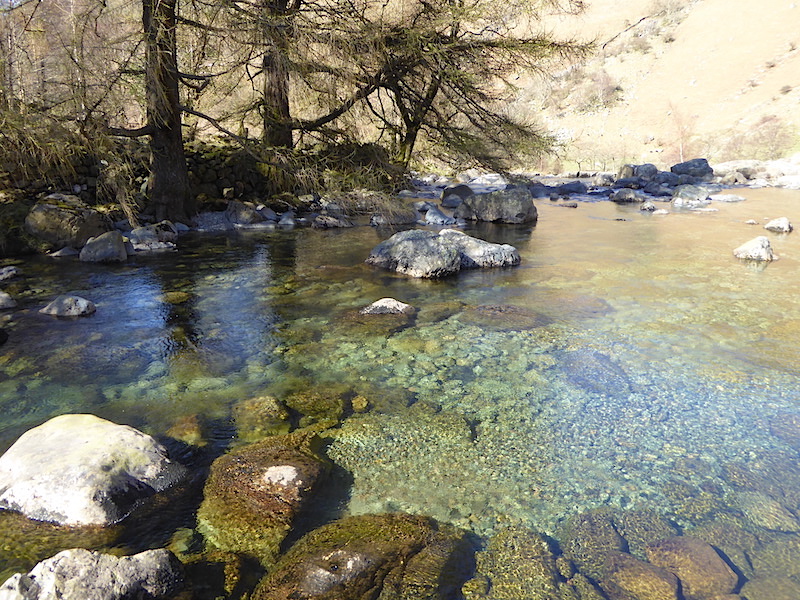
The crystal clear water of Langstrath beck looking very inviting, but it was very, very cold.

Further down the beck has to drop down from the flatness of Langstrath to the flatness of Stonethwaite. The drop starts here at Galleny Force.

Looking upstream at Galleny Force …..

….. and looking downstream.

Crossing the bridge takes us out of Langstrath and over on to the Greenup Gill path, from here we return to Stonethwaite using the path we started out on this morning.

Memorial plaque on the bridge.

From the bridge you can see where the two becks meet, Langstrath Beck on the left, Greenup Gill on the right. Once joined it becomes Stonethwaite Beck. The second sheepfold we passed this morning is over on the right hand side.

Eagle Crag and Sergeant’s Crag across Stonethwaite Beck …..

….. and ahead of us is Stonethwaite and our journey’s end. The sun shone all day so this morning’s snow has melted away, the grass is beginning to grow again, and the trees and hedges are in bud, waiting for a little bit more warm weather before bursting open and bringing some fresh greenery to the landscape, and to eyes which are just getting a little weary of seeing winter brown.



